Holi-daze: Winter quarter arriving early
By Kiersten Riedford News EditorMany students don’t assume their New Year’s Day activities will consist of either a plane ride or a road trip, but this year it will be an unfortunate reality for many DePaul students.
The winter quarter will begin on Monday, Jan. 2, 2023. It is a national ob servance day for New Year’s Day because New Year’s Day falls on a Sunday, but De Paul will have school and regular office hours regardless.

On-campus residence halls will open for move-in on Jan. 1, 2023. Housing pus student workers, are required to be back on campus by Dec. 31, 2022. Many stu dent workers have been told by their de partments that if they choose to not return to campus by Dec. 31, they will be fired.
Every few years, depending on the days of the week holidays fall on, the Of fice of Academic Affairs, the University Registrar and Faculty Council has to make the decision of whether they want to cut spring break short or cut winter break short to ensure that each quarter includes the full 10 weeks of instruction, according to Kristin Matthews, a representative for DePaul University. While there are nu merous administrative and faculty mem bers choosing the beginning and ending dates of each academic quarter, Student Government Association (SGA) is not al lowed to be included in these discussions when they are allowed to partake in dis cussions such as hiring university leaders and waiving final exams when a pandemic hits.
“This year, the choices were to start winter quarter on Jan. 2, or remove a day from spring break. Neither of these op tions was ideal,” a press release from the Office of Academic Affairs said. “Academ ic Affairs, University Registrar and Facul
By Lilly Keller Arts & Life EditorBefore skyscrapers could challenge the laws of gravity and gospel sung, marshy wetlands and tangled thickets defined America’s third-largest city. Occupied by the Ojibwe, Odawa and Potawatomi Na tions, these Indigenous tribes maintained, cultivated, and exalted the land for over 20,000 years before colonization.
Presently, Chicago, a name derived from the Algonquian word “Checagou,” inhabits the ancestral land of more than 10 Indigenous tribes and maintains the third-largest native population in the Unit ed States, with 65,000 inhabitants from over 175 tribes.
Since 2021, Indigenous People’s Day has been a nationally recognized observa tion, acknowledging the resilience and op pression Native Americans have endured at the hands of colonization.
DePaul’s second annual celebration, hosted by the Office of Multicultural Stu dent Success (OMSS) in the Student Cen ter, highlighted three Indigenous perfor
mance groups: Halau i Ka Pono, Danza Azteca Xochitl-Quetzal and Ayodele Drum & Dance, each illustrating the preservation of culture through movement and rhythm.
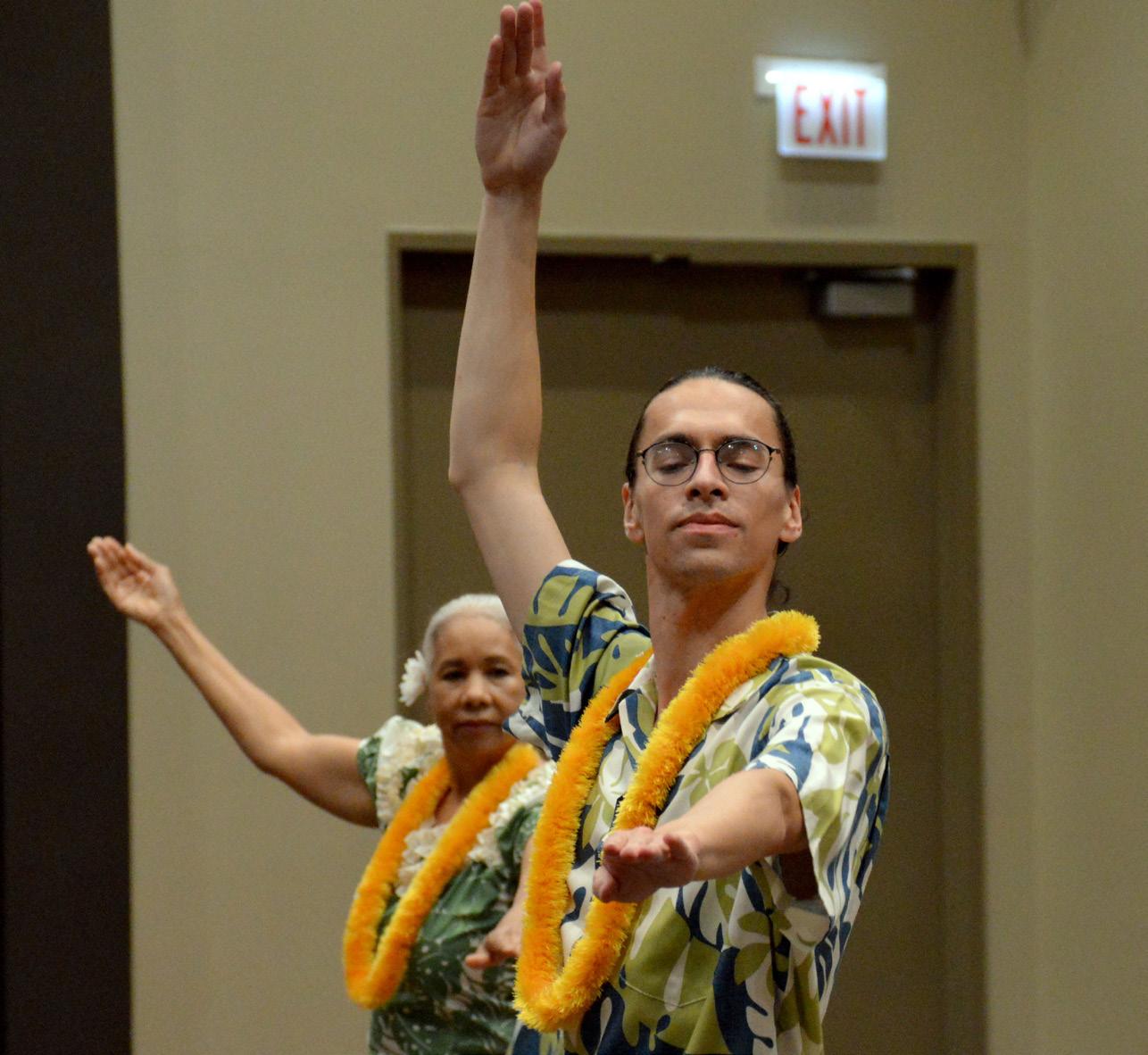
Gustavo Licón, assistant director of OMSS, explained the importance of rec ognizing native individuals’ hardships and their lives and continuing cultural impact.
“A lot of people are not aware of Indige nous People’s Day because it has tradition ally been Columbus Day and you know as people of marginalized identities, we decided throughout the world that its im portant to actually honor the people who went through the hardships of colonization and genocide and of cultural imperialism,” said Licón.
In recognition of DePaul’s occupation of stolen land Licón, unveiled the Universi ty’s land acknowledgment. The formal dec laration identifies Indigenous peoples as the rightful stewards of the land and their relationship with their established territo ries.
“We share DePaul University’s land
Office of Academic Affairs said. “Academ ic Affairs, University Registrar and Facul ty Council, which votes to accept the cal endar, agreed in 2019 that starting Winter Quarter on Jan. 2, 2023, was the better option for the 2022-23 academic year.”
Ann Mathew, a DePaul freshman who lives on-campus, said she would rather the school give the DePaul community the day off on Jan. 2 then begin school on Wednesday, Jan. 4, 2023, like how the university began the fall quarter on a Wednesday.
“I am not happy,” Mathew said. “Al though we get all of December off, Jan. 1 is still a holiday and we should be getting off for that. I’m going to have to move back into the dorms
Performers from the Halau i Ka Pono school demonstrate a modern form of hula at the Indigenouse People’s Day celebration at the DePaul Student Center. MARYFirst Look
CAMPUS CRIME REPORT
The DePaulia is the official student-run newspaper of DePaul University and may not necessarily reflect the views of college administrators, faculty or staff.

EDITOR-IN-CHIEF | Erik Uebelacker eic@depauliaonline.com
PRINT MANAGING | Nadia Carolina Hernandez managing@depauliaonline.com
ONLINE MANAGING | Patrick Sloan-Turner online@depauliaonline.com
MULTIMEDIA MANAGING | Amber Stoutenborough multimedia@depauliaonline.com
NEWS EDITOR | Kiersten Riedford news@depauliaonline.com
ASST. NEWS EDITOR | Vanessa Lopez news@depauliaonline.com
NATION & WORLD EDITOR | Ruchi Nawathe nation@depauliaonline.com
OPINIONS EDITOR | Samantha Moilanen opinion@depauliaonline.com
FOCUS EDITOR | Una Cleary focus@depauliaonline.com
ARTS & LIFE EDITOR | Lilly Keller artslife@depauliaonline.com
ASST. ARTS & LIFE EDITOR | Jonah Weber artslife@depauliaonline.com

SPORTS EDITOR | Tom Gorski sports@depauliaonline.com
ASST. SPORTS EDITOR | Preston Zbroszczyk sports@depauliaonline.com
ART EDITOR | Alicia Goluszka art@depauliaonline.com
ASST. ART EDITOR | Maya Oclassen art@depauliaonline.com
PHOTO EDITOR | Quentin Blais photo@depauliaonline.com
ASST. PHOTO EDITOR | Erin Henze photo@depauliaonline.com
COPY EDITORS | Amber Corkey | Kara Zubo copydesk@depauliaonline.com
SOCIAL MEDIA EDITOR | Lily Lowndes social@depauliaonline.com
ADVISOR | Marla Krause mkrause1@depaul.edu
LINCOLN PARK CAMPUS
Drug
Lincoln Park Campus Crimes: Sept. 28
1) A Harassment report was filed regarding an incident that took place on the 1200 W block of Fullerton.
2) A Disturbance report was filed in the Schmitt Academic Center. Sept. 30
3) A Criminal Damage report was filed regarding damage to personal belongings in a room in University Hall.
4) A Retail Theft and Criminal
Trespass report was filed in the Student Center. Chicago Police took the person into custody. Oct. 1
5) A Harassment report was filed for a person being harassed on the 900 W block of Webster. Oct. 3


6) A Harassment by Electronics means report was filed for a person receiving unwanted e-mails and texts.
7) A Theft report was filed for
a phone taken from the Ray Meyer Fitness Center.
8) A Criminal Trespass report was filed for a person causing a disturbance in the Ray Meyer Fitness Center. Oct. 4
9) A Hit & Run was reported on the 2300 N block of Kenmore.
10) A Burglary report was filed regarding an item taken from Belden-Racine Hall sometime between Sept. 29 and Oct. 4.
LOOP CAMPUS
Loop Campus Crimes: Sept. 29
1) A Disturbance was reported in the DePaul Center. Oct. 3
2) A Criminal Trespass report was filed for a person asked to leave the Dunkin Donuts in DePaul Center.
CORRECTION: The original version of last week’s article “University health service considers using neuroanatomist’s brain trauma research” was published with an incorrect headline, suggesting the event was sponsored not by DePaul Health, but by University Health Services. It has since been corrected online.
FOLLOW US:




twitter.com/TheDePaulia
La DePaulia es
no
JEFA DE REDACCIÓN | Jacqueline Cardenas eicladepaulia@depauliaonline.com
GERENTE EDITORIAL | Santiago PosadaJaramillo managingladepaulia@depauliaonline.com
EDITORA DE OPINIONES, ARTE Y VIDA | Andrea Juárez Hernández opinionesladepaulia@depauliaonline.com
EDITOR DE MULTIMEDIA | Frankie Perez multimedialadepaulia@depauliaonline.com
PRODUCTOR DE PODCASTS | Geovani Camarena gcamare3@depaul.edu
EDITOR DE COPIA | Rodrigo Melgarejo a20181375@pucp.edu.pe
EDITOR DE DEPORTES | Santiago Gonzalez Tijerina sagotijerina@gmail.com
CONTACT US:
GENERAL PHONE (773) 325-2285
OFFICE HOURS
Friday: 10 a.m. to 5 p.m. Sunday: 10 a.m. to 5 p.m.
ADVERTISING business@depauliaonline.com
NEWS TIPS news@depauliaonline.com
ADVERTISING business@depauliaonline.com
DePaul student apologizes for homeless publicity stunt
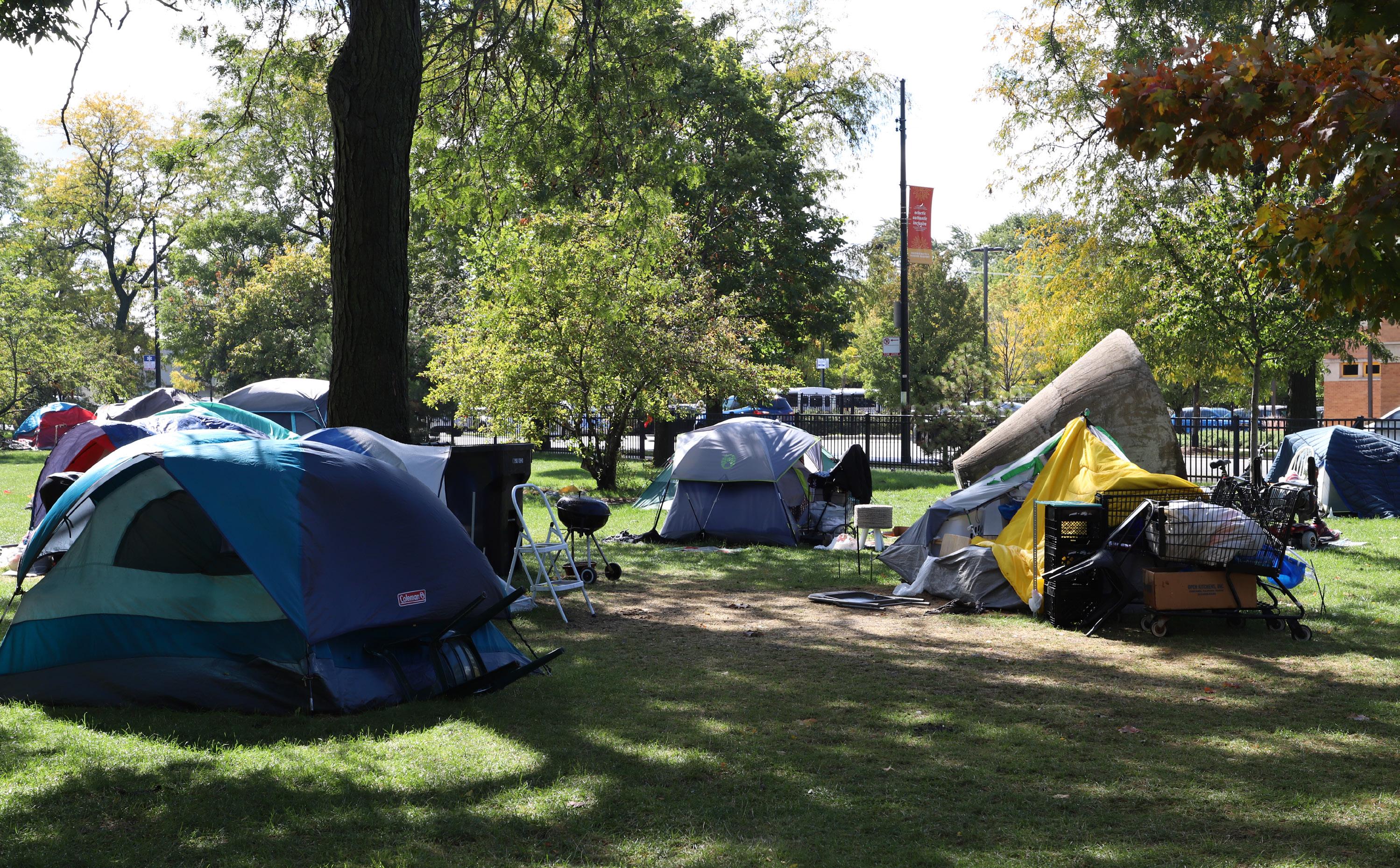 By Kiersten Riedford News Editor
By Kiersten Riedford News Editor
Sarah Lim, 17-year-old DePaul fresh man, expressed some regret for her homeless publicity stunt last week.
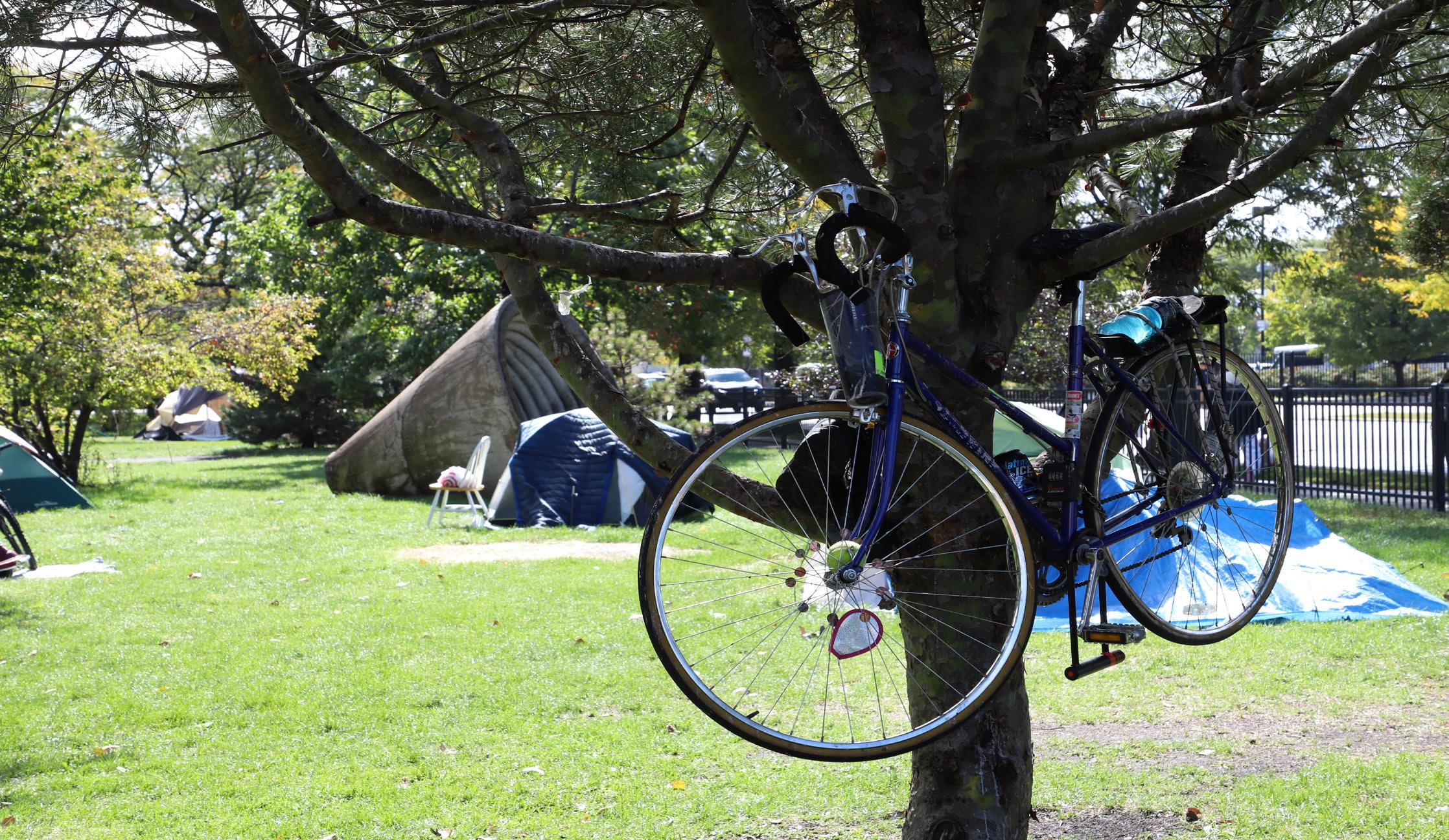
In a one-on-one interview with The DePaulia, Lim described her actions as inappropriate.
“After doing it, I realized that it was pretty tasteless,” she said. “A lot of people didn’t like it.”
Lim hung up flyers in Touhy Park, a homeless encampment in Rogers Park, saying the residents would be moved to one of the most high-end hotels in Chi cago until they secured housing. On the flyers Lim used 49th Ald. Maria Hadden’s name along with Bill Morton, president of the Rogers Park Chamber of Com merce, who is also running for 49th ward alderman, and Trudy Leong, a Chamber of Commerce staff member.
Hadden, Morton and Leong con firmed to Chicago Tribune and Block Club Chicago last week that they were not involved with the stunt.
“I was pretty — I don’t use this word very frequently — flabbergasted,” Hadden said. “It’s not a good feeling to be a pub lic official and have somebody take your name and make kind of realistic-looking legal documents and use them.”
Hadden was concerned about the stunt taking advantage of the resident’s vulnerability.
“We’ve been working with [the Touhy residents] for a long time and finding housing accommodations,” Hadden said. “I had concerns about that. I felt angry and just felt a bit shocked.”
Lim contacted Morton via Facebook the week prior to putting up the flyers to ask him to help her develop petitions so she could get the signatures she needed to run for mayor, according to the Chi cago Tribune.
She said during the interview that she was sorry for the harm she caused the Touhy Park residents; however, has not yet gone in person to apologize to the people in Touhy Park, but did send someone she works with to give the res
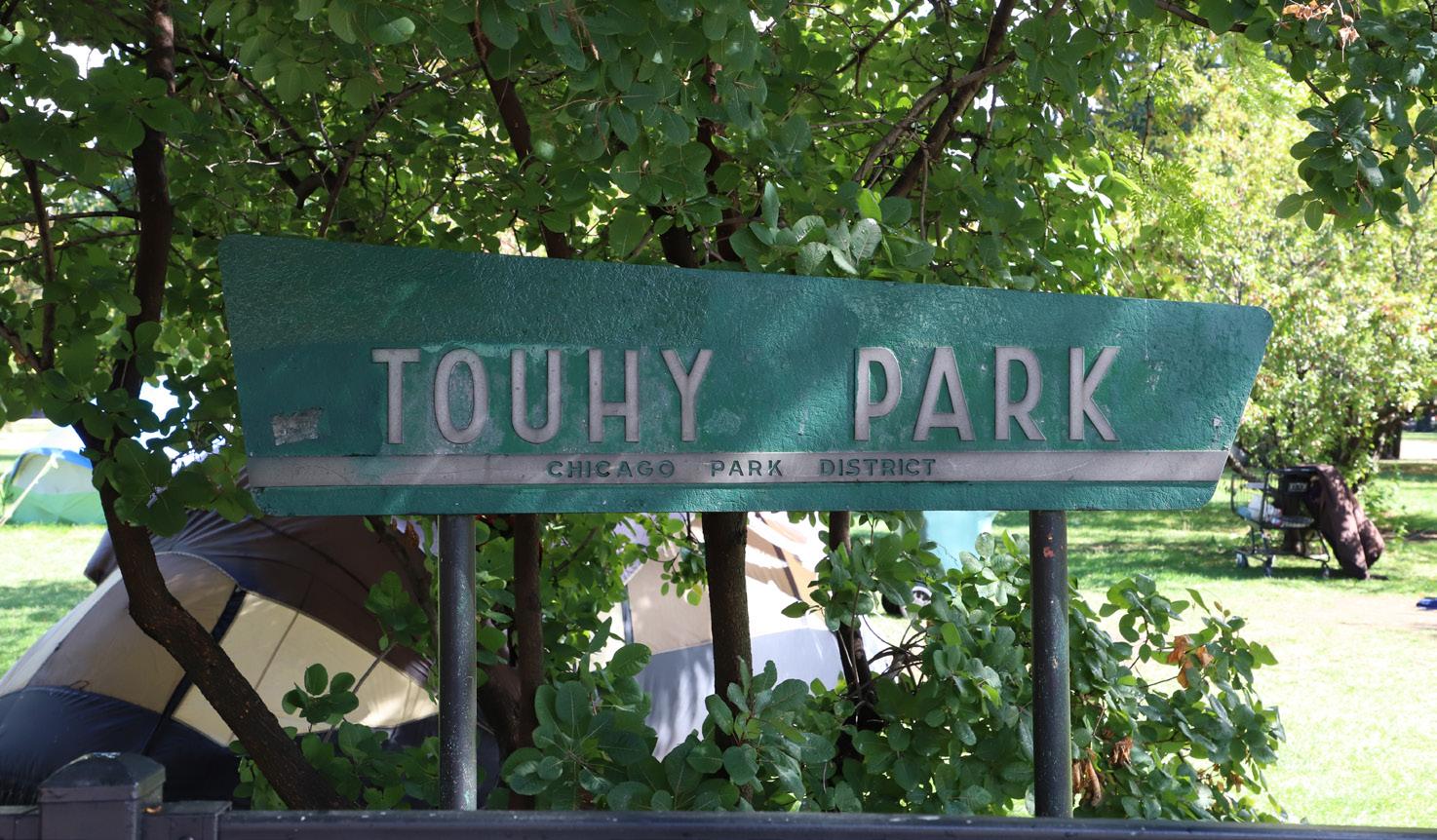
idents food.
“I’m still 17,” Lim said. “It might be kind of dangerous for me to go down there considering what I did.”
While the publicity stunt was more harmful than she anticipated, Lim said she still achieved her goal of gaining rec ognition from Chicago news outlets.
“I don’t think I’m proud of what I did,” Lim said. “I’m proud of how I was able to land in the Tribune as a 17-yearold. I think that’s very good. But I don’t think the way I did it was that good.”
Lim, who turns 18 in late October, said she still plans to run for mayor as a Republican candidate. Her next steps are to receive the petition forms so she can get on the ballot for the upcoming elec tion in February 2023.
She said that because she is facing known candidates like current Chicago Mayor Lori Lightfoot, Ald. Raymond Lo pez, Willie Wilson and Rep. Kam Buck ner, she does not intend to win. Instead,
Lim is simply wanting to test the waters of running for an elected official position.
“I think an 18-year-old running for mayor is something really rare,” Lim
said. “So I think it would just be some thing to do to just be remembered.”
Students say school cannot be full-time job
By Zach Elliott Contributing WriterCollege students value many things, whether it is grades, money or time; however, for employed students, all are important, but none are guaranteed.
Working while enrolled in college places restrictions on students across the country, and the rising cost of tuition is leading to more employed students.
According to the National Center for Ed ucation Statistics, 40% of all full-time (12+ credit hours) undergraduate students were actively employed in 2020. Additionally, ac cording to the American Association of Uni versity Women (AAUW), the cost of a college education has risen by 103% since 1987.
Even with a sincere commitment to edu cation, working students’ financial and time resources remain limited.
“The students I have worked with who work full-time and part-time are some of my most motivated, hard-working, committed students,” said DePaul clinical economics professor Thomas Walker.
President Joe Biden’s recent student loan forgiveness proposal helps reduce students’ need to work, but it does not address the fun damental issue of how expensive college can be.
As per the Urban Institute, 30 to 40% of undergraduate students take out loans each year. 70% of bachelor’s degree recipients will have some form of educational debt by the time they graduate.
So, what can students do to stay in the classroom without breaking the bank? The standard response is federal financial assis tance.
“We use the results of the FAFSA to deter mine a student’s eligibility,” said assistant VP of DePaul Financial Aid Karen LeVeque-Sza wara. “Some factors that may influence the results include family size, number of family members in college, and student and family income.”
The Free Application for Federal Student Aid (FAFSA) determines how much federal financial aid a student receives, but it is not a complete solution. Without always weighing economic factors properly, some students can be left out in the cold.
“We encourage students to appeal if their circumstances have changed or the re sults of the FAFSA do not accurately reflect a student/family’s current financial circum stances that may impede their ability to pay,” LeVeque-Szawara said.
In the Department of Education’s online FAFSA explanation, there is a sub-section ti tled “What is included in the cost of college?” There are traditional expenses: tuition, room and board, school supplies, and so on. Addi tionally, they include suggestions on how to get the colleges themselves to reduce tuition for personal reasons, such as being an older student, bring your family’s main wage earn er.
Also included is a bullet point that simply reads: “You can work part-time to pay part of your costs. Be sure your work and school schedules don’t conflict and that you have enough time for studying,” followed by sug gestions for obtaining employment.
Summing it up, outside of tips to pursue reduced tuition and short bullet points on finding a job, federal financial aid provides little additional leeway for working students.
“Other than housing – I live with my grandfather – I pay for everything,” DePaul junior Yazen
Barakat said. “School is the biggest factor. Since I’ve been working since I got out of high school, financial aid has finally caught up with me and they don’t give me much mon ey. School is really the reason I’m working so many hours.”
Beyond scraping together the funds to pay for courses, balancing classwork can be another trial for working students. Para phrasing the Department of Education’s defi nition of a credit hour, students are expected to have at least one hour of in-class study each week and at least two hours outside of the classroom for each credit hour taken.
A “full-time” student at DePaul, for ex ample, needs a minimum of 12 credit-hours to qualify as full-time. Using the DOE’s defi nition, that student is expected to spend 12 hours in class – alongside 24 outside of it – on their studies.
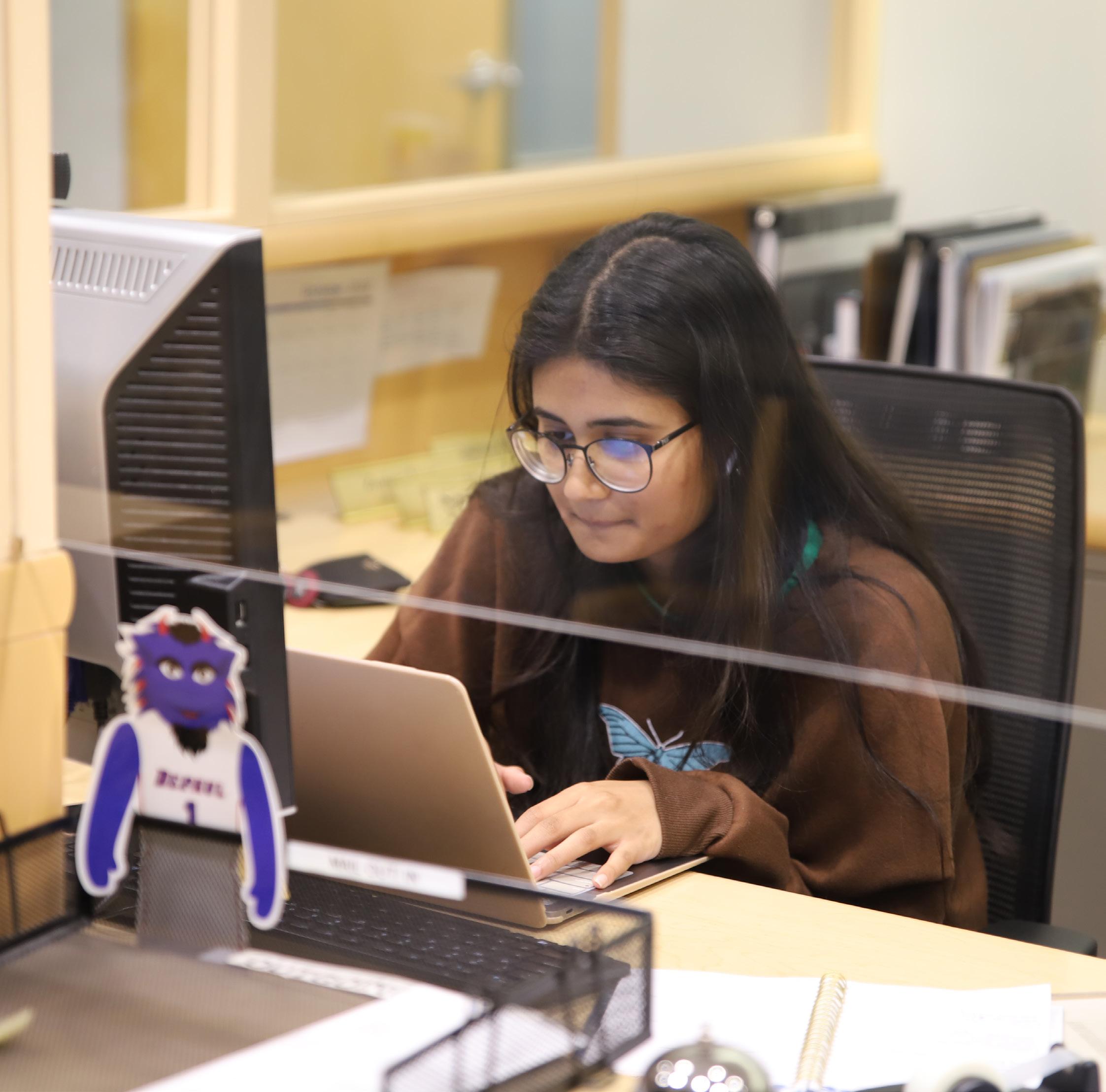
Now, while the validity of those expecta tions, particularly outside of class, is debat able, those 24 hours outside of class could amount to an unaffordable amount of lost income for working students.
As countless students have demonstrat ed, however, the high-wire act of work and school can be completed, and it doesn’t have to be alone.
“I want to see all my students succeed, even when it’s difficult and demanding to get to that finish line,” Walker said.
At DePaul specifically, for example, the Dean of Students office offers an emergency fund available for students facing non-tuition related crises. If those crises threaten a stu dent’s ability to finish their studies, they may be eligible to receive a portion by applying.
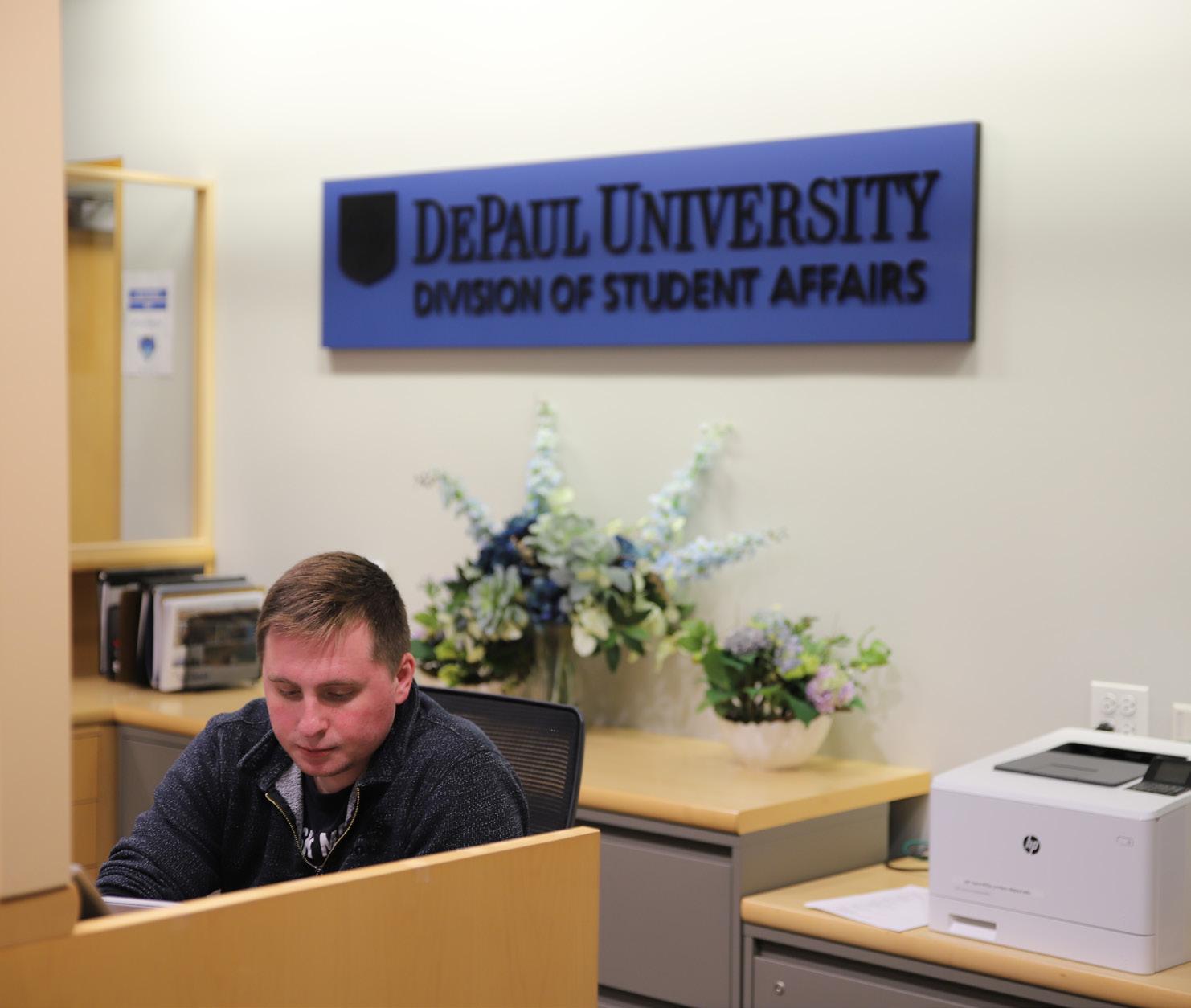
“Not all of those [who apply] will neces sarily get approved, but that might be how many students we connect with on the fund ing,” Assistant Dean of Students Dan Amato said. “If a student is not approved, that does not mean we do not help them, but we are
often able to try and help in other ways de pending on the situation.”
Some students must work, not despite their education, but for the sake of it. It is commonly said that school is a full-time job. When a student needs to manage another, it comes down to the university and that stu dent to make a college education possible.
“Instructors are people too,” Walker said.
“We understand that life gets in the way sometimes, so always stay in communica tion.”
“I want to see all my students succeed, even when it’s difficult and demanding to get to that finish line.”
Thomas Walker DePaul clinical economics professor
New nursing scholarship funded by $2 million gift
By Erik Uebelacker Editor-in-ChiefAlumna Susan Hadam Schoenholz and her husband David A. Schoenholz announced a $2 million gift to DePaul last week to support scholarships for School of Nursing students.
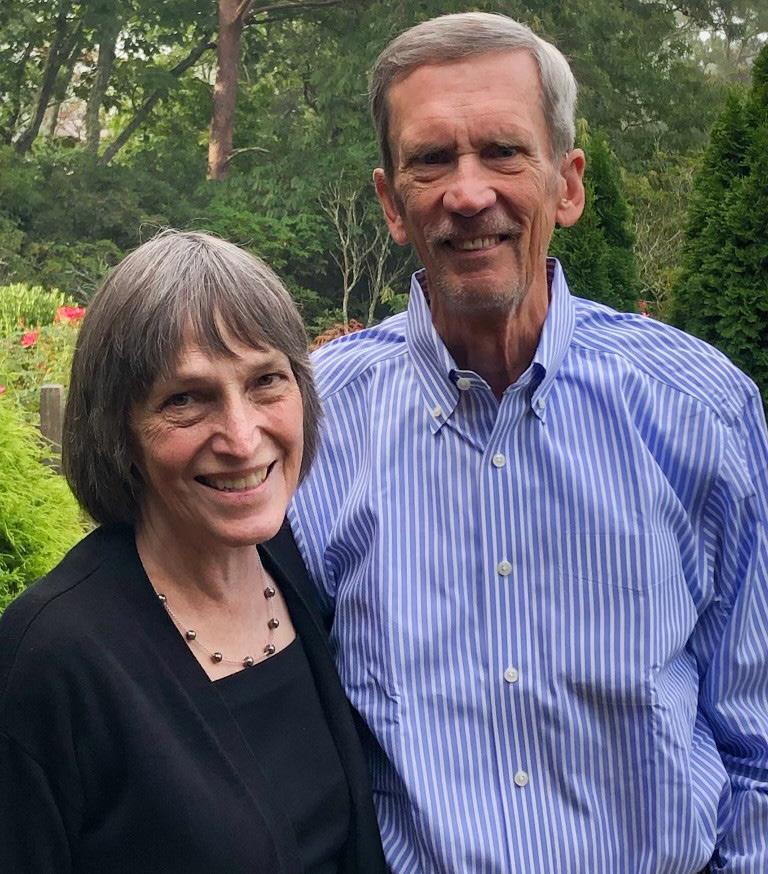
The couple’s legacy gift through their estate plan will establish the Susan Ha dam and David A. Schoenholz Endowed Scholarship in Nursing, which will give recognition and financial assistance to DePaul students enrolled in the School of Nursing.
Hadam Schoenholz received her master’s degree in nursing from DePaul and served as a clinical specialist in ed ucation at Harvard Medical School’s Jos lin Diabetes Center, as well as a clinical specialist in diabetes and pregnancy at Northwestern University prior to her re tirement.
David Schoenholz formerly held several executive leadership positions at Household International, now HSBC Holdings and is also currently retired.
“I found DePaul’s nursing educa tion to be outstanding as well as inspir ing,” Hadam Schoenholz told DePaul Newsline. “Compassion, commitment and competence are intrinsic to the pro fession, and DePaul strives to instill all three in its graduates. We are glad for this opportunity to give back and make a difference for students and the people who will benefit from their care when it’s needed more than ever.”
The number of students that will receive this scholarship, as well as how much financial assistance will be pro vided to each, remains unknown.
“The number of scholarships and amount will be determined at a future time,” said Kristin Matthews, spokesper son for the university.
The couple’s donation and the cre ation of this scholarship comes as De Paul relaunched the Bachelor of Science in Nursing program this fall.
Alumni encourage using university resources for better post-grad life
By Jonathan Rosenblum Contributing WriterEvan Peters, DePaul alumnus who graduated in the spring of 2022 with a degree in film and television, said he wasn’t prepared enough for post-grad life.
“I wish I had a better plan,” Peters said, referring to his job search, “I wish I had taken advantage of the resources DePaul has and the connections they have.”
Peters currently works at Sales-i, a sales software company in downtown Chicago. He began his job search in Oc tober 2021, when he was given his first job offer at Coyote Logistics, also locat ed in Chicago.
After quickly accepting the offer, Pe ters soon found that the job was not for him.
“I absolutely hated my life,” Peters said.
Soon after the start of his training at Coyote, Peters began applying for new jobs. Any sales job with “quick apply” on LinkedIn, Peters applied to. That even tually led him to an interview at Sales-i, which is a much better fit for him he says.
“It worked out for me because I’m lucky,” Peters said, “I said I didn’t need the resources [at DePaul], but then you get out here and you’re like, I don’t have access to that anymore and that would be very helpful.”
As many students begin their last quarters at DePaul, the upcoming search for employment looms closer and closer. Students wishing to gain employment upon graduation face several hard-hit ting questions about the job search:
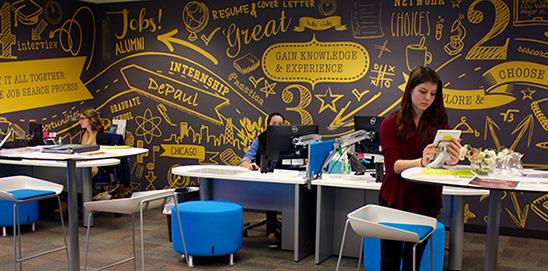
When do I start applying? How can I make myself a good candidate? Is there anyone to help me?
To answer some of these questions, DePaul students can visit the Career Center in SAC Room 192.
“We help students build confidence, explore possibilities, and develop a pow erful personal brand,” said Brenda Wil liams, the Career Center’s managing di rector.
The Center provides, “a variety of services, resources, and programming including career advising, a career li brary, industry networking events, ca reer fairs, career courses, resume & LinkedIn reviews, funding for unpaid internships, a job and internship plat form (Handshake) and alumni-student networking,” Williams said.
Angelina McAdory, a DePaul senior majoring in women’s and gender stud ies, visited the Career Center for resume help, but she was disappointed to be helped by what McAdory saw as not a working professional.
“I didn’t like the help because it seems like just another piece of infor mation that would change depending on the person,” McAdory said, “It felt very opinionated.”
McAdory sought resume help and advice pertaining to her specific liber al arts major, but she was given general, un-nuanced advice.
“A professional or someone with more experience that maybe has a more curated method and strategy because they’ve sent different kinds of people into the workspace with their particular advice,” McAdory said was what brought her to the Career Center.
Despite her less-than-impressed view of the advice she was given, McA
dory has not given up on the Career Center as a resource.
“I’m optimistic about the office,” McAdory said, “I will most likely be visiting that office again to get a feel for what field they see a lot of recent gradu ates going in, especially ones with a lib eral arts background.”
McAdory said she plans to start ap plying to jobs in the spring.
As students begin to think about post-college, many question when the right time to start applying is. Students often get one different answer after an other.
“It all depends on the industry path students choose,” Williams said. “What I recommend is that students start as ear ly as possible exploring career options and the relevant timelines and tactics for acquiring a job in that field.”
“For full-time jobs, if you’re gradu ating in June, I think it’s a good idea to start getting your feelers out in the win ter, maybe networking to some compa nies, But [definitely] by March to really start getting applications out there,” said Michael Elias, College of Communica tions internship program director.
Lawrence Kreymer, who graduated from DePaul in the spring of 2022 with a degree in journalism, feels he did not start his search soon enough.
“I could have been more proactive and less lazy with it,” Kreymer said. “I definitely could have started looking
way sooner than I did.”
Kreymer has yet to find employment in the field of journalism and currently works at his dad’s restaurant in Chicago.
“I thought with my resume and all the things I accomplished at DePaul, there was no way I was going to go this long without getting an offer or getting a job, but that’s the reality of it,” Kreymer said.
Despite Kreymer’s strong resume, which includes his position as the edi tor-in-chief of The DePaulia, he did not have any internships during his time at DePaul. Along with being proactive in beginning the job search, Elias sees in ternships as another crucial component in finding employment.
“It’s consistently reported that appli cants who have internship experience on their resume when they apply to fulltime jobs, ideally two internships under their belt, have a great chance of pro gressing through the interview stage,” Elias said.
Along with bolstering resumes, in ternships can provide a student with crucial experience to better understand where they want to go after college. Elias feels internships are great in helping students get an understanding of what they like and what they don’t like.
“I think there’s value in figuring out even what you don’t like,” Elias said.
Protesters line Chicago rights protest, Iranian
 By Una Cleary Focus Editor
By Una Cleary Focus Editor
“It has been 106 days since the Supreme Court reversed 50 years of legal precedent and overturned Roe vs. Wade,” Dr. Allsion Cowett, an abortion provider, said. “The results have been devastating.” On Satur day, Oct. 8, the Federal Plaza on Dearborn St. was filled with groups of protesters, ral lying for each other’s causes. They chanted, “What do we want? Freedom for Iran!” and “The people united will never be divided!”
About 2,000 protesters marched in support of the Abortion and Full Repro ductive Rights National Day of Action and for women’s rights in Iran, According to Linda Loew, leading member of Chicago for Abortion Rights, a co-sponser for the event.
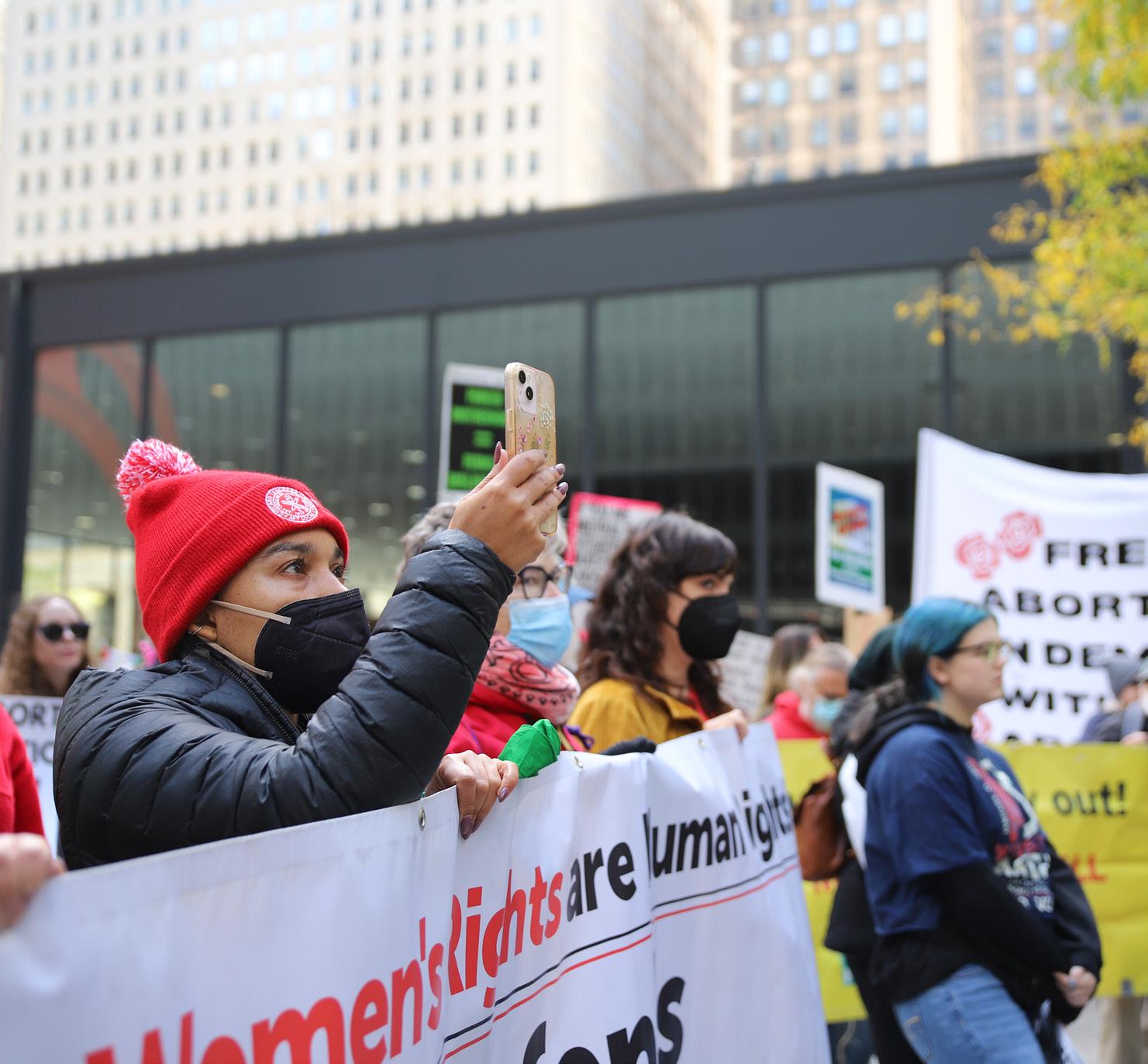
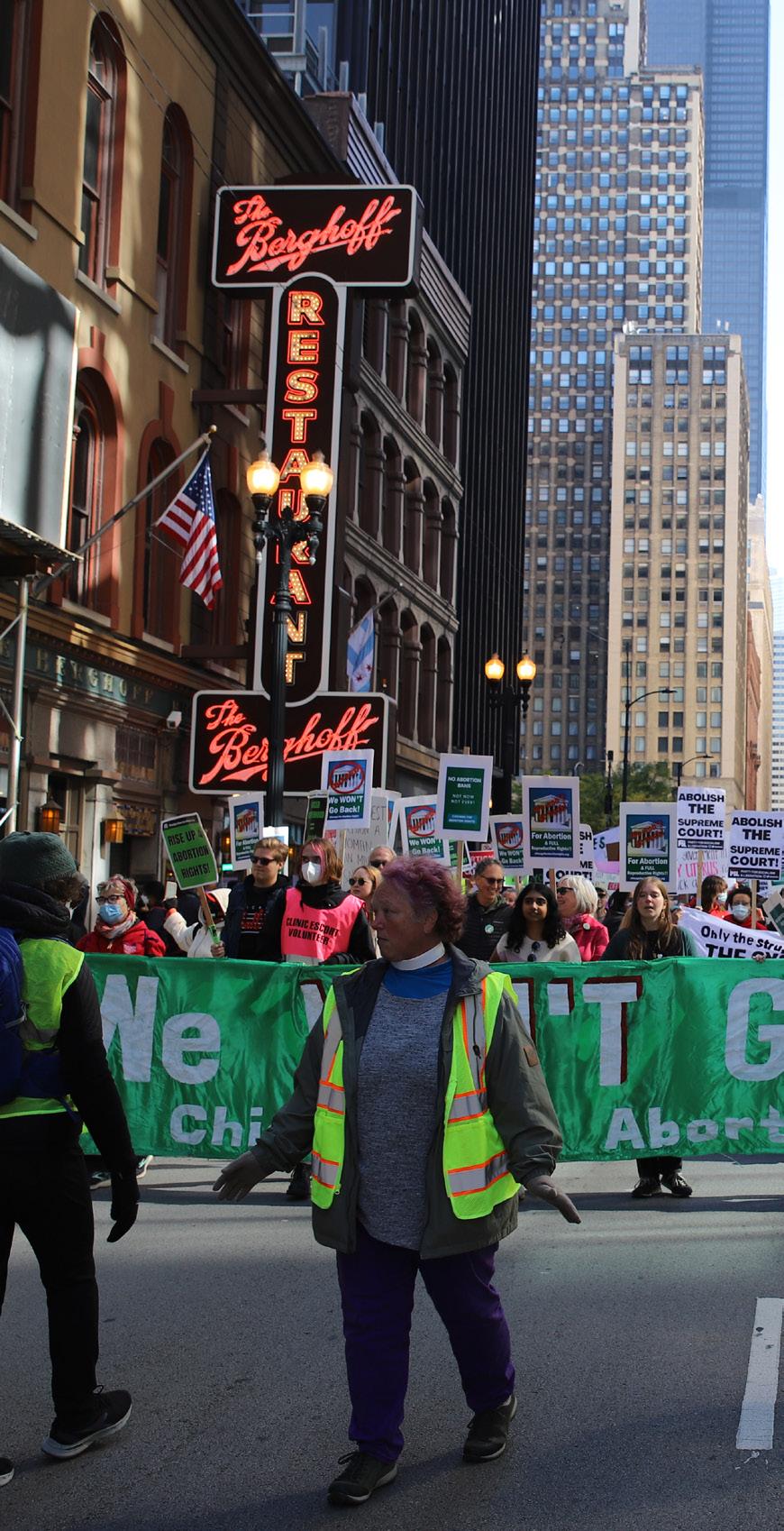

“I feel like these two fights are in the same line,” protester Hasti Sharifi said while holding up a sign reading the Iranian women’s rights movement motto: ‘Wom en, Life, Freedom.’ “You’re fighting for abortion rights, we’re fighting for women’s rights and they’re all women’s rights. It’s human rights.”
Over 46 organizations around Illinois and Chicago co-sponsored the protest such as Chicago Abortion Fund and Chicago Teachers Union. Several guest speakers shared their experiences and expertise on both causes. Many also called for urgency to take action in light of the midterm elec tions approaching.
“Voting is the very least you can do,” said Chicago for Abortion Rights member Mandly Medly. “You need to organize in your communities. You need to be in the streets. You need to hold those politicians accountable. The only way we’re going to ensure abortion rights is if the people de mand it, not the politicians.”
Darren Bailey, Republican candidate for Illinois governor, is a concerning can
didate for many of the protestors. Bailey has said on numerous occasions his opposition to abortion rights, including in reporting done by CBS Chicago.
Bailey has said he opposes abortions even for cases regarding rape or incest. He said the only exception under which he would allow abortions is to protect the life of the mother.
Recently Bailey has been under fire for a video posted on his Facebook in 2017.
“I believe that abortion is one of the greatest atrocities of our day and I believe it’s one of the greatest atrocities probably forev er,” Bailey said in the video. “The attempted extermination of the Jews of World War II doesn’t even compare on a shadow of the life that has been lost with abortion since its le galization.”
However, many Chicagoans are not wor ried about the turnover of Roe v. Wade im pacting Chicago because of the promise Gov. Pritzker said at the beginning of his campaign. Pritzker said that, if re-elected, he would protect abortion rights in Illinois.
As of Sept. 29, a recent poll from The WCIA, The Hill, and Emerson College shows Pritzker has a 15-point lead over Bailey in the governor’s race.
“Anyone who is in Illinois who lives in district two or three for judicially must vote for the Supreme Court justices that are run ning and know who they’re running for,” President of the National Council of Jew ish Woman Chicago (NCJW Chicago) Jane Swartz said. “The freedoms we enjoy in Illi nois can change in a flash depending on who we vote for.”
Many of the speakers during the rally spoke about the influx of out-of-state pa tients coming to Illinois to seek abortions.
“Conditions for pregnant people have become even more dangerous,” Cowett said in her speech.
“I met a college student who came for a clinic from Alabama. She had mis takenly visited a fake clinic, a crisis pregnan cy center where she had been lied to about
Chicago streets for abortion Iranian women’s rights
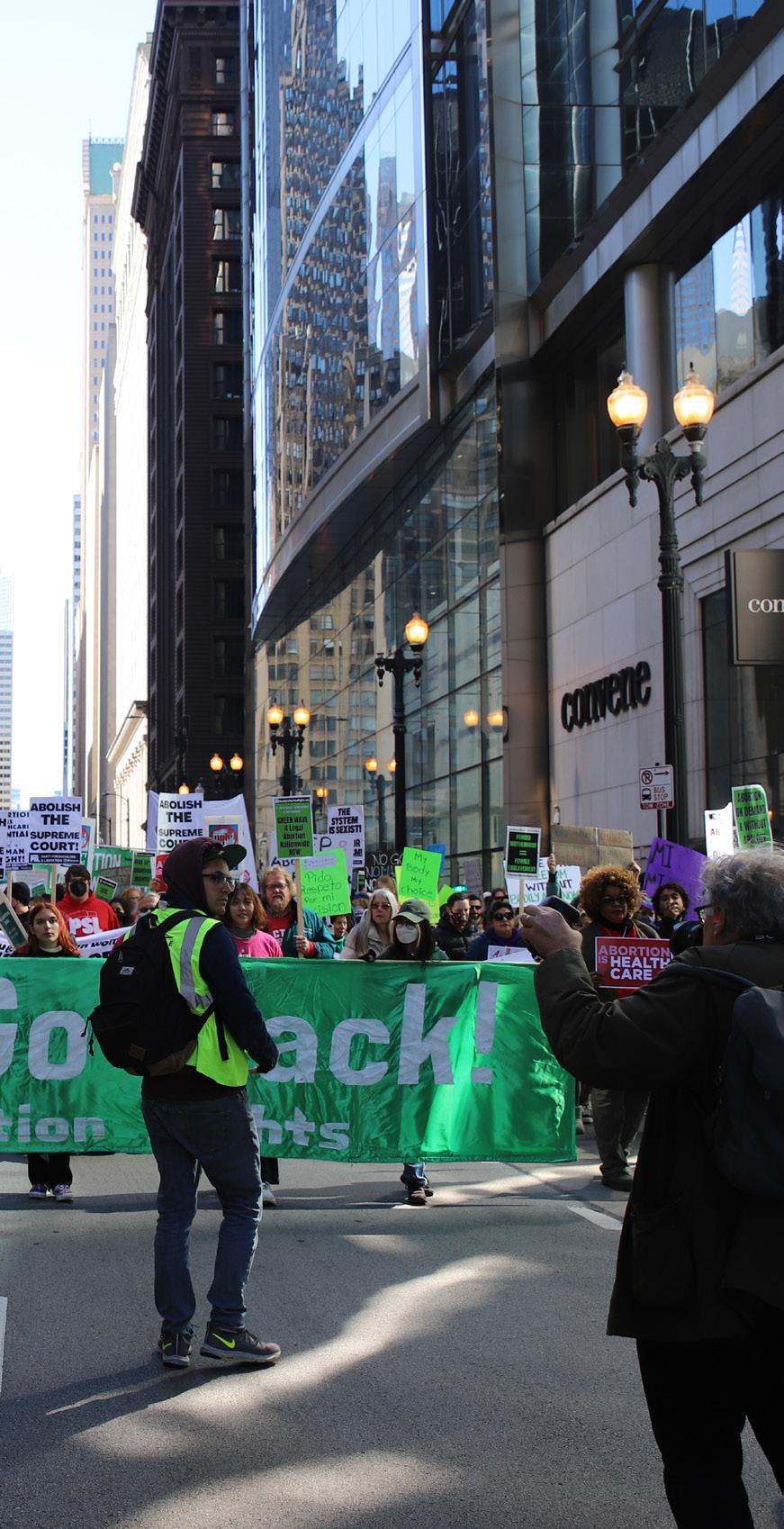
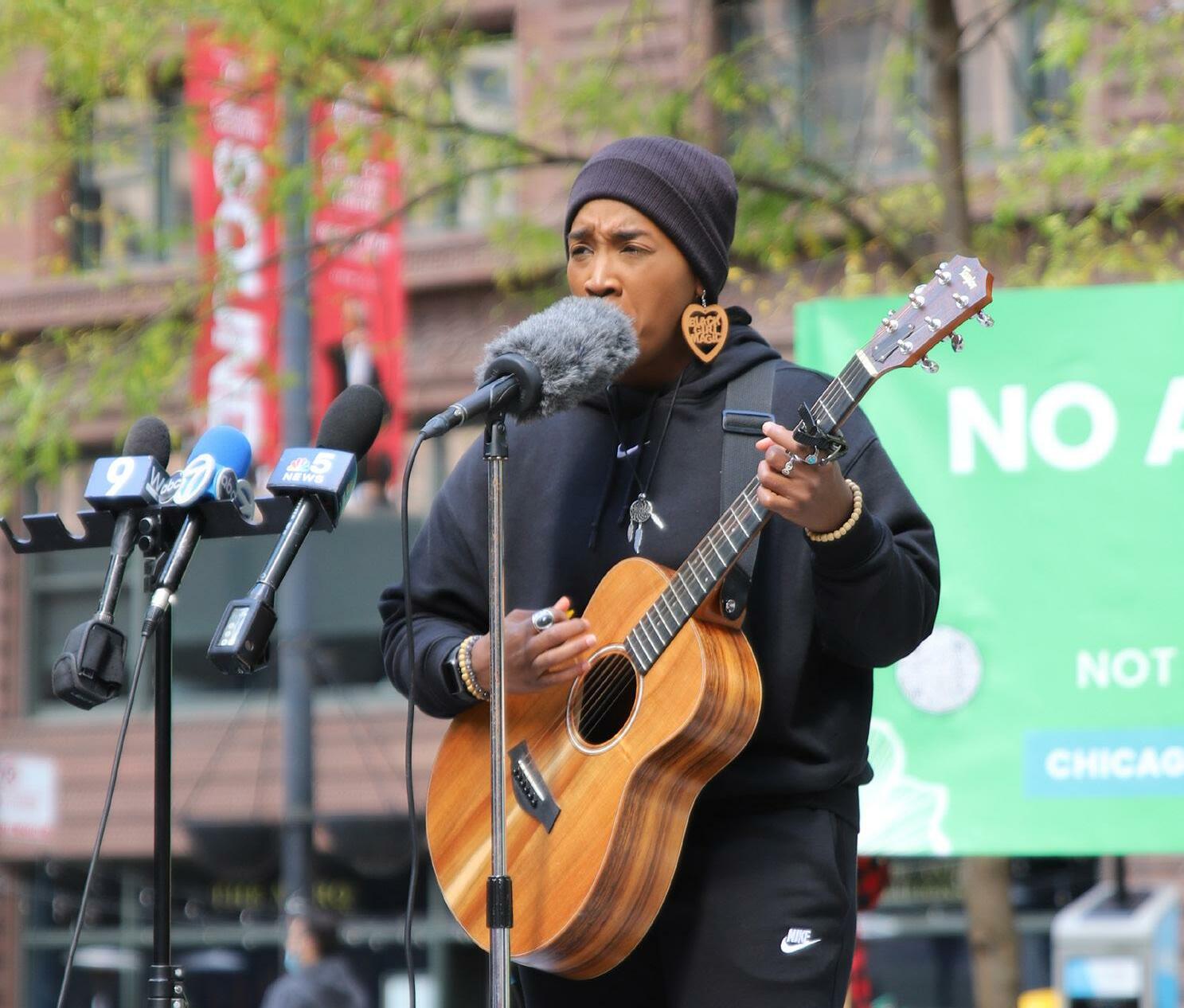
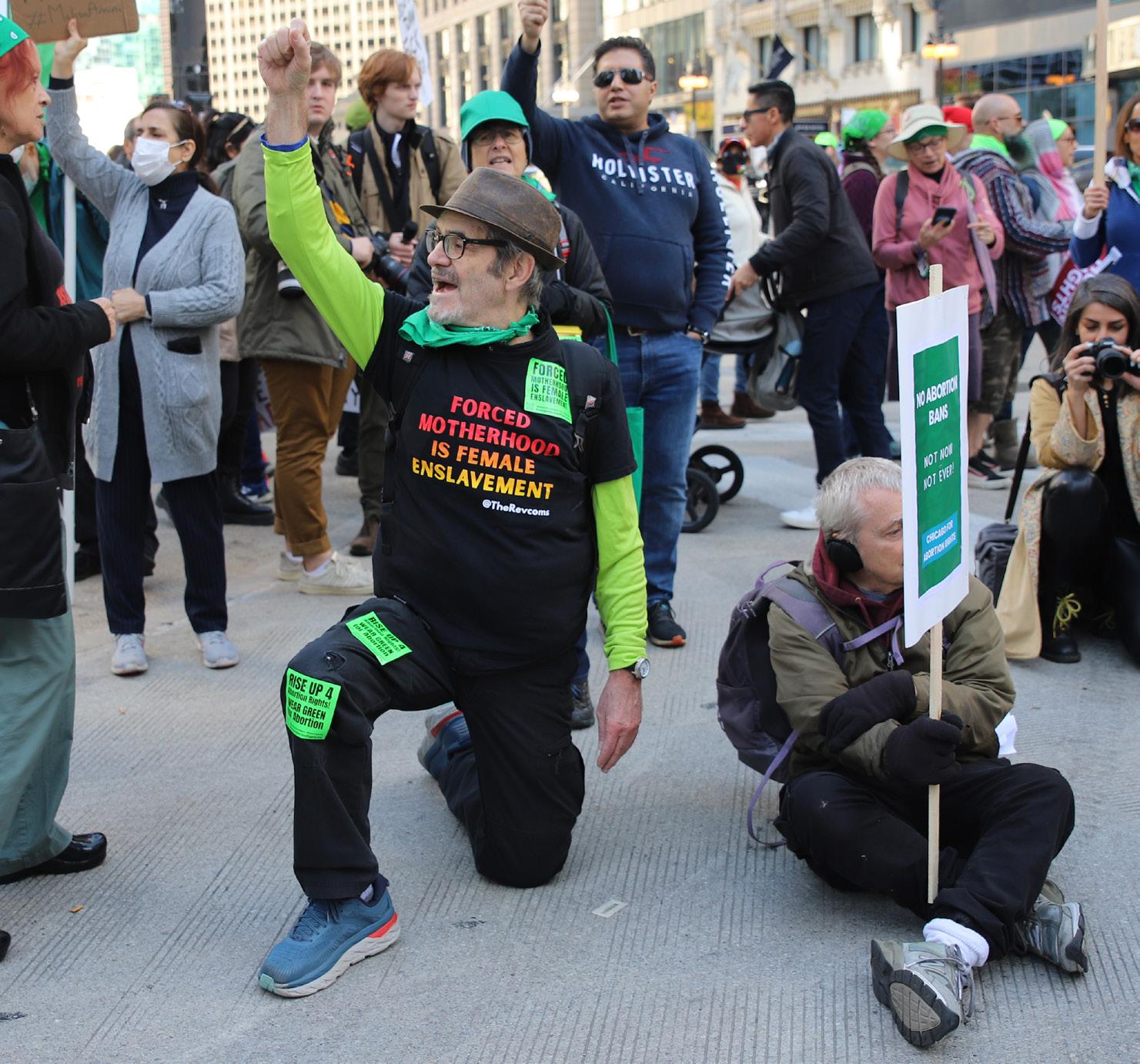
the dangers of abortion. She told me she was worried that we would sedate her for the abortion and tie her tubes and make her infertile.”
Before Roe was overturned, Planned Parenthood of Illinois provided abortions to roughly 100 out-of-state patients per month. In July, the first full month af ter the ruling, the number of out-of-state abortion patients increased to more than 800, according to Planned Parenthood of Illinois’ website.
Indiana, a state where the extreme abortion ban has been delayed, still has abortion access but it is unattainable for many.
“About 40% of the people that the Hoo sier Abortion Fund talks to are already to Illinois for their abortion care,” Hoosier Abortion Fund States Programs Manager Jessica Marchbank said. “The night before the Indiana abortion ban took effect, I was amazed chatting with a woman whose sto ries shook me to my core. And with the way the world is today she [told] me, ‘I can’t trust that my life will be put before a fetus.’”
The Latina-led organization Mujeres Latines En Accion came to show solidarity with states like Indiana.
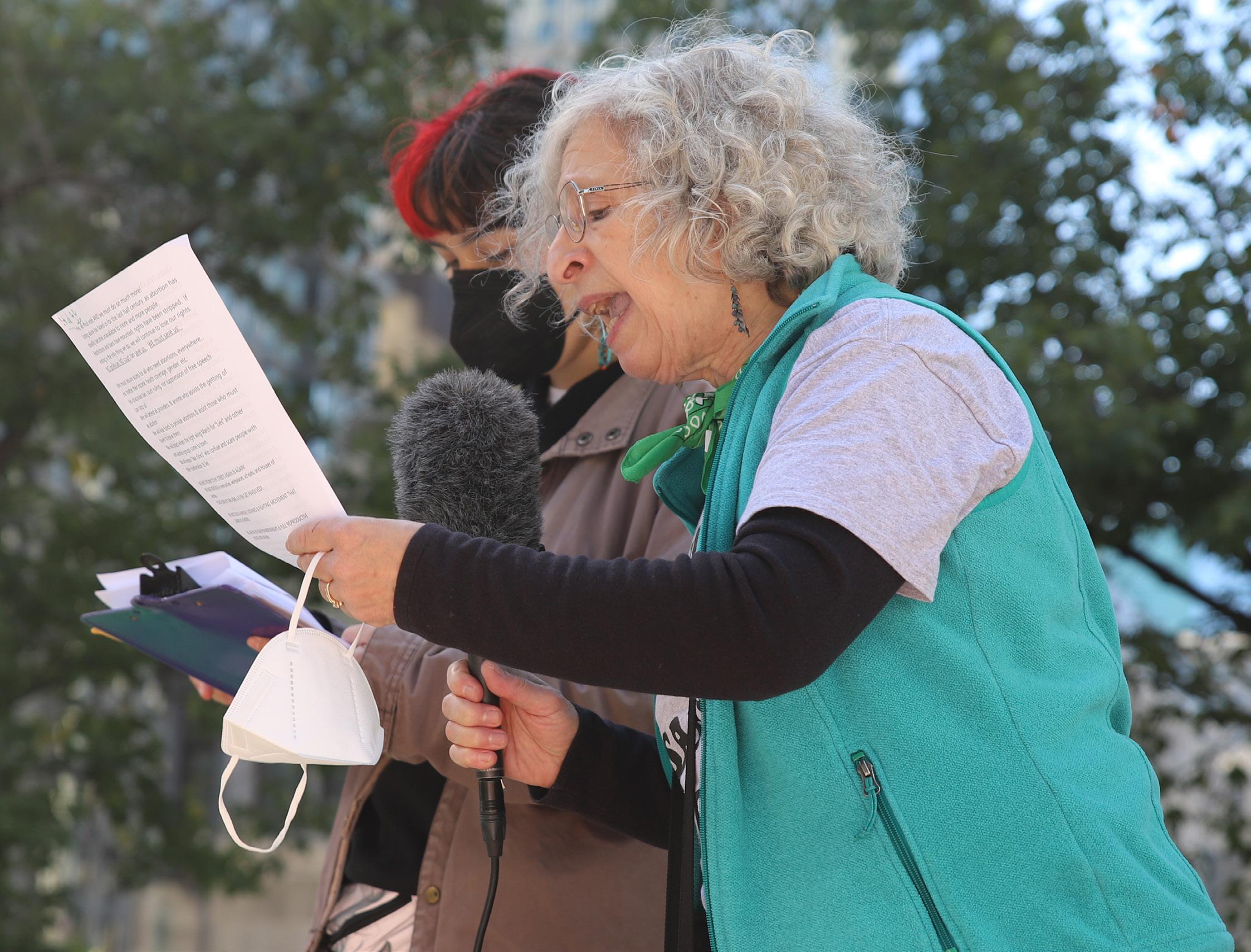
“We are here principally to stand in sol idarity with other states, and to understand that our organization which does work on supporting survivors of domestic violence and sexual abuse, that this also has to do with the right to choose and access to healthcare,” said Member Sayeed Sanchez.
Founded in Pilsen in 1973, Mujeres Latines En Accion is the longest-standing Latina-led organization in the nation. As they come up in their 50th anniversary, they are working right now to help Latina immigrations who are survivors of domes tic violence and sexual abuse.
“Our sort of political statement is that we don’t believe that a person or the state
has the decision to tell someone what to do with their body,” Sanchez said. “This is re ally important because we need to lead leg islation [and] statesmen. Folks, in general, know the power of grassroots-led organi zations and events.”
Newer organizations such as South Side Community Birth Center was a co-sponsor at the event. Lead Steward Jeanine Val rie-Logan spoke on her experience as a midwife.
“My midwifery work has complete ly changed since June 25,” Valrie-Logan said. “Now, I spend more time answering questions about stockpiling medication to prevent force births about long-term con traceptives.”
As abortion disproportionately affects women of color, Valrie-Logan has seen firsthand the effect of the decision on these people.
“We are already facing a Black mater nal health crisis. This decision will ensure even more devastation for Black burdened people, for folks seeking gender-affirming care and fertility assistance,” Valrie-Logan said.
According to the Centers for Disease Control and Prevention, a disproportion ately high share of abortions are women of color. In 2019, the abortion rate for Black women was 23.8 abortions per 1,000 wom en. For Hispanic women, it was 11.7 abor tions per 1,000 women.
“Healthcare is a human right and ev eryone deserves access to comprehensive care, including the full spectrum of repro ductive care,” Rosalind Franklin Universi ty (RFU) medical student Shruthi Bhuma said. “At the end of the day, when it comes to reproductive health, there’s no such thing as an absolute right or an absolute wrong. There’s just what’s right for you, given the circumstances.”
SGA announces open positions for election, urges student involvement
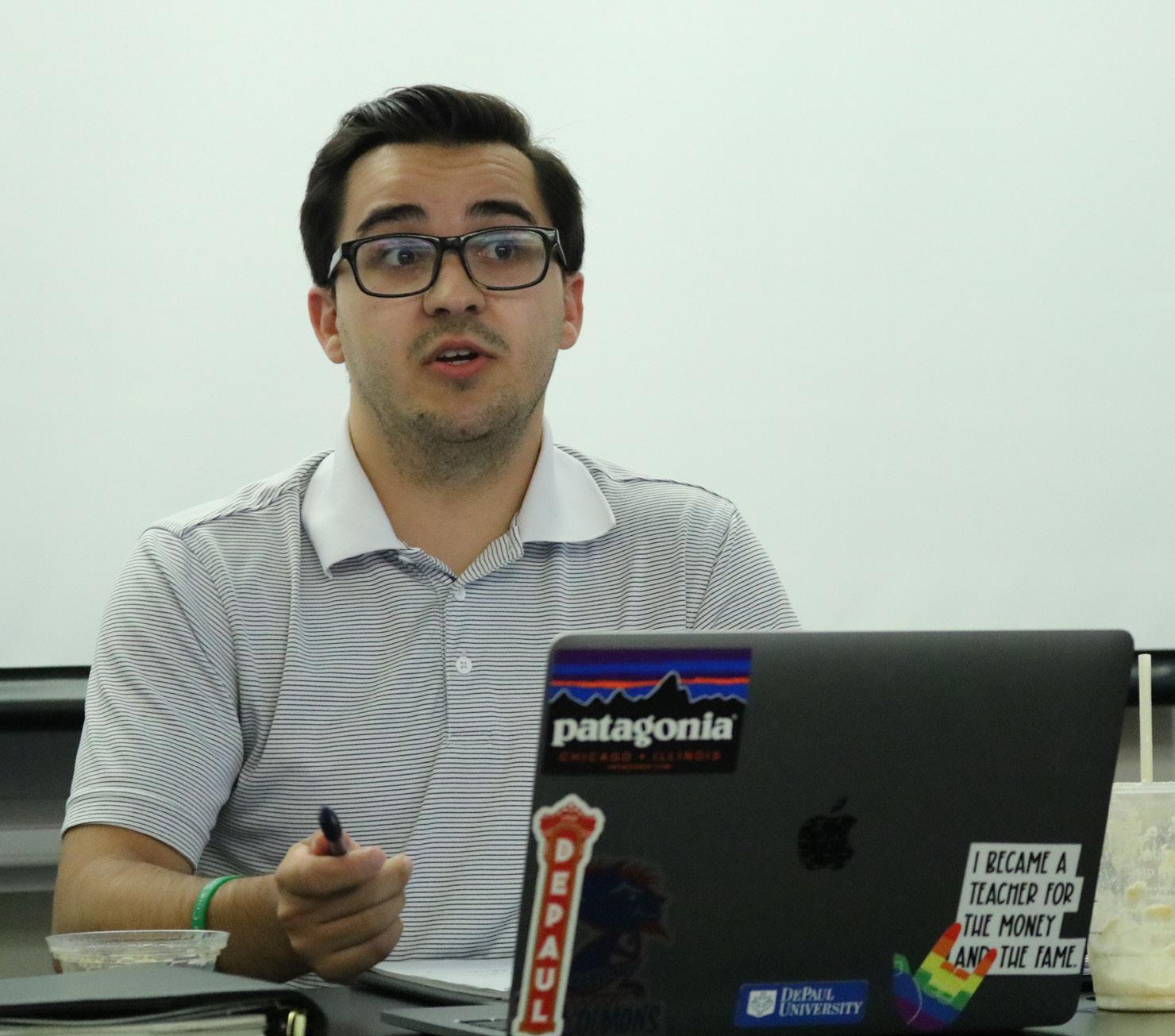 By Claire Tweedie SGA Beat Writer
By Claire Tweedie SGA Beat Writer

The Student Government Association (SGA) announced available positions for this school year’s general board at their meeting on Oct. 6, along with the cam paign schedules and requirements. The 10 positions include senator for first-year stu dents, senator for the theatre school, and senator for sustainability. SGA executive vice president of operations, Cole Kitchens says the number of open positions ranges from year to year.
“Some positions are harder to fill than others, just because of engagement with students,” Kitchens said. “We’re trying to do a major push this year to fill all positions because we do want a full body.”
Students must be currently enrolled at DePaul as part-time or full-time students, have a GPA of 2.5 or higher, comply with the university’s code of conduct, and be a member of a specific student population they are running to represent in order to be placed on the ballot. They may only run for one position and must get 25 signatures from other DePaul students for their name to be put on the ballot.
“Voting in the election is easy, but signing a petition and putting thought into who you’re supporting helps connect you more to the process of the election itself,” senior Joseph Valliquette, SGA Election Operations Board (EOB) chair said. “It’s a great way to support your friends, class mates, and to know who is potentially go ing to be your advocate in student govern ment.”
When students meet the ballot require ments, they must then fill out an applica
tion on DeHub to be considered, which covers general candidate information and a few short answer questions. The appli cation will be open from Oct. 10 through Oct. 21. Mandatory informational sessions for interested students will be held Oct. 10 from 5:30 to 6:15 p.m. in-person and Oct. 12 from 5:30 to 6:15 p.m. on Zoom.
“We’re doing things differently than we have in past years for election marketing. Obviously, last year was strained by the pandemic and being able to be in-person to get the word out about the election,” Kitchens said. “We’re doing tabling this year, you’ll probably see a lot more physical materials around, and there was a change in the way students vote in the system it self. We’re trying to make it all easier for students.”
Students can campaign from Oct. 11 through Oct. 23 after securing their spot on the ballot. Any promotional work, in cluding flyers and social media posts, must be approved by Valliquette and follow the EOB requirements. There will also be a Meet the Candidates event on Oct. 20 at 5:30 p.m. before the SGA general board meeting.
“Any way that you can grab people’s attention is going to help you win,” Valli quette said. “It’s going to help track more attention to the election in general and help people know that there is something going on if they see some awesome, creative cam paign.”
The election will be held from Oct. 24 through Oct. 27 on an online voting system recently revamped for easier user design that will be sent out closer to the election window. The results of the election will be released on Oct. 28 at noon.
“To the general student body, your local election is coming up,” SGA president se nior Kevin Holechko said. “These positions do carry a position of power in the school which you see in the multiple roles where you can dramatically affect a student’s life day to day. The higher turnout you get, the higher qualified your candidate is going to be who’s walking into that meeting space and advocating properly for the students.”
SGA has had issues with voter rates in past elections, citing SGA engagement and student disconnect with administration as a few reasons for the struggle. This year, they hope to increase advertising for the election via posters and social media to en courage more students to have their voices
heard.

“We’re the group that got you all your final exams waived during the pandem ic, we’re the group that got you the Vin nie Vans running five days a week instead of just during finals, we’re the group that got the shuttle buses put in place, we’re the group that got scholarships created,” Holechko said. “We’re the group that’s re ally pushing to try and make your DePaul experience what you are hoping it to be.”
“When you have the support of the stu dent body behind you, if they are aware of what we are doing and they’re helping us in our efforts, the school has to listen to us,” Holechko added. “The change that people are looking for will come.”
RETURN, continued from front page
on Jan. 1 after staying up the night before, and I’m going to be exhausted for classes on [Jan. 2].”
Kevin Holechko, SGA president and senior, said returning to campus earlier than usual is a little upsetting to him.
“Unfortunately, that is the way the academic schedule fell this year,” Holec hko said. “I acknowledge that a number of out-of-state students will be affected by this, especially those who have to re turn before Jan 1. So what I would be asking is what are those departments do ing to make the return at least somewhat enjoyable for both students and staff who are leaving the family gatherings a little bit early? What are they doing to say? ‘I’m sorry you have to be here, and I’m grateful you are doing this’?”
Holechko said while the news is up setting and students may reach out to the Office of Academic Affairs about their concerns with the start date, he said students should “not hold out hope that the university will be adjusting its schedule anytime soon.”
The Office of Academic Affairs en couraged students who are returning to school for the 2023-2024 academic year that the schedule will not be the same. The winter quarter in 2024 will begin on Saturday, Jan. 6, according to the aca demic calendar on DePaul’s website.

AD Peevy demonstrates athletics’ importance to Faculty Council, urges support
By Patrick Sloan-Turner Online Managing EditorDePaul Athletic Director DeWayne Peevy paid a visit to Faculty Council at the group’s meeting on Wednesday to discuss the importance of athletics at the univer sity.
Peevy gave a presentation and spoke for around 30 minutes about the role athletics can play in improving DePaul’s national footprint. In speaking to the council, Peevy emphasized that there is a significant amount of work to get DePaul athletics to the standing that both he and the university want them to be and urged faculty to continue and increase their sup port.
“Right now, the front porch is rag gedy and rundown. No one is looking at the house and stopping and saying this is where I want to live,” Peevy said, as he explained that currently, DePaul is not a top-tier destination for athletes coming out of high school.
Improving the programs takes fund ing. Peevy explained this funding comes in several ways. Peevy said that getting more money into the athletic department can be done in several ways: through fundraising and donations, ticket sales, and the basketball team being in the na tional spotlight.
“Now we’re talking about [making] fundraising efforts to really make a dif ference at DePaul… and really change this university to a place we want it to be,” Peevy said.
The AD also demonstrated how strong athletic programs directly influence ac ademics and enrollment, areas of which faculty council is focused on improving.
Peevy cited the staggering applica tion bumps school’s experience after their men’s basketball teams made the NCAA tournament.
“We just want to get to the tourna ment for the first time since 2004,” Peevy
said. “Private schools that go to the tour ney have a 6-8% increase in applications.”
In 2013, Florida Gulf Coast Univer sity received a 27.5% bump in applica tions after its team made the tournament. When Loyola Chicago made the final four in 2018, the school’s academic website ex perienced a 400% increase in traffic that spring.
Increased applications directly result in increased enrollment and a more com petitive selection process, which raises a school’s academic standing.
Faculty Council Officer and College of Communication Professor Matt Ragas was quick to praise the efforts Peevy and his staff has made in the community since taking over DePaul’s athletic program in 2020.
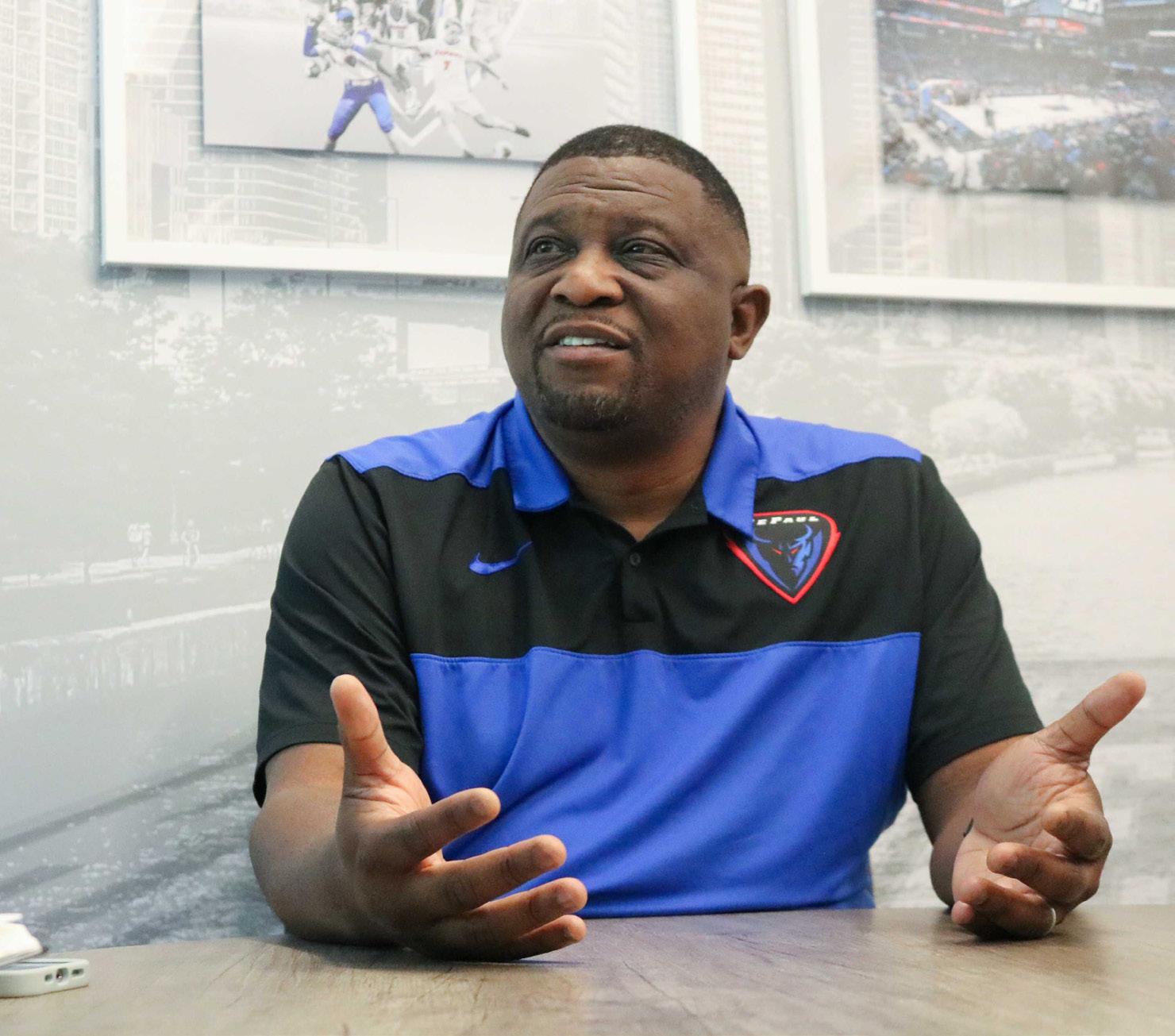
“I’ve seen [Peevy and staff] doing much more in the community [than in years past] since I’ve been at DePaul,” Ra gas said.
Faculty members in attendance voiced consideration that current DePaul athletes are receiving adequate academ ic guidance. Mary Mindak, an associate professor at DePaul’s Driehaus College of
Business, asked Peevy if he feels that ath letes are receiving sufficient support from faculty.
“We have student athletes coming in with a much higher academic profile than I’ve seen before and from a GPA stand point we are doing better,” Peevy told her. “These questions are important. Let’s not let student support get to a point that it’s a problem.”
Before leaving, Peevy urged faculty members to take their support of athletics a step further and make efforts to attend DePaul athletic events, a subject of con siderable focus for the department, as low attendance has plagued DePaul’s premier sports in recent years.
Other Meeting Notes:
At Wednesday’s meeting, voting mem bers in attendance approved a new minor in speech pathology.
The council spent a significant amount of time discussing current bud get priorities. Since January 2020, DePaul faculty has not received a pay increase. Faculty discussed the impact of this pay freeze instituted by university administra tion to combat economic issues from the COVID-19 pandemic. The annual infla tion rate as of August 2022 sits at 8.3%, ac cording to the U.S. Department of Labor Statistics, the highest this figure has been in decades.
“Right now, the front porch is raggedy and rundown. No one is looking at the house and stopping and saying this is where I want to live.”
DeWayne Peevy DePaul Athletic Director
Nation & World
Thais mourn dozens, mainly kids, killed in day care attack
By Tassanee Vejpongsa & David RisingUTHAI SAWAN, Thailand (AP) —
Relatives wailed and collapsed in grief before the small coffins of children Fri day after a fired police officer stormed a rural Thai day care center at naptime and massacred 36 people.
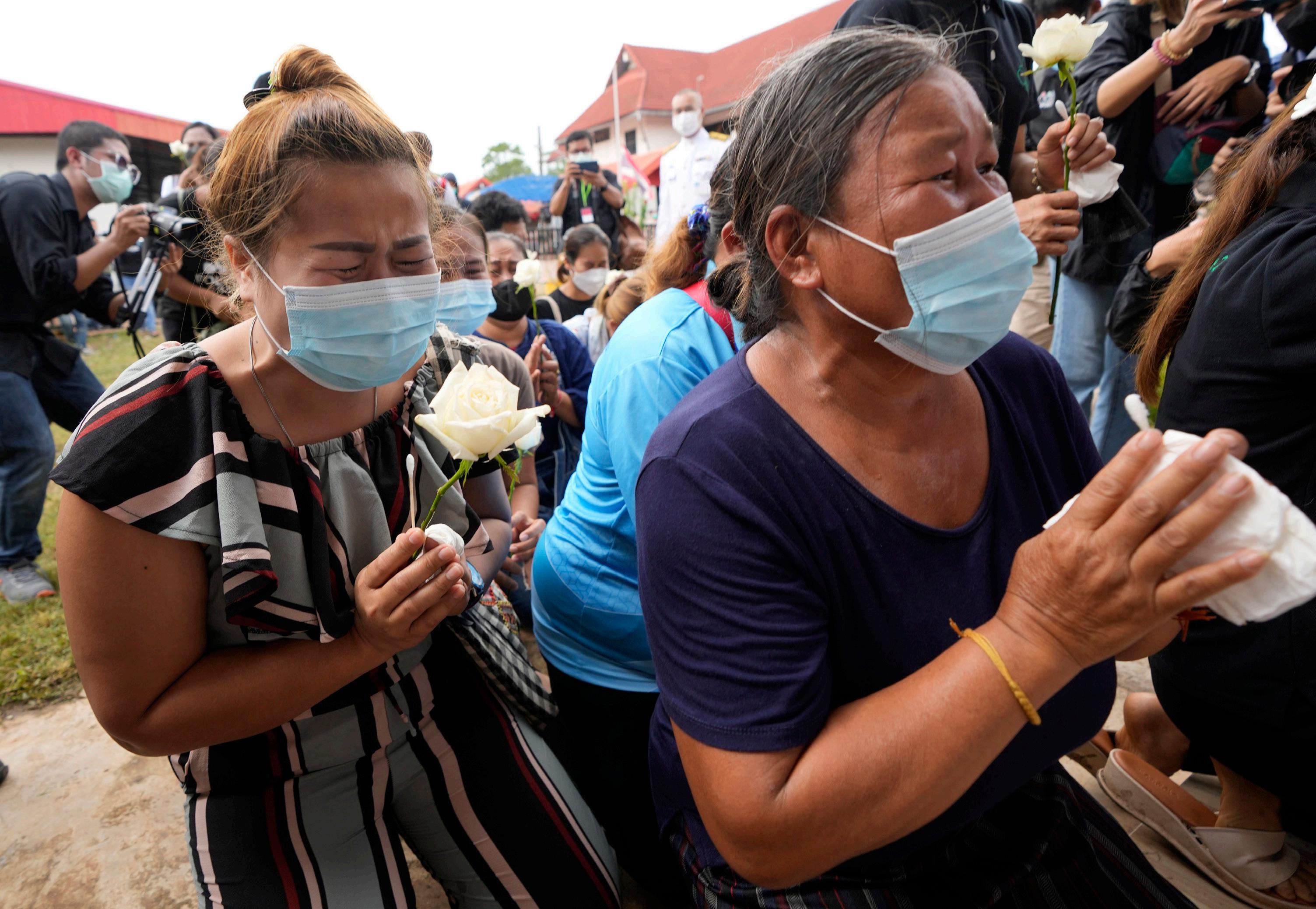
At least 24 of the dead were children, mostly preschoolers. The grisly gun and knife attack a day earlier was the dead liest mass killing in Thailand’s history, leaving virtually no family untouched in Uthai Sawan, a small rural community nestled among rice paddies and palms.
“I cried until I had no more tears coming out of my eyes,” said Seksan Sri raj, 28, whose wife was a teacher at the Young Children’s Development Center and was due to give birth this month.
Across the country, flags were low ered to half-staff and schoolchildren said prayers to honor the dead, while at the site of the attack, about 85 miles (137 ki lometers) from Laos, a stream of people, including Prime Minister Prayuth Chanocha, left flowers.
The wall outside the small, one-story day care center was lined with bouquets of white roses and carnations, along with juice boxes, bags of corn chips and a stuffed animal.
Relatives crowded the grounds of a nearby Buddhist temple to receive the dead after their autopsies. Some screamed as the small, white coffins were opened. Others fainted and were revived with smelling salts.
“It was just too much. I can’t accept this,” said Oy Yodkhao, 51, a rice farm
er whose 4-year-old grandson Tawatchai Sriphu was among the dead.
Som-Mai Pitfai collapsed at the sight of her 3-year-old niece’s body.
“When I looked, I saw she had been slashed in the face with a knife,” the 58-year-old said, holding back tears after being revived by paramedics.
Elsewhere, King Maha Vajiralong korn and Queen Suthida visited two hos pitals where some of the 10 people who were wounded were being treated.
Police identified the attacker as Pan ya Kamrap, 34, a former police sergeant fired earlier this year because of a drug charge involving methamphetamine. He had been due to appear in court Friday.
Authorities believe Panya may have been triggered by an argument with his wife. He took his own life, police said, af ter killing his wife and son at home.
“As of now, the police assume that he became stressed because he was afraid that his wife would leave him,” National police chief Gen. Dumrongsak Kittip rapas said.
In interviews with Thai media, Pa nya’s mother said there was tension be tween her son and his wife, and talking with 3Plus News, she said he was stressed by debt.
An initial autopsy of Panya did not detect any dangerous drugs, police said. A second autopsy was planned.
Children at the day care center had been taking an afternoon nap at the time of the attack, and photos taken by first responders showed their tiny bodies still lying on blankets.
In some images, slashes to the vic
tims’ faces and gunshots to their heads could be seen.
An employee of the center told a Thai TV station that Panya’s son had attend ed the day care but hadn’t been there for about a month.
In an interview with Amarin TV, Sati ta Boonsom, a worker at the center, said staff locked the building’s glass front door after seeing the assailant shoot a child and his father out front. But the gunman shot and kicked his way through.
Satita said she and three other teach ers climbed the center’s fence to escape and call police and seek help. By the time she returned, the children were dead. She said one child who was covered by a blanket survived the attack, apparent ly because the assailant assumed he was dead.
The center usually has 70 to 80 chil dren, she said, but there were fewer at the time of the attack because the semester had ended for older children and mon soon rains prevented a school bus from operating.
“They wouldn’t have survived,” she said.
One of the youngest survivors was a 3-year-old boy who was riding a tricy cle close to his mother and grandmother when the assailant began slashing them with the knife. The mother died from her wounds, and the boy and grandmother were being treated at hospitals, according to local media.
Mass shootings are rare but not un heard of in Thailand, which has one of the highest civilian gun ownership rates in Asia.
The rate is 60 times the level in Japan, though still a fraction of the rate in the U.S, according to a 2017 survey by Aus tralia’s GunPolicy.org nonprofit organi zation.
Thailand’s previous worst mass kill ing involved a disgruntled soldier who opened fire in and around a mall in the northeastern city of Nakhon Ratchasima in 2020, killing 29 people and wounding nearly 60 others.
In 2015, a bombing at a shrine in Bangkok killed 20 people.
“When I looked, I saw she had been slashed in the face with a knife.”
Som-Mai Pitfai Resident of ThailandRelatives pray during a ceremony for those killed in the attack on the Young Children’s Development Center in the rural town of Uthai Sawan, north eastern Thailand.
Behind one woman, stand hundreds more
22-year-old Mahsa Amini’s death sparks worldwide outrage
 By Giana Aguilar-Valencia
Writer
By Giana Aguilar-Valencia
Writer
Mahsa Amini, 22, was a Kurdish wom an. On Sept. 13, she took a train to Tehran, Iran visiting her uncle.
During her train ride, her hijab slipped from her head and she was arrested by the morality police once she stepped foot off the train.
After her arrest, Amini was taken to the Vozara morality police detention center for two hours.
At the detention center, while her brother was waiting outside for her, Amini was taken away by an ambulance when she fell into a coma and passed away Sept. 16.
Amini was allegedly beaten and tor tured at the detention center.
Amini’s story is not the first instance of alleged brutality by Iran’s morality police, but her death has sparked international protest.
The entire situation was kept from the public eye by everyone who played a role in the moments of Amini.
Doctors refused to give updates about Amini’s health despite her family’s plead ing, the coroner’s office hid all evidence of abuse except for a bruise and cameras in the van that took Amini to the detention center was broken so there is no footage of the torture she suffered.
“What we are seeing more and more in Iran is a patriarchal system taking away choice from women,” Sufyan Sohel, Depu ty Director and Council at CAIR-Chicago, said.
Women are subject to face violence and sexual exploitation, segregation from men and a lack of political freedom and eco nomic opportunity.
“The religion itself mentions noth ing about harming women, embarrassing women,” DePaul student Safa Saied said. “It’s built on respecting one another.”
“In China [and] France, it is the exact opposite, there is a difference in media cov erage, there is something to be said about some kind of biases,” Saied said.
Through the media and patriarchal dictatorship,women are pressured to fit the mold society wants.
“Islam continues to affect people’s lives and is sometimes justified as being somehow related to Islam even though, as you said they directly contradict what we find in the Qur’an and the example of the Prophet Muhammad,” DePaul University’s Muslim Chaplain Abdul-Malik Ryan said.
A negative image and perspective is placed on Islam based on stereotypes and stigmas. Perspective, education, and aware ness are all necessary actions instead of harmful media perception of vulnerable communities.
The media relays and releases negative representations about Muslims or Islam. “On average, Americans gave Muslims a thermometer rating of 48 degrees, which was 8 degrees warmer than in 2014, when the center first posed the question,” said the PEW research center. According to PEW, individuals choose to believe Islam is more likely to encourage violence compared to other religions.
“Women had enough shit,” Sohel said thus protests broke out and continue to take place.
Reported recently by the Anadolu Agency, the death toll in Iran has risen to 92. The protests have reached places like London, U.K., New York City and Chicago.
On Sept. 22, Chicago protestors gath ered to avow anger towards the murder of Amini. They surrounded Federal Plaza where a memorial was set up for Amini.
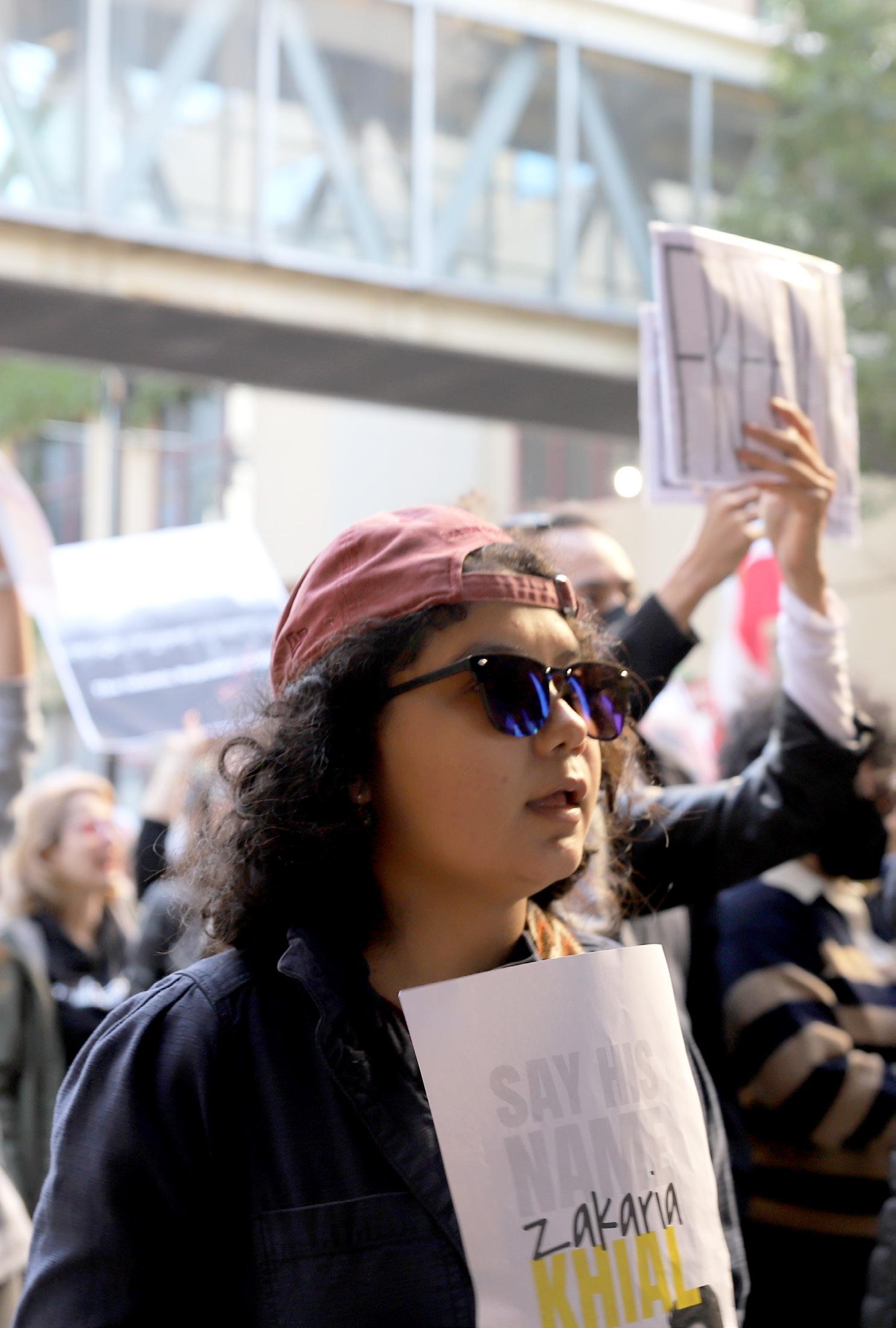
“I do think it should be [a] good reason to explore other causes, not just take these events as tragedies,” Saied said. “[Other causes like] to educate or re-educate your self, open up conversations.”
Muslim Americans in Chicago are sup ported by the Council on American Islam ic Relations (CAIR-Chicago), an organiza tion dedicated to Muslim civil rights and advocacy groups.
They are “working to normalize the im age of Muslims in America,” according to the CAIR-Chicago website.
CAIR-Chicago provides resources, such as legal services, to any Muslim or non-Muslim facing hate or discrimination, Sohel said.
DePaul University’s United Muslims Moving Ahead (UMMA) is an organiza tion on campus.
“People can get involved by coming to our programs or events or just visiting our space on the third floor of the student cen ter,” Ryan said. “In the midst of grief and anger and confusion to have to additionally deal with feeling like people are looking at your faith or your religious practices like wearing hijab in a negative light is an addi tional burden on some students.”
A safe space, a community on campus, allows students of different backgrounds to feel welcomed and appreciated.
“[It has an] awesome presence on cam pus,” Saied said, a member of UMMA. She feels as though DePaul has a bit of an un derstanding.
If there was no presence, she would be concerned, but more work could be done.
As a Muslim hijabi, Saied had both good and bad experiences. She lost con tact with friends, has been singled out in classrooms and was told she “would look prettier without it.”
Despite these realities, she values the opportunities she has to talk with inter viewers and educate people.
“I think that a lot of times, once we set boundaries, we don’t leave a lot of room for others,” Saied said. “If you take in all this information and do nothing, it’s very tell ing.”
The silence and secluded actions De Paul takes on any issue not aligned with the mission raises concerns.
According to Saied, DePaul does poor ly with releasing statements related to the
population of their students in areas that impact them.
Especially, if the school wants to be as supportive to its students as possible.
Sohel believes there’s a lack of under standing with much of the Islamic faith and gender. According to Sohel, Muhammed’s first wife was his boss, who was a divorcee and proposed to him.
“People have this conception that Islam
is a very patriarchal faith,” Sohel said.
Saied believes the remedy for these misconceptions is self-education through credible outlets, and to not believe every thing you read or see about the islamic faith online.
“Pay attention when it’s not in the media! Before and after, it kind of goes to show, they need to be more aware,” Saied said.
Opinions
The dance between activism, politics is called democracy
By Santiago PoSada-Jaramillo Managing Editor of La DePauliaWalking down 18th Street in Pilsen, I stare at a mural. Besides the art, I think about how the wall was planned and officially approved, while the mural works outside the norm, outside the system. But both work to create something beautiful, from very different processes.
The struggle to create a just world has looked different in every society in which it has been attempted. People do not tend to organize themselves in the same way in different cultures or in different systems of government.
In the French Revolution, the monar chy’s hunger, and indifference led people to organize, arm themselves and change the social order in France entirely.
During the Velvet Revolution in Czechoslovakia, now the Czech Repub lic, the students of Prague went out to demonstrate peacefully due to the lack of political representation and ended up achieving their independence against the Soviet Union.
But how does a fight for rights work in a society like ours?
“[I was] an outside agitator and someone who believed we needed to come together, but always ended with, ‘Hey, whatever the politician is, you have to im plement this change.’ And now I am that politician.” U.S. Congresswoman Ilhan Omar said on the Rep podcast.
There, together with her daughter, Isra Hirsi, they spoke about their opposing views on the best method to seek change in society. Hirsi spoke of activism and revolution, while Ilhan Omar proposed voting and representation.
Clearly, their positions are more complex than just this, but they give us the opportunity to see an interesting relation ship in our society: that between activists
and politicians. Are these opposing or complementary forces?
Rosa Esquivel, a member of the Pilsen Alliance and an activist in the Pilsen neighborhood who has fought for many years against the effects of gentrification on the neighborhood’s Latino commu nity, spoke about the difference between fighting for rights from activism and from politics.
“When it comes to the issues, the pol itician can say ‘police responsibility’ while the activist can say ‘abolish the police,’” Esquivel said. “And sometimes the politi cian is terrified of saying something like ‘abolish the police’ or ‘abolish ICE,’ because they are looking for a middle ground.”
The positions of the activist and the politician have a clear difference on this point, because to be elected to a position based on popular vote, few politicians succeed with extremely radical ideas. The more extreme a person’s ideology, the less likely they are to find voters.
This tells us that only the most moder ate politicians reach positions of power or that politics ‘moderates’ people. Personally, I go for the first option, we already have enough examples of extremists with politi cal power to seriously doubt the second.
A member of the Pilsen Alliance, Javier Ruiz, an organizer for property
rights and for quality education in public schools, among others, spoke of how the same struggles take place in parallel, be tween activism and politics.
“I will give you an example with Black Lives Matter," he said. "Now, you could say politically that they are trying to fight for police reform and qualified immunity. But the activists on the street want justice for the people who were killed, I mean, it’s the same message, but it’s like a different approach.”
Here we see an extra feature of this activism-political dynamic. There is a dif ference in the mode and in the approach, but not so much in the core. Whether you’re on the streets with activism or in a councilor’s office, you can fight for the same values, but it would look very different.
But here comes a new difference to an alyze: Is activism closer to the people, but further away from power; while politics is further from the people, but closer to power?
It seems easy to answer at first, since an activist can fight for decades for something that a politician can achieve by signing a paper, but let’s not rush to give this answer in such a forceful way yet.
Alderman of the 25th Ward Byron Sigcho-Lopez, who has been very active in
the Pilsen community for many years and has a unique point of view on the activ ism-political dynamic, shared his perspec tive on this duality.
“I think we have to be clear that our democracy, liberal democracy, is in crisis,” Sigcho-López said. “And that what we need is real democracy, real democratic principles, to guide our elections.”
He feels that this crisis is especial ly linked to the way in which private interests, particularly large companies and billionaires, have hijacked the democratic system to profit economically.
In order to ‘cure’ democracy, it is nec essary to restrict the power of the powerful economic sectors and ensure that it is the people and their needs that direct deci sion-making.
Here you can see where your proposal answers our doubt. Activism and politics, in a healthy democracy, are two parts of the same mechanism. The activism is in charge of making the problems of the people evident, while the politician, under the pressure of the people and the activ ism, uses his power to achieve systematic changes.
“So I think when we have a broken system, our priorities are also broken," Sig cho-Lopez said. "In order for us to take it back, I think it cannot be done electorally, we need to organize at the grassroots level so that we can have representatives that are accountable to us and not to special interest groups."
Like the mural on the wall of a build ing in Pilsen, activism and politics are the ones who together build something beau tiful that neither could achieve on their own. Now, it is our responsibility to create a society where this can be achieved.
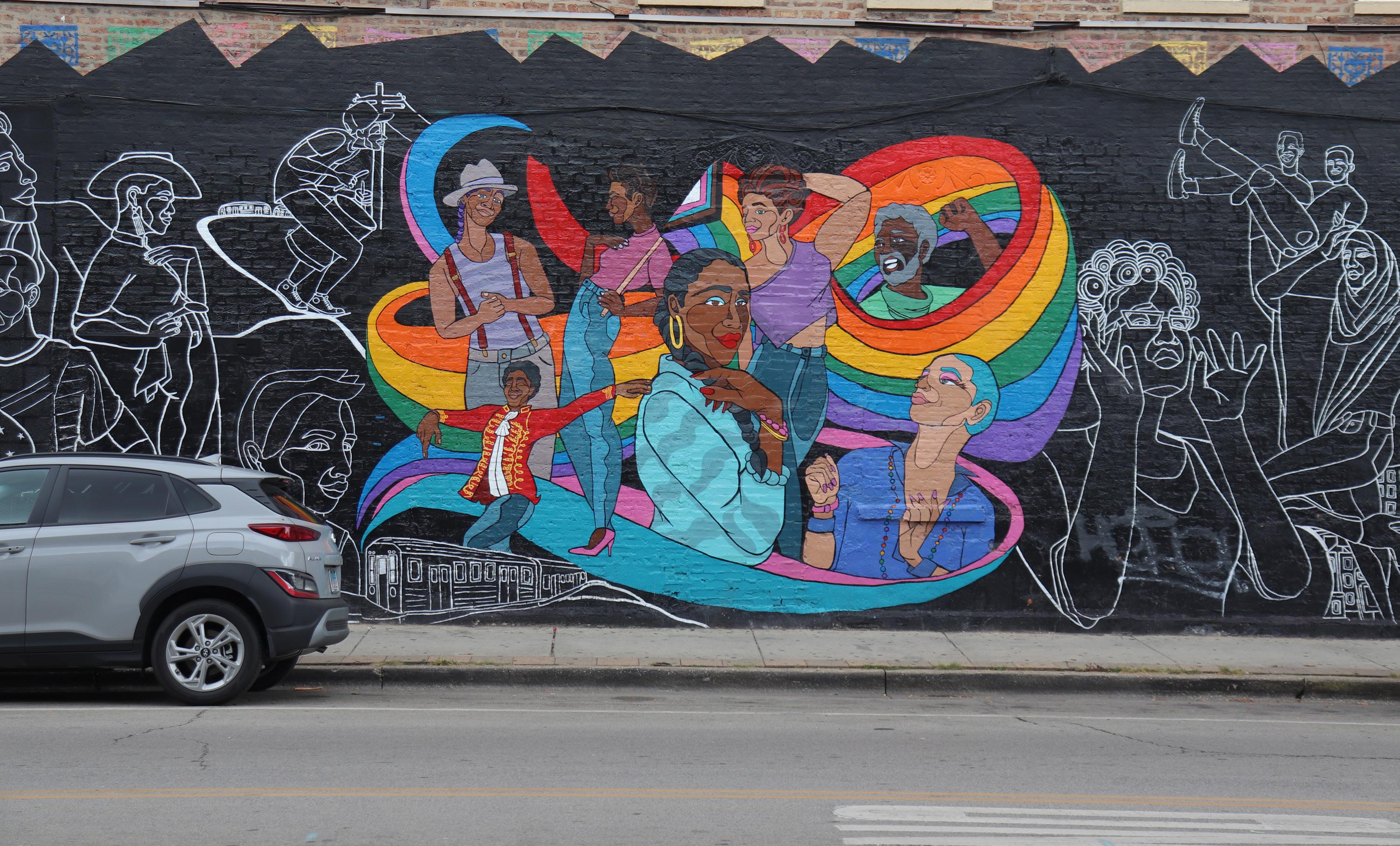
“I think we have to be clear that our democracy, liberal democracy, is in crisis,”
Byron Sigcho-Lopez Alderman 25th WardA mural in Pilsen, near the intersection of 18th and Ashland streets, celebrates the diversity that is a fundamental part of the struggle for rights in the Latino community.
Uber sucks! But I’m not blaming the drivers
By amBer StoutenBorough Multimedia Managing EditorIt's flooding again in Chicago, so much that this time you can’t reach your stop at the “L” unless you swim. You swallow your pride (and four hours of minimum wage) to make it to class on time and pull out your Uber app. 64.56$ for a 15 min drive. Flipping between Lyft and Uber, watching the prices reach higher each time you refresh the page, a Citizen notification pops up and notifies you that somebody got robbed right behind the bus stop to help pressure your decision.
After ordering one anyway and sacrificing lunch money for the week, you see the wait time is 30 minutes. No matter what you do, you’re screwed.
What once was a reliable form of trans portation, rideshare apps now fail their work ers and riders. These services need to make rides safer and cost efficient again.
Olivia Hunter, a senior at DePaul, used to rely on rideshares during the pandemic to get to work safely. But now, after multiple trau matic experiences, Hunter refuses to use them.
“My work was still in person and it wasn’t safe to go on the L during the pandemic. There was so much crime and the trains never showed up anyways,” Hunter said. “I wouldn’t hate Uber as much if I could count on our public transit.”
Between 2018 to 2021, average Uber prices soared 92% according to data from Ra kuten. This is one of the many reasons Hunter decided using Lyft or Uber wasn’t worth it.
“Late at night, I used to call Ubers to be safe but sometimes the price would be $50 to $60 just to get from River North to Belmont,” Hunter said. “I work in the service industry and it’s not like I make a lot of money, now I just take the risk because I’m not wasting all the money I just made.”
Stated in the Uber help line, “Dynamic pricing takes effect when a lot of people in the same area are requesting rides at the same time. This means that rides will be more expensive. Adjusting the price attracts more drivers to an area so everyone can get a ride.”
Like many Chicagoans during the pan demic, Hunter’s life didn’t stop and without the consistency of Chicago's public transit, Hunter dealt with multiple issues when using rideshare apps including ghost drivers, upcharges, and just straight harassment from drivers.
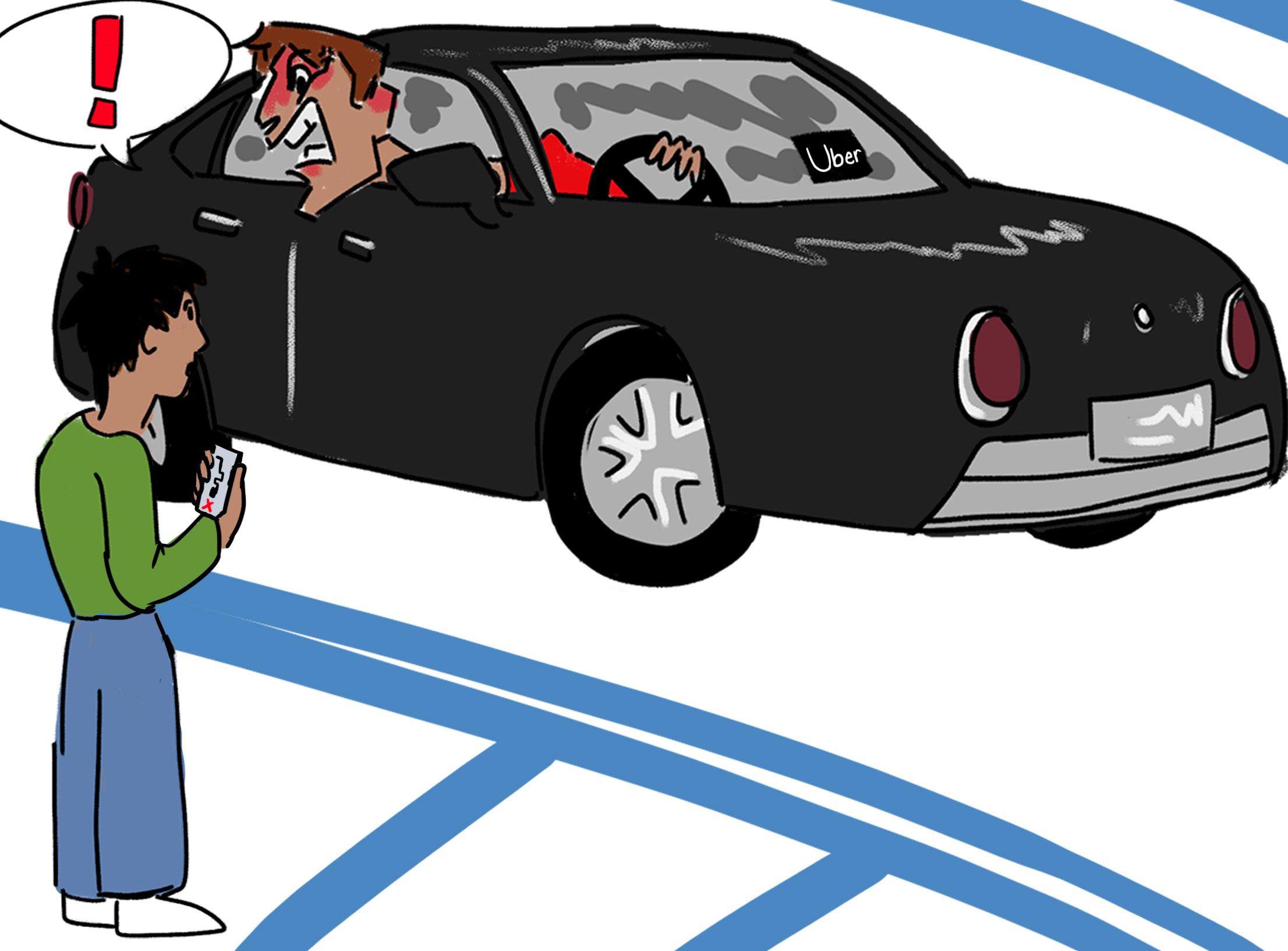
“I would feel so uncomfortable with male drivers, they would ask for my instagram, compliment me really creepy and couldn’t take a hint that I didn’t want to talk,” Hunter said. “I hate that they knew where I lived and when I reached out to Uber multiple times, they never fixed the situation.”
Harassment with Ubers is not uncom mon. Eli Schmitt, a junior at DePaul, experi enced homophobic microagressions with a particular driver that left them uncomfortable.
“I was on my way back from a friend's house late last winter, my driver was a young guy who was adamant about not wearing a mask, [relating] it to other people going to hell,” Schmitt said. “And then like all things do, the conversation turned to religion, and the phrase ‘and there’s the gays’ didn’t sound like a good start to me.”
Schmitt continued the conversation as the driver grilled them about bisexuality and being non-binary. According to Schmitt, the driver seemed to be going through a crisis, asking intrusive questions about his personal sexuality.
“Him being a straight man all his life slowly realizing he isn’t straight, he seemed like he didn’t know heads from tails,” Schmitt said. “By this time we are parked outside my house… I was opening the door to leave when he said, ‘No no no, you don’t have to go.’ I left my foot in the door so it couldn’t be locked.”
The driver proceeded to harass Schmitt and ask if they wanted to engage in sexual intcourse. After politely turning him down, Schmitt left the car and walked around the block before heading back into their house to not be followed.
Uber received 3,824 reports across the five most severe categories of sexual assault and misconduct.” according to the Uber newsroom.
Unfortunately, it is not only the riders who get harassed. One Uber driver spoke to The DePaulia about their struggles with unsafe riders, but asked to remain anonymous.
‘There are a lot of bad people in Chica go, you can never be too safe. I call my wife during my rides in case [something] happens and she needs to call [the] police,” the driver said. “People make fun of my English and call me terrible names and I just keep driving.”
The driver continues to work for Uber and Lyft because it's difficult to find a good paying job in Chicago, while not having the best English skills.
“I have to do what I do to support my family, but I wish I didn’t have this job,” the driver said.
Samantha Close, a Communications and Media professor at DePaul tells The DePaulia, riders are now experiencing what drivers have had to endure since the beginning.
“The recent interest in surge charges and unreliability is consumers of digital platform services experiencing what drivers and other workers on these platforms have had to deal with for years. It's very hard to know exactly how much you're getting paid, much like it can be difficult to know how much a ride will cost,” Close said.
I don't blame the drivers for how ride share apps are unreliable. The companies themselves have been putting profit first instead of consistency and support for its workers and users.
Geoffrey R. O. Durso, an assistant mar keting professor at DePaul, said the recent increase in prices is a normal practice for bigger companies to make profit.
“For years, Uber and Lyft invested a lot of resources in getting riders and infrastruc ture (like at airports) to win market share, including college students of course,” Durso said. “But those early years were subsidized by venture capital, without much in real-time profits to sustain the business. Now, they are in a position where their consumers rely on their services, and they are pursuing their longer-term profit goals.”
With data analytics, companies like Uber and Lyft can change prices around to meet consumers demands, including surge prices depending on weather, special events and time of day.
“There is then a squeeze: Riders get sticker shock at the price of a service they've come to rely on, and drivers don't see much of the additional profit for their labor, and the higher prices discourage riders from adding tips, which dp go to the drivers,” Durso said. “All the money flows to investors after years of low profits.”
Without the consistency of public transportation and now the overcharging and unsafe climate with rideshare apps, many young adults are left to risk their safety how they travel within the city. If my mom knew the sometimes dangerous risks I’ve put myself in to save 40$, I would be back in Missouri by now.
Biden’s marijuana pardon is not enough
By Samantha moilanen Opinions EditorPresident Joe Biden pardoned thousands of people convicted of illegally possessing marijuana under federal law on Thursday. The Biden administration is reviewing whether marijuana should be in the same category as LSD and heroin.
The pardons will clear everyone charged with ‘simple possession’ of marijuana since it became a crime in the 1970s under the Controlled Substances Act. The pardon comes weeks before the midterm elections that will determine control of Congress and is likely a political calculation to appeal to young voters.
Although the pardons are the beginning to decriminalizing marijuana, the Biden Ad ministration should go further to completely deschedule marijuana from the Controlled Substances Act. If marijuana remains on the federal drug schedule, people will still face criminal charges for marijuana use and possession.
The pardons will not apply to people convicted of selling or distributing marijua na.
“Sending people to jail for possessing marijuana has upended too many lives – for conduct that is legal in many states,” Biden said on Twitter. “Today, we begin to right these wrongs.”
Biden’s actions represent a fundamental move toward nationally legalizing mari juana possession in the U.S., and changing America’s response to a drug that has been at the forefront of cultural and policing issues for decades.
“Too many lives have been upended be cause of our failed approach to marijuana,” Biden said in a video. “Criminal records for marijuana possession have led to needless barriers to employment, to housing, and educational opportunities.”
Officials told the Equal Justice Initiative, more than 6,500 people were convicted of simple marijuana possession under federal law between 1992 and 2021. Thousands more were convicted under D.C. drug laws.
More people have faced criminal charges for marijuana possession in state courts across the country. Although Biden’s pardons will help people charged with pos session under federal law, most convictions happen at the state level leaving it up to the governors to issue pardons.
In 2018 alone, nearly 700,000 people were arrested for illegal marijuana posses sion nationwide, according to data from the American Civil Liberties Union.
Biden’s proclamation falls short of calling for the complete decriminalization of marijuana. However, the pardons adhere to most states’ already lax policies on mari juana possession which have reduced or eliminated criminal charges for possession of the drug.
Currently, 19 states have legalized marijuana recreationally and 38 states have legalized medical use of marijuana. Arkan sas, Maryland, Missouri, North Dakota and South Dakota have legalization measures on the ballots for the November midterms.
Biden is urging state governors to take similar actions to decriminalize marijuana. He is also asking Health and Human Ser vices and the Justice Department to review whether marijuana should be classified as a Schedule 1 substance, which he claims should only be reserved for the most danger ous substances.
There are no people currently serving time in federal prison for marijuana posses sion, so unless the states decide to legalize the drug, it is only useful in clearing offend ers' records. However, the president’s action will help remove barriers to getting jobs, finding housing or applying to college for offenders convicted of marijuana possession.
You are on
Land Acknowledgements Bring
By Nadia CaroliNa Her Na Ndez Managing EditorLand acknowledgements are used throughout the country to recognize the tribal lands English settlers colo nized. At the DePaul academic convo cation held on Sept. 1, President Rob. L Manuel included the official land acknowledgement before introducing faculty.
DePaul’s Indigenous land acknowledgement will soon be hung up in the Lincoln Park Stu dent Center according to Eliza beth Ortiz, vice president for In stitutional Diversity and Equity.
The Office of Institutional Di versity & Equity (OIDE) released the university’s land acknowl edgement in spring 2021. The acknowledgement focuses on three Native tribes to the city:the Potowanami, Odawa and Ojib


we. Chicago has the third-largest urban Native population in the US according to WTTW. DePaul has 34 Native and 36 Native Hawaiian/Pacific Islander students enrolled in 2020, according to the 2020 enrollment summary.
Ortiz described the three month time line of drafting the document.
“We went through nine drafts, we had four meetings with the community, put
something on paper, they would give us their feedback, we change it, we come back, we discuss it again,” she said.
Jonathan Ballew (Potowanami), De Paul alum, worked with University of Illinois Chicago’s Law school to develop their own land acknowledgement.
“I think they’re helpful to allow folks to remember that Indigenous folks have always been here; however, I don’t really think they’re as great as everybody says they are,” Ballew said. “They’re a nice step, but I don’t think they really accom plish much for actual Indigenous people.”
About 8% of the national Indigenous population experienced homelessness in 2022, according to SunRise Native Recov ery.
Rachel Boyle, DePaul history profes sor, described that issues Indigenous peo ple continue to face are often ignored in land acknowledgements.
“Groups like Chicago Indian Village challenged the lack of affordable hous ing for Indigenous Chicagoans,” she said. “Both U.S. and Chicago history is defined by attempted cultural genocide by settlers and continued resistance and survival of Indigenous people.”
For the Newberry Library, a land acknowledgement is merely a starting point, according to Rose Miron, director of Newberry Library’s McNickle Cen ter for American Indian and Indigenous Studies.
“A lot of people and institutions sort of see them as a very easy fix or a very easy step to take to perform their interest in Indigenous people,” Miron said. “[They] don’t actually take any step beyond that to repair harm that’s been done.”
According to Ballew, an important distinction to make in acknowledge ments is recognizing that Native people continue to live on the land.
“It’s not that the people were here, it’s that the people still are here,” Ballow said. “A majority of Native folks have been genocided, but that doesn’t mean that na tive people are here.”
Mark Turcotte (Turtle Mountain Ojibwe) and DePaul Senior Lecturer in
English said that land acknowledgments bring visibility; however, may not bring the space or time to recognize all tribes native to Chicago.
“Chicago has Native people living here from nations all over America,” Turcotte said. “All it takes is a sentence or two in your acknowledgement to say and to recognize today the wide variety of diverse Native nations who have made Chicago their home.”
In 2018, the #LandBack movement became viral on social media highlight ing the fight to restore Indigenous rights to their land. Currently, reservation land is held “in trust” by the federal govern ment, according to The Atlantic. Ballew believes this means land acknowledge ments should include current fights about land back.
“Tribal nations don’t actually own any of the reservation land,” he said. “[Land acknowledgements] are helpful to get people to be remembering and thinking about Indigenous folks. I think that land back is a much more powerful move ment.”
Historical narratives changed to in clude more Indigenous perspectives during colonization.

“Ignoring the history and continued reality of settler colonialism is, in itself, a tool of settler colonialism,” Boyle said. “By pretending that the United States has not attempted genocide on Indigenous people and refusing to acknowledge that we live on the homeland of Indigenous people past and present, there is no space to imagine and embrace different ways of relating to the land and each other.”
DePaul encourages hosts of events to recite the land acknowledgement at the beginning of university- wide events. Al though it is a gesture, Turcotte believes it to be a necessary step to take.
“I think the best thing to say about it is when it’s genuine,” he said. “It’s a good first step. It’s a good gesture. I don’t mind gestures, because sincere gestures lead to bigger and better things and more mean ingful things.”
Since it has been released, the land
native land
indigenous Visibility to depaul
acknowledgement has been revised once.

Jose Perales, director of Diversity Oper ations who also worked on the universi ty’s land acknowledgment, has worked in higher education diversity spaces for 37 years and felt humbled by the experience.

“Working with this here with col leagues, just for me, highlighted person ally how much I was learning,” Perales said. “Meaning that there’s always some thing we can learn, we have to approach this with humility and open ourselves to understanding the communities and the processes in a very different way.”
The statement will continue to be a “living document” according to Ortiz. Ed its will be made as DePaul receives com munity feedback.
“I feel for the most part what I encoun ter in DePal is genuine,” Tucotte said. “The people, the faculty that I work with at De Paul, the staff at work at DePaul are genu ine, sincere people. I feel like I’m allowed to be who I am a Native person, a Native faculty member, a Native artist, writer and poet.”
Top 5 contested statues in Chicago
1. Balbo Monument: Gift from facist director Beni to Mussolini and celebrates Italo Balbo; Italian aviator integral to the rise of Mussolini.
2. Confeder ate Mound In Oak Woods Cemetery
The confed erate mound marks a mass grave containing the re mains of more than 4,00 Confeder ate prisons.
3. Douglass Park
Recently changed, the park was orig inally named after Patrick A. Doug las an outspoken opponent to the abolishmnet of slavery: ‘Doug las Park.’ It was changed to ‘Dou glass Park’ after Fredrick Douglass, former abolition ist and activist for racial equity.
4. Washington Park Seeking the removal of the statue of George Washington.

Scan to read DePaul’s land acknowledgement
5. Chetnik Monument of Drazo Mihajlovic Celebrates the remembrance of Drazo Mikajlovic who sought to create Greater Ser bia through ethnic cleansing during WWII.
“All it takes is a sentence or two in your acknowledge ment to say and to recongize today the wide variety of diverse Native nations who have made Chicago their home,” Mark Turcotte
Turtle Mountain Ojibwe DePaul Senior Lecturer
La DePaulia
‘Es una oportunidad para que las familias se reúnan otra vez’
Estados Unidos promete más personal para la inmigración cubana
 By Diego Vargas reyes Escritor, La DePaulia
By Diego Vargas reyes Escritor, La DePaulia
La embajada de los Estados Unidos en Cuba lanzó un comunicado informando la reanudación e implementación de más personal en el proceso de visas para inmigrantes el fin de Septiembre. Este proceso promete asegurar la migración legal de al menos 20,000 cubanos para el 2023, sin contar a los parientes cercanos de los ciudadanos estadounidenses.
Como parte de esta implementación, los ciudadanos cubanos no necesitarán viajar a Georgetown, Guyana, para completar el proceso de su visa, como se solía hacer.
Así mismo, se contratará mayor personal con el propósito de reanudar el programa Cuban Family Reunification Parole (CFRP), inaugurado en el 2007 y suspendido en el 2017. El cual tiene como objetivo ofrecer rutas y alternativas seguras y legales a los ciudadanos cubanos que deseen viajar a EE. UU., así como a los ciudadanos americanos para que puedan reunirse con sus familiares cubanos.
Por otro lado, el tipo de visa que se empezará a tramitar en La Habana, Cuba, para los ciudadanos familiares de residentes en EE.UU., permitirá a los inmigrantes poder vivir y trabajar en este país.
Rafaella Villamar, estudiante ecuatoriana de segundo año en DePaul University, comentó sobre cómo estas medidas la han afectado personalmente.
“Es una oportunidad para que las familias se reúnan otra vez, por esa parte abre un montón de oportunidades a esas personas para desarrollarse en un nuevo lugar”, dijo Villamar.
Villamar dijo que espera que el proceso sea justo y asequible para todas las personas.
“También me parece bien que hayan cambiado la localización, ya que es en la capital y es más sencillo de acceder para el resto de las personas que no pueden movilizarse tan fácil”, ella dijo.
Con la reinauguración del programa CFRP, la Embajada de EE.UU., localizada en La Habana, estima poder procesar cerca de 20,000 trámites para 2023.
Emily Vallejo, estudiante de tercer año en Estudios de Paz, Justicia y Conflicto en DePaul University, opina que es un paso importante en la dirección correcta.
“En cuanto este proceso sea accesible y justo para los ciudadanos, no debería haber ningún problema con esta implementación”, dijo Vallejo.
Vallejo también comentó: “Pienso que es un paso en la dirección correcta para que nuestro gobierno [EE.UU.] trabaje en conjunto y pueda proporcionar algún tipo de ayuda a las personas que no tienen otra opción más que dejar el país que aman en busca de oportunidades económicas”.
La administración del presidente Biden anunció esta información con el fin de facilitar el proceso del trámite de visa y, por lo tanto, reducir el número de migraciones ilegales de Cuba hacia EE. UU.
De acuerdo a lo informado por la Aduana y Protección de Fronteras de Estados Unidos, se detuvieron a 19,057 inmigrantes cubanos que intentaron ingresar en agosto de

este año, siendo más de cuatro veces la cifra de agosto del 2021.
Este proceso garantizaría la disminución del tráfico ilegal de inmigrantes a EE.UU., la cual lleva bastante tiempo perjudicando el país, ya que no existe ninguna consecuencia legal por ser expulsado de EE. UU. debido a la ley establecida como Title 42. Esta ley dicta la expulsión de inmigrantes que intenten entrar a los Estados Unidos, que provengan de un país con una enfermedad contagiosa y fue especialmente aplicada en el caso del Covid-19.
Flavio Diaz, un estudiante de tercer año en Administración de Empresas en DePaul University expresó sus sentimientos al respecto.
“Me parece bien que implementen este proceso, pienso que también debería considerarse a otros países y las limitaciones que les aplican en el trámite de una visa”, dijo Diaz.
El proceso para tramitar una visa aún no es del todo accesible y optimizado en muchos países de Latinoamérica, muchos de los ciudadanos están en lista de espera o necesitan viajar a otro estado o país para completar el proceso.
Para muchos, esta implementación permitirá que muchos inmigrantes puedan reencontrarse con sus familiares.
El Festival Vintage de Pilsen celebra su regreso conmúsica, ropa y un sentido de comunidad
By stephania roDriguez Escritora, La DePauliaEn el primer fin de semana de octubre, las calles de Pilsen estaban adornadas con más de 85 vendedores de ropa y artículos antiguos. El Festival Vintage de Pilsen se celebró por segunda vez y permitió a la gente disfrutar de música en vivo, una cabina de fotos y un desfile de moda.
El festival tomó lugar el primero y segundo de octubre, y se extendió desde la calle 19 con Blue Island hasta la 21 con Laflin, desde las 12 p.m. hasta las 8 p.m. De acuerdo con la página Chicago Vintage Fest, el evento recibió a más de 1,200 registrantes.
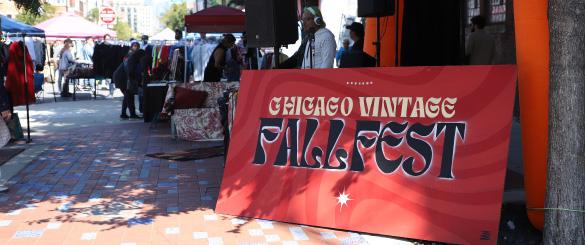
El festival fue organizado por pequeños negocios de Pilsen Vintage y Print Depot, localizados en las calles 18 y Laflin.
Pilsen Vintage ha sido parte de la comunidad por más de una década, pero el dueño, Paul Guizar, y su hija, Ashley Guizar, enfrentaron muchas dificultades debido a la pandemia. Los dueños tuvieron que cerrar Pilsen Vintage en el 2020 y planear qué iban a hacer para poder recuperarse y volver a abrir sus puertas.
Después de volver a abrir, los dueños planearon una block party para unir y ayudar a los negocios de moda a vender sus productos en la comunidad de Pilsen. Dos años después, lanzaron el primer Festival Vintage en el verano del 2022.

Tras el éxito del primer festival de verano, los organizadores decidieron traer el festival de regreso a las calles para volver a unir la comunidad con este evento.
“Mi objetivo para el evento es convertirlo en un evento sobre moda, cultura, singularidad y estilo,” dijo Ashley Guizar.
“Creo que hay muchos festivales que circulan en torno a la comida y el
licor. Quiero que este sea un evento único, una experiencia única para cualquiera que esté interesado en la moda, en lo antiguo, y en la sostenibilidad”, ella dijo.
Diego Astorga y Kelsey Conner son dueños del pequeño negocio “Wellrounded”, que vende ropa de estilos retro, moderna y vaquera. Ellos estuvieron presentes como vendedores durante el festival del verano y también del otoño.
Astorga y Conner lanzaron “Wellrounded” hace apenas seis meses pero dicen que el Festival Vintage ayudó a ganar mucha visibilidad a su negocio y a aprender sobre lo que le interesa a la gente en la moda.
“Lo que he aprendido es que a mucha gente le gusta la ropa de gran tamaño,” dijo Astorga. “ Y la comodidad y la ropa que es multifuncional.”
Sandra De La Rosa fue al Festival Vintage de Pilsen para ganar visibilidad para su negocio, “Sandry’s Holy Coffee’’, que vende café colombiano orgánico con notas únicas de chocolate y almendras.
“Es mi primer año en mis ventas y dando a conocer mis productos”, dijo De La Rosa. “Pilsen es una comunidad muy bonita, una comunidad muy diversa y por eso decidí venir a vender aquí.”
Si los organizadores planean traer el festival de regreso el próximo año, Ashley Guizar dice que necesitará más ayuda coordinando el evento.
“Debido a que el evento se ha expandido, creo que definitivamente necesitamos llegar a un lugar donde se pueda traer más empleados para ayudar con la cantidad de cosas que tenemos que transportar y organizar”, dijo Ashley Guizar.
Mes de La Herencia Hispana llega a DePaul con el evento FERIA
By Cary roBBins y santiago posaDa-Jaramillo Escritora y Gerente Editorial, La DePauliaOlivia Pérez bailó en el evento FERIA que se llevó a cabo justo fuera del Centro de Bienvenida en la universidad DePaul el jueves 22 de septiembre para celebrar el comienzo del Mes de la Herencia Hispana.
Pérez, una estudiante de primer año, dijo no haber visto a muchos otros estudi antes latinos en sus clases, por lo que vino al evento para conocer a otros que tengan sus mismas procedencias.
“Realmente no estoy acostumbrada a estar lejos de mi familia, y mi cultura es una gran parte de lo que soy”, dijo Pérez. “Así que venir aquí fue una forma de volver y experimentar mi herencia”.
Autos lowrider, camisetas con aerógrafo, comida, música, baile, muchos estudiantes, y más, llenaron el estaciona miento donde la gente se reunió para cele brar el Mes de la Herencia Hispana.
En el evento, Pérez bailó con su amiga, Camila Guadalupe, quien también vino a celebrar y conocer gente nueva. Su parte favorita fue poder cantar y bailar canciones con personas que ya conocía y otras que es taba comenzando a conocer.
“[Mi parte favorita es] que todos con ocen todas estas canciones porque hemos crecido con ellas”, dijo Guadalupe. Tam bién dijo que cantar con otras personas es “muy reconfortante y es solo un sentido de comunidad”.
Muchas personas que asistieron, hablaron sobre la música. Estudiante de
DePaul, Jonathan Castañeda dijo que le gustó cómo el evento trató de representar a muchas comunidades latinas. Después de lo ocurrido con el huracán que acaba de devastar a Puerto Rico, un grupo, Africa ribe, interpretó danzas puertorriqueñas y caribeñas.
“Los latinos no están formados única mente por los pueblos indígenas de Améri ca Latina”, dijo Castañeda. “Se mezclaron con los españoles y también con las per sonas que se trajeron de África en ese en tonces”.
Sin embargo, su parte favorita del even to fue escuchar hablar a un grupo de activ istas comunitarios, los Young Lords, sobre su historia con la universidad DePaul.
Los Young Lords lideraron una lu cha contra la Universidad DePaul cuando comenzó a gentrificar el vecindario de Lin coln Park y comprar casas y edificios para expandir el campus. Por lo que, debido a su expansión, la población puertorriqueña y de clase trabajadora que vivía en el barrio se vio obligada a mudarse.
“Ser mejor para mí y celebrar parte de esa herencia que una vez fue oprimida es un buen sentido de orgullo de aquí vinien do de personas que tenían peores condi ciones que nosotros”, dijo Castañeda.
Mientras recordaba la historia, el esta cionamiento se llenaba de muchos lowrid ers. Los Lowriders son parte de la cultura chicana y su historia se remonta a la década
de 1940 entre los Mexicanos Americanos.
Alberto Melgoza, quien tiene su auto desde hace 17 años, dijo que el trabajo con los lowriders nunca termina. Si bien volvió a pintar el exterior, rehizo el interior y el motor, todavía espera pintar un mural en el costado del automóvil y continuar hacien do renovaciones..
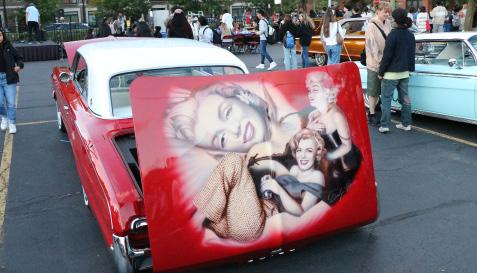
“Esto es como una cosa latina”, dijo Melgoza. “Hacemos los autos que saltan hacia arriba y hacia abajo, y podemos ba jarlos de lado a lado, hacia adelante y hacia atrás, definitivamente es muy divertido y nos separa de otras culturas porque… so mos nosotros quienes comenzamos esto en el pasado”.
Miguel Bucio recuerda cuando trajo su auto a casa por primera vez. Mientras re
molcaba el automóvil de regreso a casa, re visaba sus espejos cada cierto tiempo para asegurarse de que el automóvil todavía es taba seguro en el remolque. Cuando com pró el coche, no tenía motor. El único pedi do del propietario fue arreglarlo y cuidarlo.
Bucio tiene el auto desde hace 15 años y lo considera como uno de sus hijos. Su par te favorita de tener el auto es cuando está conduciendo. Le encanta escuchar a la gen te decir que les gusta su auto y el ver a los estudiantes en el evento tomar fotos frente a su auto lo hizo sentir feliz.
“Se siente como en casa porque todos son parte de él y todos se divierten”, dijo Bucio. “Luego se van a casa y hablan de las cosas buenas que vieron hoy. Todos son realmente como una familia”.
FRANKIE PEREZ LA DEPAULIA Un letrero del Festival Vintage de Pilsen le da la bienvenida a todos los visitantes el primero y segundo de octubre. FRANKIE PEREZ | LA DEPAULIA La gente mira a través de los estantes de ropa a en El Festival Vintage de Pilsen. CARY ROBBINS | LA DEPAULIAArts & Life
land acknowledgement to remember and honor Indigenous communities whose sacred lands we are inhabiting now," said Licón
It wasn't until 2018 that The City of Chicago Council passed its own Land Ac knowledgment resolution. Since then, over 10 cities, such as Denver and Portland, have adopted land acknowledgments.
"At DePaul University, we acknowledge that we live and work on traditional native land that our today home to representatives of over 100 different tribal nations and we send our respect to all of them including the Potawatomi, Ojibwe and Odawa nations who signed the treaty of Chicago," said José Perales, DePaul's director of diversity opera tions as he read aloud the acknowledgment.
As the celebration commenced, Halau i Ka Pono took center stage, captivating the audience with fluid movements central to both traditional Hula, a ritual performed to honor the Volcanic Goddess Pele and her sister Hi'iaka, and modern forms of the dance.
The Chicago-based Hawaiian Hula school, led by June Yoshiko Kaililani Ryush in Tanoue, invited students to learn about the traditional art of Hula alongside the group's efforts and honor to preserve its cul tural practice.

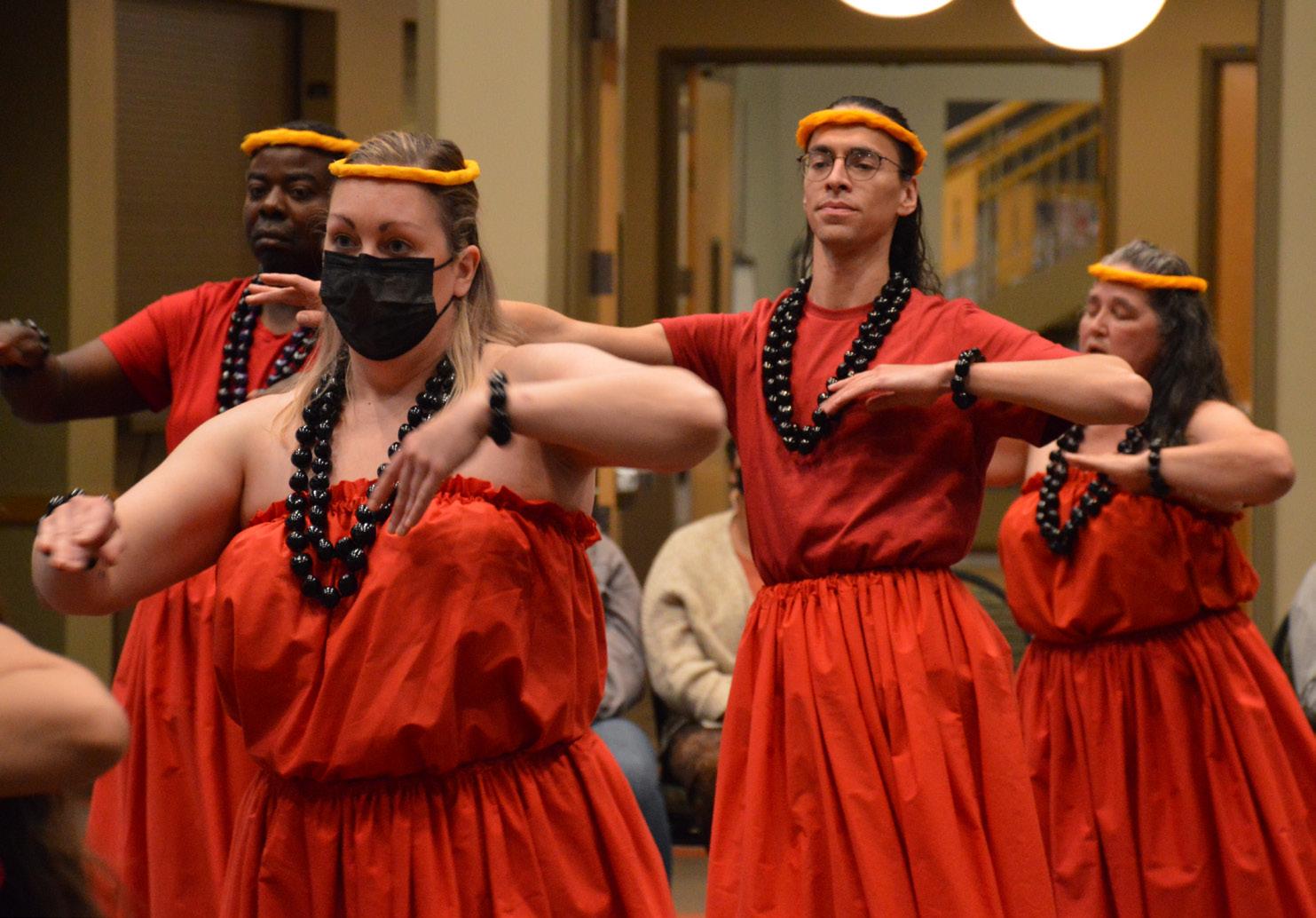
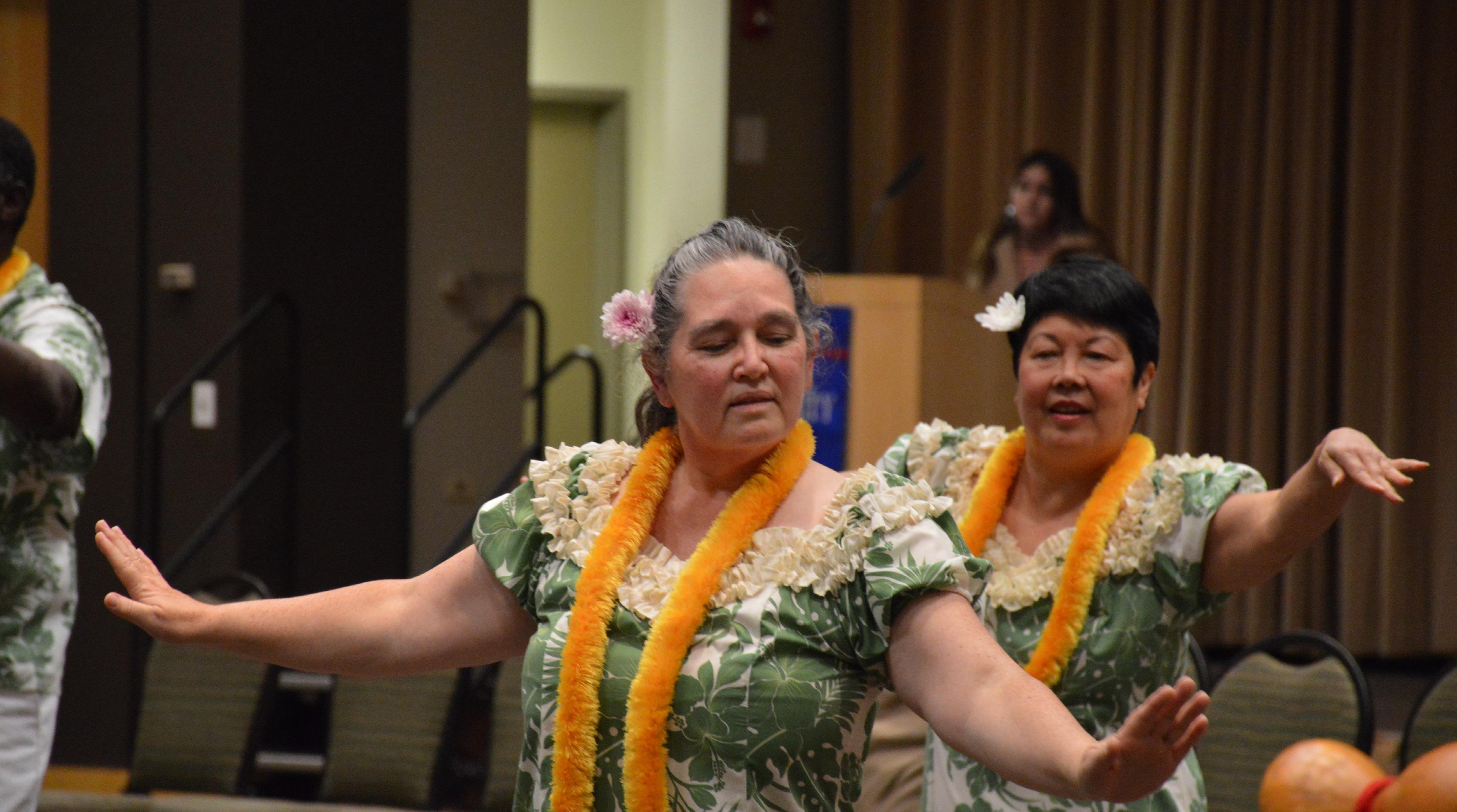
“And for me, hula is very much about healing as well as the dance,” Tanoue said.
Growing up on Hamakua in Hawaii, dancing was always a part of Tanoue’s life, eventually inspiring her to study beneath a Master Kuma - an expert teacher - before moving to Chicago in order to work full time for Feeding America, a nationwide net work of foodbanks.
One unique aspect to Tanoue’s teachings are the five values she wants her students to take away from the tradition and practice of hula.
“By spiritual, I mean, I have expectations for my students, that they practice listening, which Zen or meditation is very much about listening, it's kind of like letting things go, that clutter the mind, and they keep coming back,” said Tanoue.
Beyond listening and sacrifice, Tanoue expects her students to respect the numer ous traditions of hula, to be prepared and have patience, especially when dealing with strenuous situations.
“ These are all spiritual practice, you know, being patient with yourself, being pa
tient with others, it's a big practice,” said Ta noue. “And the best time to practice patients is when you're up against difficult situations.
Because without them, how would we prac tice patients?
DePaul Junior Frida Campos illustrated
OMSS's journey to organizing the event.
"Our coordinator [Mariela Aranda] they go through really hard work trying to find various performers and social activist groups. There are a lot of logistics involved, making sure all of the performers feel com
fortable and bringing that social justice component, and what colonizers around the world did to Indigenous groups." Campos said.
Danza Azteca Xochitl-Quetzal, led and founded by Henry Cervantes, sought to uphold the ancient Aztec culture through traditions passed down through the gener ations.
"Our history lies within our dance," Cer vantes said. "These dances are at least five centuries old so our practice is to pass on the dances as they were originally taught during pre-Columbian times."
Since the group's 2015 foundation in Chicago's Little Village, over two dozen multi-generational dancers have joined, with some as young as eight years old.
However, Cervantes does not treat the group's times onstage as an act but a learn ing experience.
"Something that I like to say is when we do cultural events like this, we are sharing our culture. So, it's an educational opportu nity compared to a performance. We're kind of just presenting what's been taught to us," Cervantes said.
Yet, beyond the energetic and captivat ing presence of Xochitl-Quetzal's members is the reason they dance.
"What Christopher Columbus and Hernán Cortés tried to do was erase us from the map. On their first day [in Mexico] here, slavery was on their minds…they thought we were an ignorant people," Cervantes said. "For these ceremonies and songs to exist, I think it speaks to the persistence and per severance of Indigenous people that we are still here."
Concluding the celebration was Ayo dele Drum and Dance, a diasporic showing of drum and dance from the feminine per spective.
As measured vibrations from hand drums and wooden sticks rang throughout the conference room, the women's group encouraged spectators to get up and dance, furthering a sense of family and community.
While Indigenous People's day has only recently been recognized in the eyes of the nation, individuals must remember to cel ebrate the lives and culture of the nation's first people and acknowledge the continual effect of colonialism.
"If you take anything away from this event today, it's that Indigenous people, their cultures, lives, dreams and struggles are still alive today," said Licón.
DePaul culture through meme pages
By Jonah WeBer Asst. Arts & Life EditorMeme pages have boomed on all so cial media platforms in the last few years, but especially on Instagram. DePaul Uni versity is home to many meme pages not officially affiliated with DePaul, but in credibly humorous nonetheless.
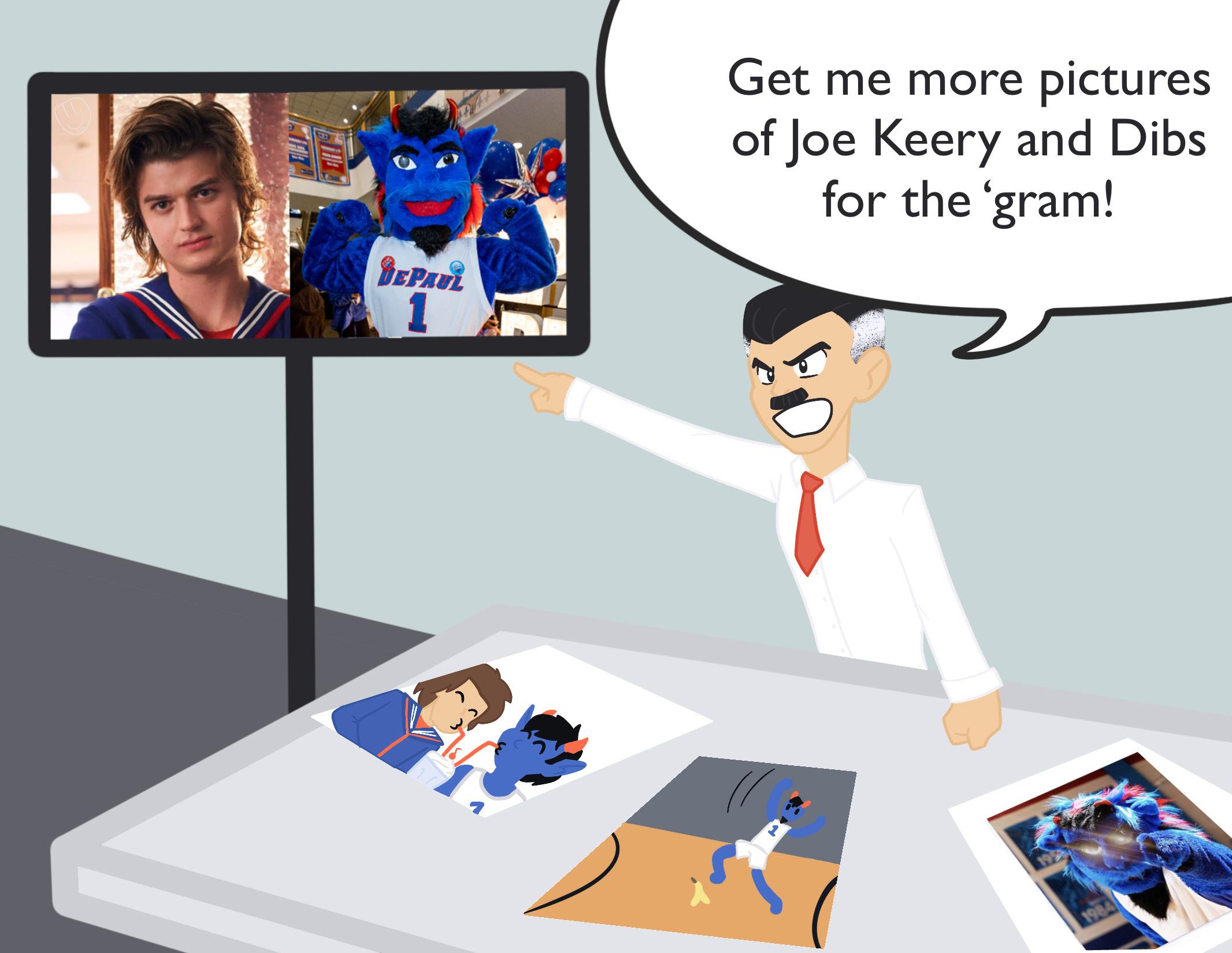
@dpuaffirmations is an Instagram page with thousands of followers. The idea is to post affirming messages and memes that are associated with DePaul.
The owner of the account agreed to sit down for an interview, but asked to remain anonymous. They shed some light on what goes on behind the scenes of the page, the beginning of the page’s life, and more.
On Sept. 7, 2021 the @dpuaffirma tions page was formed.
At the time, it was somewhat of a trend to post personal affirmations and multiple universities have their own pages.
“The whole joke and idea of it all, there is a page on Instagram called ‘afffir mations’ and they’ve got millions of fol lowers. They started the whole format and everything,” They said.
When asked if they were in touch with other universities' affirmation pages, they excitedly showed off a group chat full of these university affirmation pages titled “affirmation besties.”
“There’s just like millions of us in there. It’s like Yale Affirmations, UIC Af firmations. We’re all in touch and share ideas and memes, it’s really cute,” they said.
The growth of the page was not partic ularly planned by the creator.
“It definitely got bigger than I thought, and somewhat out of hand, but in the best way.” They said,
out loud and thought, well I think it’ll be funny and my friends will think it’s funny, so I just made it and got into it.”
overwhelming at times, the creator said, “I just didn’t expect to get all these likes, or any feedback on what I was posting.
I just didn’t expect that stuff, but I’ve made so many friends off it which is crazy and great.”
al connections were one of
the best takeaways from running the page.
“I like being anonymous, cause no one is approaching you. But it’d always be so weird. Sometimes I’d be in the stu dent center and I’d hear people affirming or saying things like “oh yeah I won’t get sick from these hashbrowns,” and I just thought that was so funny cause you don’t even know I’m just sitting here!” They said. “It was just a quirky, fun side of it.”
They said that when they were in mid dle school and high school they loved the Instagram pages based around their school that had to do with gossip, but not so much memes.
When reflecting on if they thought they would ever be running a meme page they said, “It definitely just sort fell into my lap, cause no one else was doing it and I thought I could just delete it if I embar rass myself.”
Looking to the future, the creator isn't sure whether or not they will be pass the torch of running the page.
“I have thought about it. Even this year I was sorta burnt out by it. You know sometimes you do get negative feedback, and then I wondered if it was right to con tinue it. But as the school year ramped up, I decided to keep it.”
Despite having the love, passion, and care to run the page, all things come to change.
“For graduation I’ll potentially pass it on, if it’s still relevant by then I’d love to pass it on to another freshmen so they can have the experience.”
Another DePaul based meme page that has quickly picked up quite a bit of a following is @depaulalumjoekeery.
The creator of this page also agreed to an interview, but requested to remain
was going on over the summer. My room mate and I watched the new season and whenever we did we’d call Joe Keery ‘De Paul Alum Joe Keery,’” they said.
After using this relevant nickname for Joe Keery, the creator took it one step fur
“One night, I decided to see if anyone had taken this Instagram name and no one had, so it felt like my obligation.”
Thankfully, no one had. It was the cre ator’s calling to claim the Instagram han
“And then I was like, I don’t know what to do with this page anymore and my roommate said I had to do memes. Like I did it, then texted my roommate, ‘Guess what I just did.’ It was all impulse, I do that
They explained that depending on what they post, it will get them either a lot more or only a few more followers.
They also make all the memes them selves with an app on their phone, which

“I try to wait for something to hap pen on campus for the memes. Just so it’s a bit more relatable. Or I look
up Joe Keery reaction pictures and see if I can work off any of that.”
The creator of the page shared some of their thoughts on memes and the sort of modern sense of humor.
“Back in like 2011, I wasn’t super into memes, It was around 2016 when meme pages became really big that’s when I got more into.”
At DePaul, there is another al um-based meme page called @dpu.alum. gillian.anderson.
“We have beef! Not really,” the creator of @depaulalumjoekeery said. “I always follow meme pages back, but then I saw they put Joe Keery last on one of their memes, so I made the same one and just switched their places. I don’t think they realize we have online beef.”

How would they feel if Joe Keery knew about the page, or hypothetically if he did, how would they feel?
“I don’t know if I want him to know,” they said. “My roommate and I go back and forth. Like it’d be so funny if he knew about it, but I also think I’d die of embar rassment if I knew he knew I was making memes about him.”
Coming off the shelf
DePaul Queer Book Club binds community
By Claire TWeedie SGA BeAt WriterNestled in the halls of the O’Connell Building, the LGBTQIA+ student resource center hosts a more specialized communi ty every Friday: the Queer Book Club.
Using queer literature as the stepping stone for individual growth and com munity-building at DePaul, the club has become a safe space for any and all indi viduals to explore serious topics in a wel coming space.

“There are various ways for book clubs and discussions to be led, but queer liter ature speaks to the unique experiences of the queer community,” said Black Cultural Center coordinator Ava Francis.
“It’s really important to me that there is an opportunity for not just queer indi viduals to have access to these works, but for anyone who is interested or wants to learn more.”
The Queer Book Club has only been around for two quarters and was started by the previous LGBTQIA+ center coor dinator Mycall Riley.
Now, Francis and junior Sara Fenton co-lead, helping to lead discussions and run the logistics of the club.
“Before I ran bookclub, I wasn't lead ing or co-leading any events, so this was a way to get more involved with the centers and for us to creatively utilize the space,”
Fenton said. “It gave me a queer commu nity of people who are willing to get into these intense discussions.”
They have only had the opportunity to read two books thus far due to their brief time on campus. Last quarter’s pick by the co-leaders was “Belly of the Beast” by Da'Shaun Harrison, which explores the intersectionality of anti-Blackness and an ti-fatness.
The club is currently reading “Subject to Change” an anthological poetry book by various transgender writers. When choos ing a poetry book, the co-leaders hoped to ease new members into the space without the formality of a non-fiction book.
“A lot of people don't always under stand that the authors behind these books are people too, the same as us,” said Queer Book Club member and senior Domini ca Denuate. “Literature and history com bined can help us understand that, and you get to learn about the situations that impact them today. If you can accept the past, you need to accept the present as well.”
With every book they choose and ev ery discussion held, intersectionality is one of the club’s main focuses. Intersec tionality is the concept that all systems of inequality and oppression are linked together.
While focusing on books that explore the depth of identity in the queer commu
nity and how the issues they face are con nected, Fenton hopes to incite change for the queer community on a more personal scale.
“Nobody is free until everyone is free, especially when the problems are so sys temic,” Fenton said. “When we talk about intersectionality and build community in this way, I think it gives people some reas surance that they’re not alone. The more people we can have this discussion with, the more potential there is for change.”
Building a community through the books that bring the club together is its ultimate goal. Using literature for internal reflection, members of the club are given the chance to openly discuss stigmatized or repressed topics in queer history. As members foster a sense of connection through this intimate setting and unified goal, they hope to turn the community they have built into a family.
“In the Queer Book Club, not only are you in a space with other people who ei
ther identity with you or are accepting of everything, its also just a place to make friends and find others who understand and can listen,” Denuate said.
Both Fenton and Francis believe sim ply having a space where books are the focus helps educate people in a personal setting. The club boasts a smaller mem ber count, allowing participants to feel comfortable sharing in the emotional and judgment-free space. Even when reflecting on the benefits of a smaller club size, Fran cis still looks forward to the possibility of seeing their numbers grow. Anyone is wel come to join, which will continue meeting through the end of October, every Friday from 12:00 to 1:30 p.m. in room 305 of the O’Connell building.
“As much as some of our topics are heavy, there is a sense of joy and grateful ness seeped into the space,” Francis said.
“We want more people to know we have this safe space and to experience this with us.”
Demonthon kicks off with mini dance fundraiser
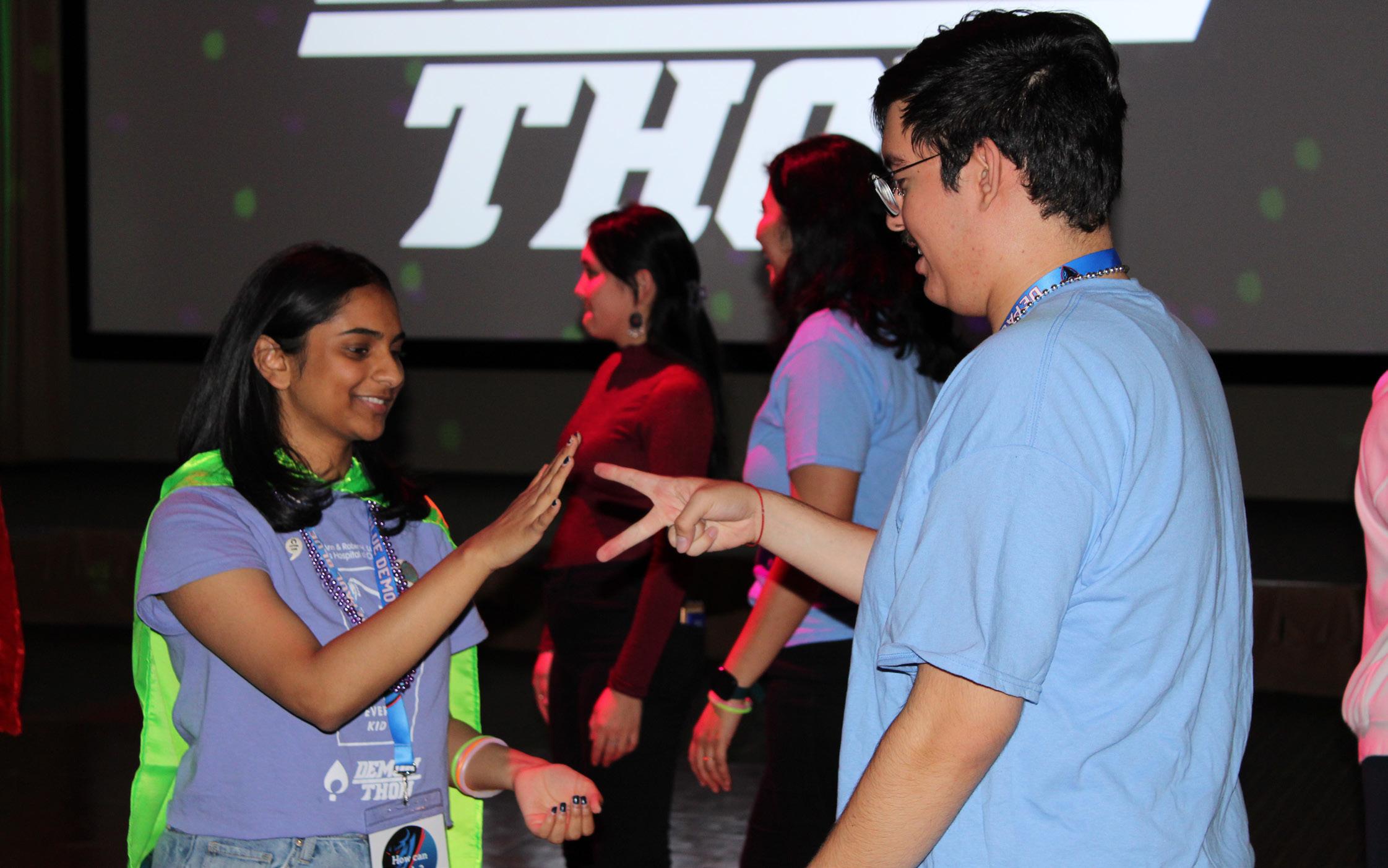 By Jake Cox Staff Writer
By Jake Cox Staff Writer
DemonThon held a “Mini Dance Mar athon” on Monday to kick off their yearly fundraising for Lurie Children’s Hospital in Chicago. The event ran from 7 p.m. -10 p.m. in the Student Center on Oct. 1 in recogni tion of Children’s Health Day and to start their year. The event included food, games, dancing, performances and a virtual visit from one of the families supported by their campaign. In addition, DePaul's cheer team and mascot, DIBS, came out to the event.
Over the past 10 years, DemonThon has raised over $1 million for Lurie Chil dren’s Hospital, via Demonthon. In addition, DemonThon is DePaul’s largest philanthropic student organization. DemonThon’s mission is to “[be an] organization that aspires to cre ate a world where all kids can be kids,” via DemonThon. DemonThon intended for this event to get out information about what their organization is and recruit some more mem bers. In addition, they hoped to give the De Paul community a snapshot of what to look forward to their “big event” in April.
“We are sending out information about our organization and we're still doing a lit tle bit of recruiting,” said sophomore Parin Sensenbrenner. “So we also just kind of want ed to let DePaul's community know what we're about and what to look forward to in April.”
The event hosted similar activities to their “big event” in April, just on a much smaller scale. The event in April is a 12-hour celebra tion of their fundraising efforts. In addition, the event in April will include appearances from “miracle families,” families who receive care that is affected by DemonThon’s efforts.
“Today is a little mini version of that [big event held in April] a three-hour dance mar
athon where we have our morale dance,” said junior Natalie Surdy.
“We do have one miracle child and her family coming in to tell us a little bit about their story.”
More than 100 students registered to at tend the event, via DeHub.
“Well, I was just walking by the event,” freshman Gulbanu Madiyarova said. “I'd heard about DemonThon before at the stu dent involvement fair, so I was really interest ed in the work they're doing. I was looking
for the community, which I want to be a part of. And I was like, that sounds really nice. I get to do something really nice for kids like donations and everything to help out like that. Also, you meet friends.”
DemonThon members had a variety of reasons for their participation in the organi zation.
“So I was actually a hospital child,” Surdy said. But I'm seeing an organization that brightened up a hospital, that brought good things to those kids who are fighting for so
many different things. It's something that touched close to my heart.”
When coming to college, students want to find a way to make a change in their new community. “I wanted to find a way to bet ter myself and my new Chicago community,” Sensenbrenner said. “So if there's any way that I can support the future and the children that are our future I want to do that.”
For more information about Demon Thon, or future events, their instagram is @ Demonthon.
The Theatre School costume sale continues this week
By lily loW ndes Social Media EditorA sparkly jacket here, a feather cape there, a shark hoodie over there. If you have seen people wearing more statement pieces on campus than usual, the costume sale at The Theatre School (TTS) could be why.
For the first time in years, TTS is selling costume memorabilia from previous produc tions to make space in its Costume Shop. The costume sale started on Oct. 4 and will con tinue this week on Oct. 11-13 from 1 p.m. to 5 p.m. in the Watt Theatre Lobby of TTS.
Students can buy jackets, period cos tumes, nightgowns, suits, scarves, hats and more at the sale. Furs are one of the more ex pensive items, priced at $25 each. On the other end of the price scale, accessories, shirts and hoodies are $5 or less. As the Wig and Makeup Shop supervisor, Jennifer Lightfoot works in tandem with the Costume Shop. According to Lightfoot, the proceeds of the sale are used to buy anything the Costume Shop needs, from raw materials to new machines to cabinets for the dye room.
“We go through our costume stock from shows periodically and clear out some stuff that we just don’t need anymore, whether it’s old or it’s just we have too many things, and then we sell it and support stuff we need in the Costume Shop with what we make from it,” Lightfoot said.
Because the sale hasn’t happened since before the start of the pandemic, Lightfoot says that this stock of costumes is larger than what they normally sell.
Those who have been around DePaul might recognize some of the items being sold. Alix MacDonald, a stage management major who was working at the costume sale, said she enjoyed watching students’ reactions as they sort through the clothing racks.
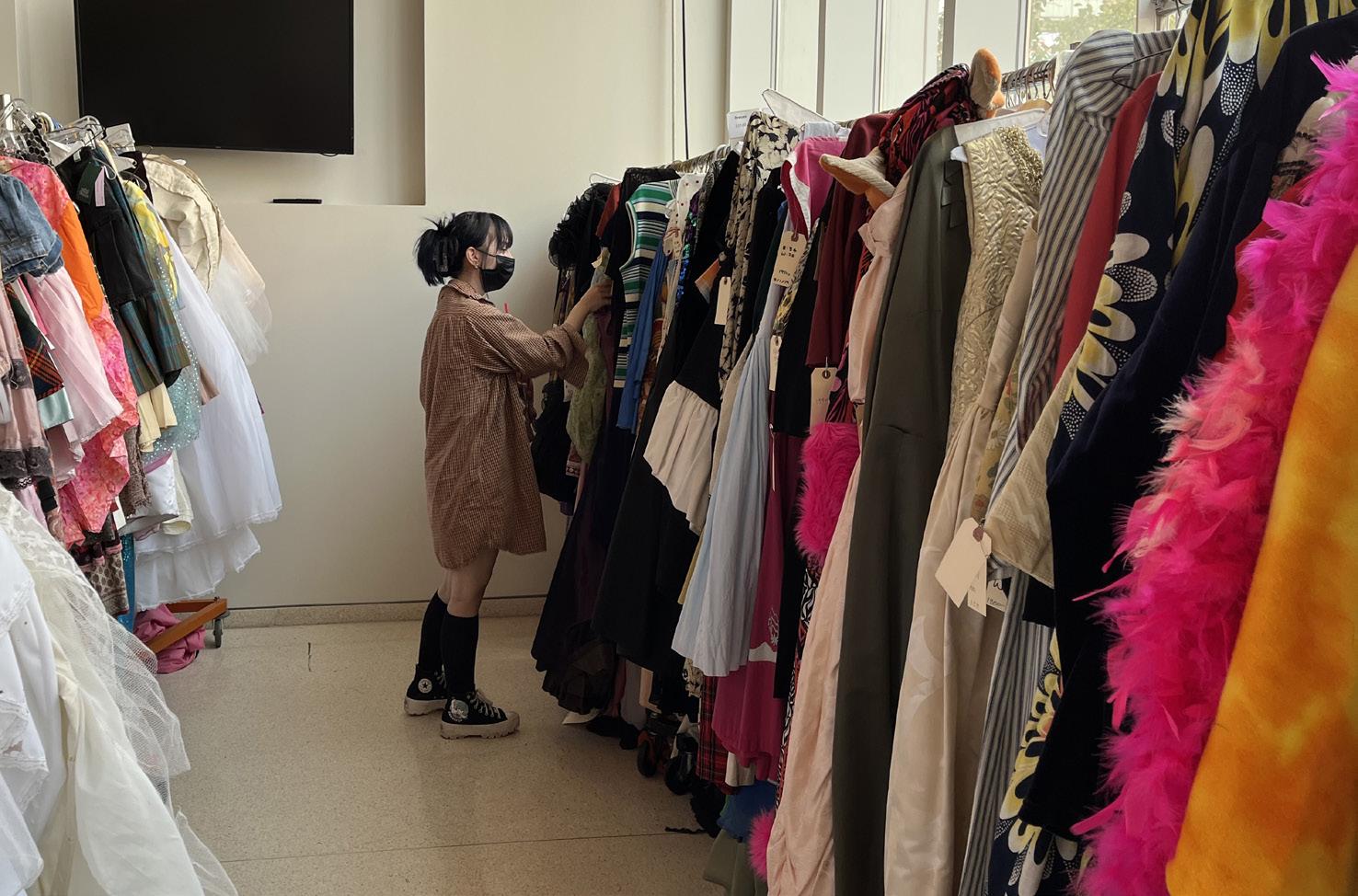
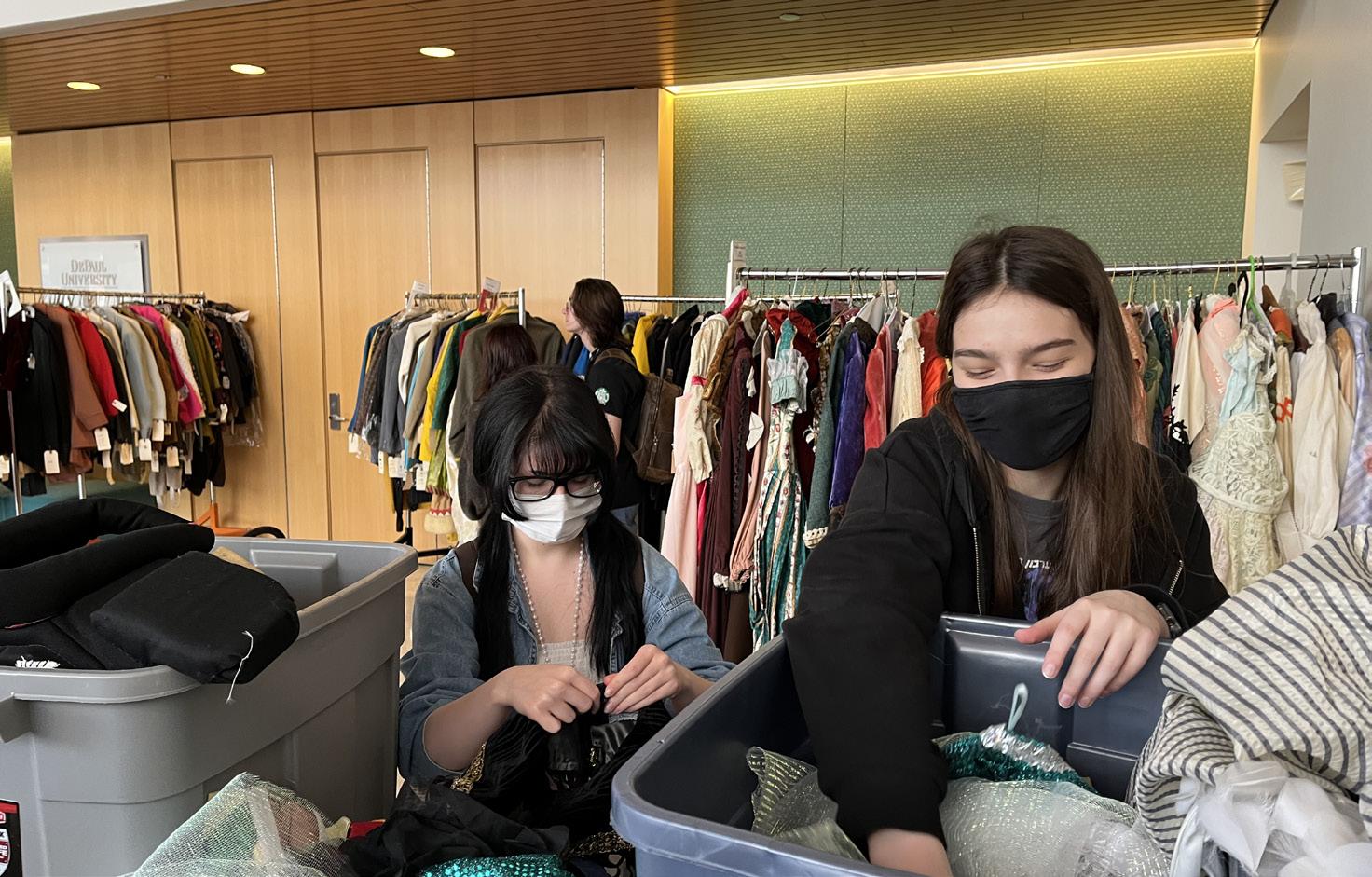
“It’s fun to see a lot of students see cos tumes that they’ve seen in shows before,” Mac Donald said. “They’re going through things and they’re like, ‘Oh I saw that in a show that I did recently’ or whatever it might be.”
Many of the items still have the costume tag attached, indicating what show it was used for or who wore the item. According to Mac Donald, some students walked out of the sale with costumes worn by famous alumni.
“Some Joe Keery tagged stuff was sold, which was really cool,” MacDonald said.
Keery is a notable alumnus of TTS. After graduating from DePaul in 2014, he went on to star in one of Netflix’s biggest original series,
Back to Basics
“Stranger Things.”
One might expect a Joe Keery costume to be expensive, but his old theater duds were standard price. The most expensive item at the sale was a $200 set of band suits with matching hats, jackets and pants from a production of “The Kid Who Ran for President.”
Some students were drawn to unique clothing items that made them stand out.
Trey Allwood purchased a pink bomber jacket with a turquoise feather print overlay and pink sewn-in armpit wings. His friend bought a matching jacket so they could show up to class in coordinating outfits.
“I plan on wearing this basically any time that I actually can,” Allwood said about his purchase. “I don’t know what the dress code is for most of the events that go around here, but I will wear this if it is permitted. I’m going to get a lot of mileage out of this jacket.”
There are more jackets available if other people want to match with Allwood.
“If anyone wants to join me, there’s a bunch of these feather jackets,” he said. “Pur chase one!”
Theater student Joseph Walsdorf scored a great find on the first day of the sale. Walsdorf bought a shark hoodie on the first day of the sale and started wearing it the very next day.
“I mean, there’s so much good stuff here because everything that The Theatre School has made or put on a stage, they work really hard to get together,” Walsdorf said.
Other students noticed people wearing their newly purchased costumes and hoped to find something for their own closets.
“I saw a girl with a sparkling jacket in one of my classes and I knew I had to check it out,” Sofia Mota said.
Students enjoyed the first week of the sale and encouraged others to check it out when it opens again this week.
“I’d say just go for it,” student Hao Ha said. “There’s a lot of really interesting stuff. Person ally, a lot of it isn’t for me, but you know, I think there’s something here for everyone with the diversity of pieces that they have, and prices are good too.”
Students find style in a sea of changing trends
By laura k aTherine Tooley Contributing WriterAs the seasons change, DePaul students are leaning into the back of the closet to their fall fashion favorites. The trends that come with the seasons echo the ever-increasing pace that modern trends change. Style is a large part of how people can express them selves. People choose clothes as a way to express their personalities. In the world of clothing and fashion, there are trends that de termine what styles of clothing are popular in the mainstream. The rise of technology and social media can create more exposure for these trends. Sophia Klevit, DePaul junior, commented on the trends she thought were coming back this fall.
“I think a lot more sheer material in streetwear and continuing to see low rise pants over high waisted,” Klevit said.
For Klevit, fashion is an important tool of expression because it is a reflection of one’s personality, nobody’s fashion is exactly the same. Fashion can mean something different to different people.
“I love that everyone has a completely different outlook on fashion,” Klevit said.
Corinna Carlotti, DePaul junior, thought that the next trend would be casual workwear.
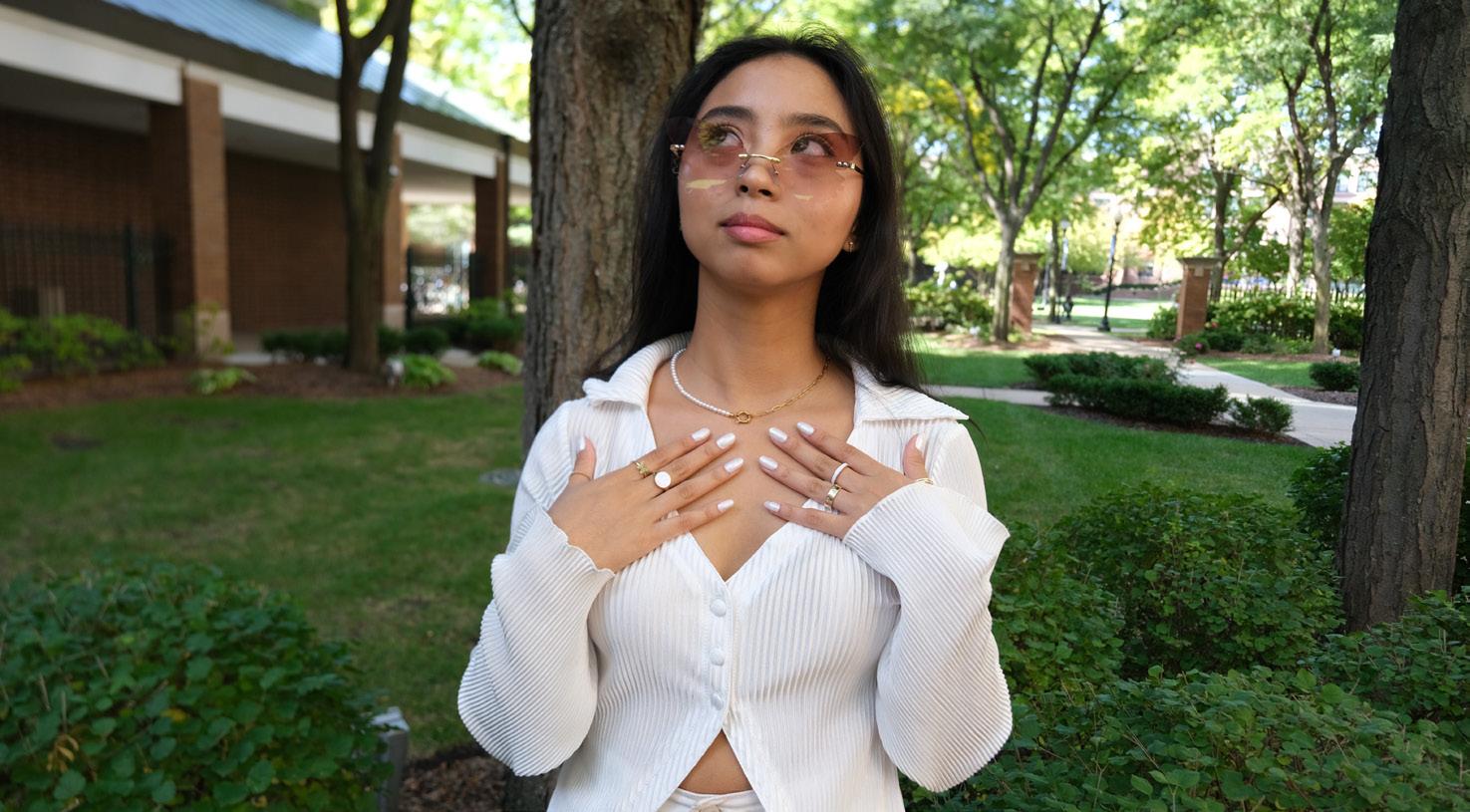
“A blazer can amplify a look to the next level while being gender neutral... it’s genius and it’s classy,” Carlotti said.
For Catarina Calicdan, DePaul junior, a simple leather jacket is the trend this fall.
“I think those are always going to be icon ic to fall,” Calicdan said.
Trends are also on their way out. For Calicdan, it is the suede mini skirt. For Car lotti, it is the corset. The internet and social media's role within inspiring trends and fast fashion cannot be overlooked. Klevit ex plained how social media creates a lens into any and every fashion trend.
“We can see a little too easily what people are wearing and what everyone thinks of it,” Klevit said.
These trends could affect how people cre ate their own personal style. With a focus on trends and what is popular, people may be less likely to work on curating timeless piec es for their wardrobe. Fast fashion can also affect trends, with quick turnover of pieces and more cheaply made clothing. Accord ing to the California Public Interest Research Group, 85% of clothes in the U.S. end up in landfills or burned.
“Because we have online shopping it’s so much easier to fall into that, and in a way we lose some of that individual style and really curated pieces,” Calicdan said.
A way to combat fast changes in popular style is to create a personal style outside of the pattern of trends. One of the best ways to cre ate a personal style is to start with the basics. Having well-made basic pieces helps create a solid base to add statement pieces on top of.
“I think it’s important for people to find what speaks to them and learn that it’s really okay to pull basic pieces from a trend
and wear it after the trend is over,” Calicdan said. “It makes it more individual to you instead of just following the crowd.”
Finding basics helps ground a personal style and create something unique to a per son’s taste. For Carlotti, it reflects the nature of fashion.
“Fashion is everything and it’s nothing,” Carlotti said. “It’s a blank canvas that allows you to do as much or as little as you please. There is no inherent right or wrong.”
In response to rapidly changing trends, steering away from fast fashion websites is helpful.
Smaller stores sell more sustainably made pieces that can last longer than clothing pieces from larger stores. Thrift stores are also
a way to find personal style. These stores do not sell new pieces, but instead sell curated or donated clothing.
Some pieces are timeless. For Car lotti, it is a turtleneck. Especially for fall, Carlotti says a turtleneck accentuates the neck, and is a great way to be fashionable and warm. For Calicdan, the timeless trend is the little black dress. She described them as having a timeless look and a piece that can be styled many ways. Klevit says her favorite timeless piece is the leather jacket.
Trends dominate fashion, but the core is self-expression.
“I love that fashion has no standard,” Car lotti said, “No one can tell you no in fashion.”
The life and legacy of Sacheen Littlefeather
By JaCoB CosTello Chief Film and TV CriticOn Oct. 2, 2022 Sacheen Littlefeather passed away after a lifetime battle with lung cancer after living a life with roles, including an actor, model and activist. Littlefeather is perhaps best known for her work in raising awareness for Native Americans and fighting for equality.

Littlefeather is best known for her ac tivism and in particular her appearance at the 1973 Academy Awards where she advocated for better representation for Native Americans in movies.
Littlefeather grew up in California. Her father was of Apache and Yaqui an cestry. After her parents split, she spent the rest of her childhood living with her grandparents. She was active in her high school’s 4-H club, an organization devot ed to conservation and environmental ism, and went to college to study educa tion. In college she began to embrace her Native heritage and became active in pro tests. In particular she participated in the Native American occupation of Alcatraz. She also started her career as a model and small-time actress, appearing in various guest spots and commercials.
While pursuing her modeling and acting career, Littlefeather was unwav ering in her mission for equal treatment for Native Americans. She was active in the fight for Native Americans to relieve equal treatment and was the spokesper son for the National American Indian Council where she criticized President Richard Nixon for his budget cuts to pro grams designed to help the Native pop ulation.
Her “big break” came at the 1973 Academy Awards, when representing Marlon Brando. Brando and Littlefeather became friends due to their mutual inter est in civil rights. At the ceremony, Bran do won Best Actor for his role as Vito Corelone in “The Godfather.” Instead of
accepting the award, Littlefeather went to the stage on his behalf and declined the award and said this.
“I'm Apache and I am president of the National Native American Affirmative Image Committee,” Littlefeather said.
This moment was shocking to Hol lywood’s rich and powerful, and this speech got Littlefeather blacklisted al most immediately
Littlefeather spent the rest of her life actively pursuing causes of social justice. From changing offensive mascots, raising awareness for AIDS and creating Native American theater troupes, Littlefeather was a woman who did everything she could to help every person she could.
Unfortunately, Littlefeather was plagued by health issues for most of her life. Her lungs collapsed at 29 and she de veloped both breast and lung cancers.
Elijah Valter, a film student at DePaul, was saddened to learn of Littlefeather’s passing.
“One thing I loved was that she was truly for her cause,” Valter said. “She did not care about losing out on roles or pho toshoots. She used her platform to advo cate for the right things even when it cost her career to do so.”
Littlefeather was an important figure to those with Native roots like DePaul Education major Jocelyn Buether.
“She was the embodiment of a strong woman,” Buether said. “It is honestly so inspiring that she spent almost all of her life raising awareness for her causes even when everyone else turned against her.”
Haydon Mayer is another DePaul film student affected by Littlfeather’s passing.
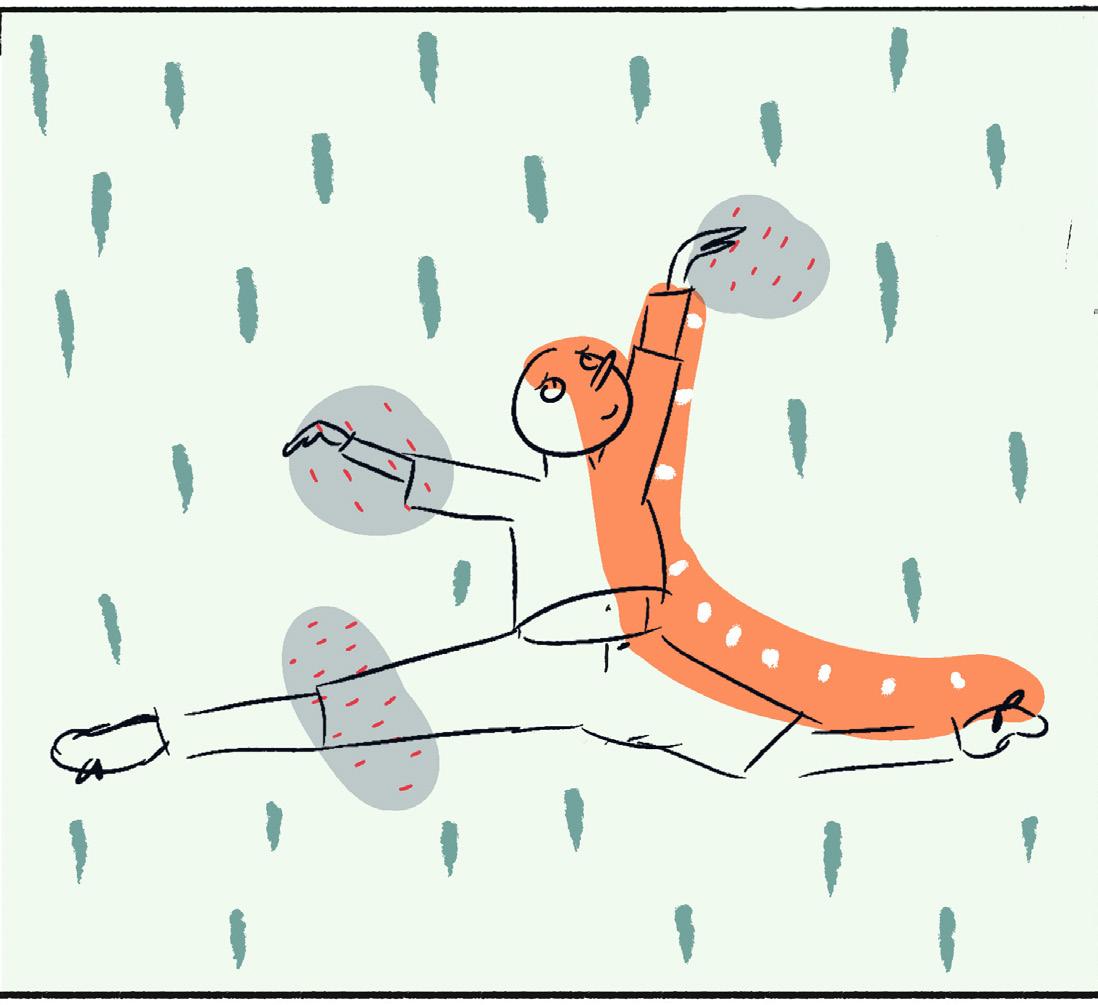

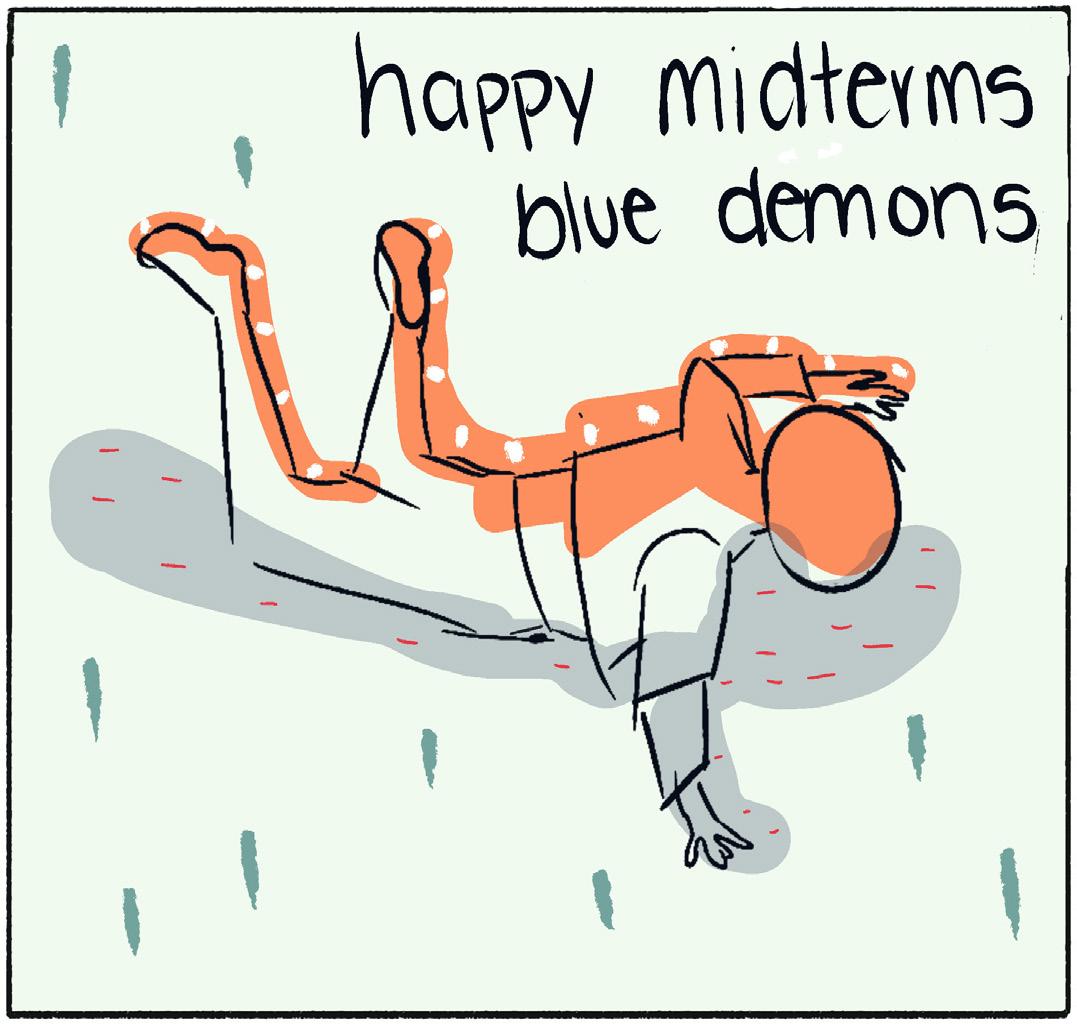
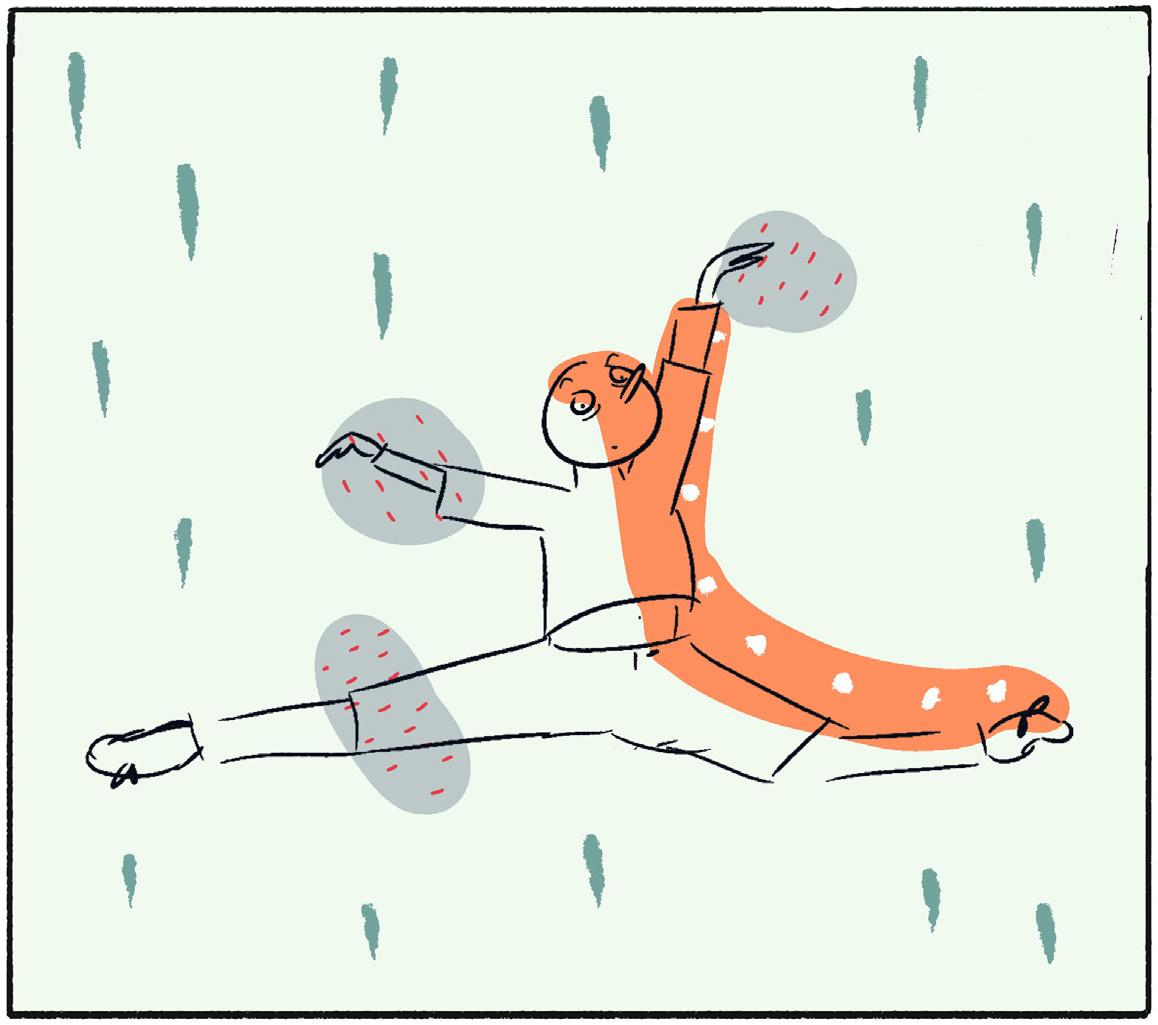

“I found out about her after the Will Smith slap thing earlier this year when I was reading about the worst things that had happened at the Oscars,” said Mayer. “It was disgraceful and disgusting how she was treated and really shows how messed up the Oscars are.”
Littlefeather leaves behind a legacy of always standing up for one’s beliefs, even when everyone else in the room is not. She was a person unafraid to advocate for causes she believed in, no matter what obstacles were in the way.
“The reasons [for declining the award] are the treatment of American Indians today by the film industry — excuse me — and on television in movie reruns, and also with recent happenings at Wounded Knee.”PHOTO FROM IMDB Sacheen Littlefeather, Native American activist, passed away on Oct. 2 2022.
Rob Zombie’s Plastic Dreams
By eThan M aTTheus Staff WriterThese days, naturalism in film is treated as the default. Even in science fiction or fantasy films, where the principles he genres operate under are plainly ludicrous, realism in acting, dia logue and aesthetics are still prioritized above anything else.
A few brave artists swim against this current: the acting of Nic Cage, the films of Wes Anderson and the works of Rob Zombie.
Indeed, “The Munsters,” Zombie’s latest film, is an exemplar of this “an ti-realism,” where the lack of any adher ence to reality becomes its own style.
Rob Zombie initially rose to fame as the founding member of the heavy metal band White Zombie. The band gained notoriety for their grandiose live performances and eclectic musical influences which drew from both high and lowbrow musicians and artists.
Following White Zombie’s breakup in 1998, Rob Zombie started directing movies consisting mostly of homages to the horror movies of years past.
His directorial style has polarized critics, with his films either drawing ire or praise.
His latest feature, “The Munsters,” is a prequel to the 1960s series of the same name and follows the titular characters as they journey from Transylvania to start a life in California.

The plot itself follows Herman Munster, a reassembled corpse with the brain of a comedian, who catches the eye of Lily, a 150-year-old vampire.
They get married, but disaster strikes when Lily’s father, The Count, is
evicted. Herman decides that the only option is to relocate to California.
Admittedly, the plot sounds incred ibly haphazard, and this is the general approach Zombie adopts when it comes to storytelling.
The actual specificites of the narra tive are incidental and meandering, but that is all beside the point.
Zombie is far more interested in capturing the fake and plastic aesthetics of the original series and then filtering them through his auteurist lens.
If any quote captures “The Mun sters’” essence, it is Roger Ebert who wrote: “It’s not what a movie is about, it’s how it’s about it.”
It is almost moving how all encom passing Zombie’s love of horror is. Out
side of his music, he is most well known for making the films “House of 1000 Corpses” and “The Devil’s Rejects,” both of which are heavily indebted to seventies’ grindhouse horror and eight ies’ slasher pictures.
Everything about “The Munsters” screams subterfuge.
The lighting is so garish, the cuts so comical, and the acting so over the top that you cannot help but be drawn into it.
Zombie takes the aesthetics of the original show and mutates them into a bizarre, neon-drenched plastic world where everyone talks with the same stiff affect and moves as though they are in a pantomime.
All this might sound like a back
handed compliment, but it really is gen uine admiration. Watching a film that is so committed to its own tone is striking. These days, every mainstream picture seems diseased by a certain “cute sy-fication,” where the creators are compelled to say, in the most twee and self aware way, that they are above the bizarre aesthetics of their films.
“The Munsters” stands in opposi tion to this practice.
However, the film is not without flaws.
As previously mentioned, the story is almost indecipherable with numer ous plot lines either being abandoned mid film or characters having close to no motivation.
Zombie is afforded a certain amount of leeway since “The Munsters” is a children's film, but that does not excuse how lazy and obvious the comedy in the film is.
The fundamental problem is that the narrative is secondary to the aes thetics, and although that makes for an interesting stylistic experiment, it does not manage to sustain itself for 110 minutes.
If Rob Zombie was a more tech nically competent screenwriter, “The Munsters” would have been able to syn thesize the originality of his vision with an engaging narrative.
Sadly, this is not the case.
The sheer audacity of the film’s vi suals almost overwhelms the senses and stands in stark contrast to the current mediocrity that passes for streaming, yet “The Munsters” still cannot fully ac tualize. Perhaps Zombie’s future filmic endeavors will prove different.
'Dahmer': An unsettling but worthwhile watch
By erin henze Assistant Photo EditorThe name Jeffrey Dahmer likely rings a sinister bell for most of those who hear it.
“Monster: The Jeffrey Dahmer Story,” a lim ited Netflix series directed by Ryan Murphy, details the life and crimes of the infamous Milwaukee Monster, played by Evan Peters. This is the latest installment in a collection of Dahmer biopics since former Disney channel star Ross Lynch portrayed the killer in the 2016 movie “My Friend Dahmer.”
Each episode hops from year to year, showing glimpses of Dahmer’s childhood and adult life. Perhaps the most compelling aspect of the show is the unnerving peek we are given into Dahmer’s youth, particularly his early interactions with his father.
In an attempt to connect with his de tached son, Lionel Dahmer (played by Richard Jenkins), takes to participating in the one activity young Jeffrey seems to find pleasing: dissecting roadkill and examining the innards.
What began as a father’s wayward at tempt to connect with his son turns into an equally tragic and horrific moment that gives the viewer some explanation as to why Dahmer acted as he did. In the last episode, Jenkins delivers a gut-wrenching perfor mance during his last-ever meeting with his son.
He tearfully responds to Jeffrey’s claim that the roadkill dissections are what sparked his morbid fascination with the hu man body, saying “This is not my fault! I did not do this to you.”
It’s a very painful moment and one that is conflicting for the audience. Both par ties are at fault, but how can such a bloodstained hand point the finger at anyone be sides himself?
Peters’ uncomfortably convincing por trayal of Jeffrey Dahmer is a marvel to be
hold on the screen. Along with bearing much resemblance to the serial killer, Peters also nails the Wisconsin accent and creepy mannerisms of the murderer. Stealing the show from the titular character, however, is Niecy Nash. Nash portrays the fiction al version of Dahmer’s real-life next door neighbor, Glenda Cleveland. During the three years in which the two lived in the same building, Cleveland made dozens of 911 calls because she could hear screams and loud mechanical noises coming from Dahmer’s apartment, as well as smell a very strong odor of rotting meat.
Nash perfectly captures the despera tion and fear that Cleveland must have felt during those years, knowing that murders were taking place next door but being able to do absolutely nothing about it. This brings us to the real story within the story: the complete incompetence of the Milwau kee Police Department. Despite the dozens of frantic phone calls made by Cleveland, police officers never showed.
Coincidentally, Dahmer lived in an apartment complex on the low-income side of town where the majority of residents were people of color. Dahmer was also a known homosexual who preyed primarily on other gay men of color.
Now, enter a collection of racist Mid west cops in the middle of the HIV/AIDS epidemic and come to your own conclusion as to why the MPD never answered Cleve land’s pleas.
The series highlighted several instances where, had the police done their job even remotely properly, Dahmer would have been jailed before precipitating as much damage as he did.
On one occasion, the stench of rotting meat coming from Dahmer’s apartment had gotten so bad that the entire floor had called to complain about it. The police ar
rived to assess the situation, which involved two police officers stepping inside Dahmer’s apartment for 30 seconds and then leaving because they didn’t want to “catch anything.”
Had they looked around, they would have found a fresh dead body in the bedroom along with severed body parts and organs in the fridge, including an entire human head.
Not only did the police do nothing to prevent Dahmer’s crimes, they actually aided in his murder of a 14-year-old boy. Dahmer lured the child to his home and drugged him, but he escaped and stumbled out onto the street where Cleveland found him and called the police.
The police arrived, but because the boy was unable to speak due to the drugs, the police led him back into the apartment after hearing Dahmer’s convincing claim that the boy was actually his 19-year-old boyfriend who had had too much to drink.
Later that evening, Dahmer proceed ed to drill holes into the boy’s head and fill them with acid in an attempt to create a hu man zombie.
“Dahmer'' is a disturbing, multi-faceted

watch that succeeds in every department but one: paying tribute to the most import ant and often-overlooked aspect of the sto ry: Dahmer’s victims and their families.
Many are calling for the show to be re moved from Netflix due to its insensitivity to the families of Dahmer’s victims.
The sister of Errol Lindsey, one of Dahmer’s victims, told Insider that the show forced her to relive the trauma all over again.
Another relative of Lindsey referred to “Dahmer'' as a traumatizing media grab that attacks the black LGBTQ+ community.
The families were not made aware of Netflix’s intention to produce the show or asked for their opinions, despite the fact that it portrays their real-life selves.
Director Murphy sometimes gets lost in his attempt to characterize one of the world’s most notorious serial killers, occa sionally romanticizing Dahmer and his be havior when he should have been focusing on honoring the innocent lives taken at the murderer’s hand.
St.Vincent’s
D e JAMZ
“Spinning freSh beatS Since 1581”
 By Jonah WeBer
By Jonah WeBer
With it being my first time having the honor of doing DeJamz, I wanted to be on theme in two ways. One, a personal ritual of mine every week is celebrating Metal Monday.
I listen to metal music and all its sub genres, throughout Monday.
I also decided to keep the great Vin centian question in mind, “What can be done?” So these metal bands asked “What song needs a metal cover?”
Gimme! Gimme! Gimme! (A Man After Midnight) - Unfound Reliance
Unfound Reliance may not be the most well known metal band, but they sure know how to cover a relevant song.

This Abba classic has been all over social media for the past few months, and Unfound Reliance decided it needed a groovy, heavy, metal cover.
Blue Monday - Orgy
“Blue Monday” by New Order is a 1980s classic.
It’s hard to imagine that song getting any better, but in 1998, the metal band Orgy covered it, and somehow elevated it.
The vocalist, Jay Gordon asks the heavy question, “How does it feel to treat me like you do?” in an intense, rhythmic tone. Personally, I love this cover more than the original.
Children Of The Grave - White Zombie
Originally done by the legendary Black Sabbath, “Children Of The Grave” is already a metal classic.
In 1994, a compilation was created by multiple metal bands titled “Nativity In Black: A Tribute To Black Sabbath.”

Out of all the covers on this album, White Zombie’s stands out. Led by the amazing Rob Zombie, the industrial twist
on this classic is incredible.
I’m Gonna Be Your God - Slayer
While this may not be a direct cover, it’s very much Slayer’s twist on “I Wanna Be Your Dog” by The Stooges.

This sensual, rough, and hardcore twist keeps the same rythm and similar lyrics, with just a bit more direct conno tations. It’s a great late night headbanger.
Word Up! - Korn

In the past few months I’ve decided I’m done with pretending Korn isn’t fan tastic. Are they super weird? Absolutely. Does the fan base make me a little un comfortable? Sure.
None of that matters though. And this cover of the 1980s classic is so fun.
Everytime I hear Jonathan Davis in the intro say “Y'all pretty ladies around the world…” I immediately smile and start headbangin’.

Sports
Chicago women find solace at identity-specific gyms
By Ruchi Nawathe Nation & World EditorMany women feel uncomfortable working out in unisex gyms. Tight workout clothing feels all the more re vealing while squatting or bending over in front of men. Exercise machines are often calibrated to suit men’s bodies, and many men have demeaning attitudes towards women in gyms.
Karen Barrie, 74, has exercised at Curves on Devon Ave. for around 20 years. Barrie, who has worked out at gyms regularly since she was 28, has never seen better results since going to Curves.
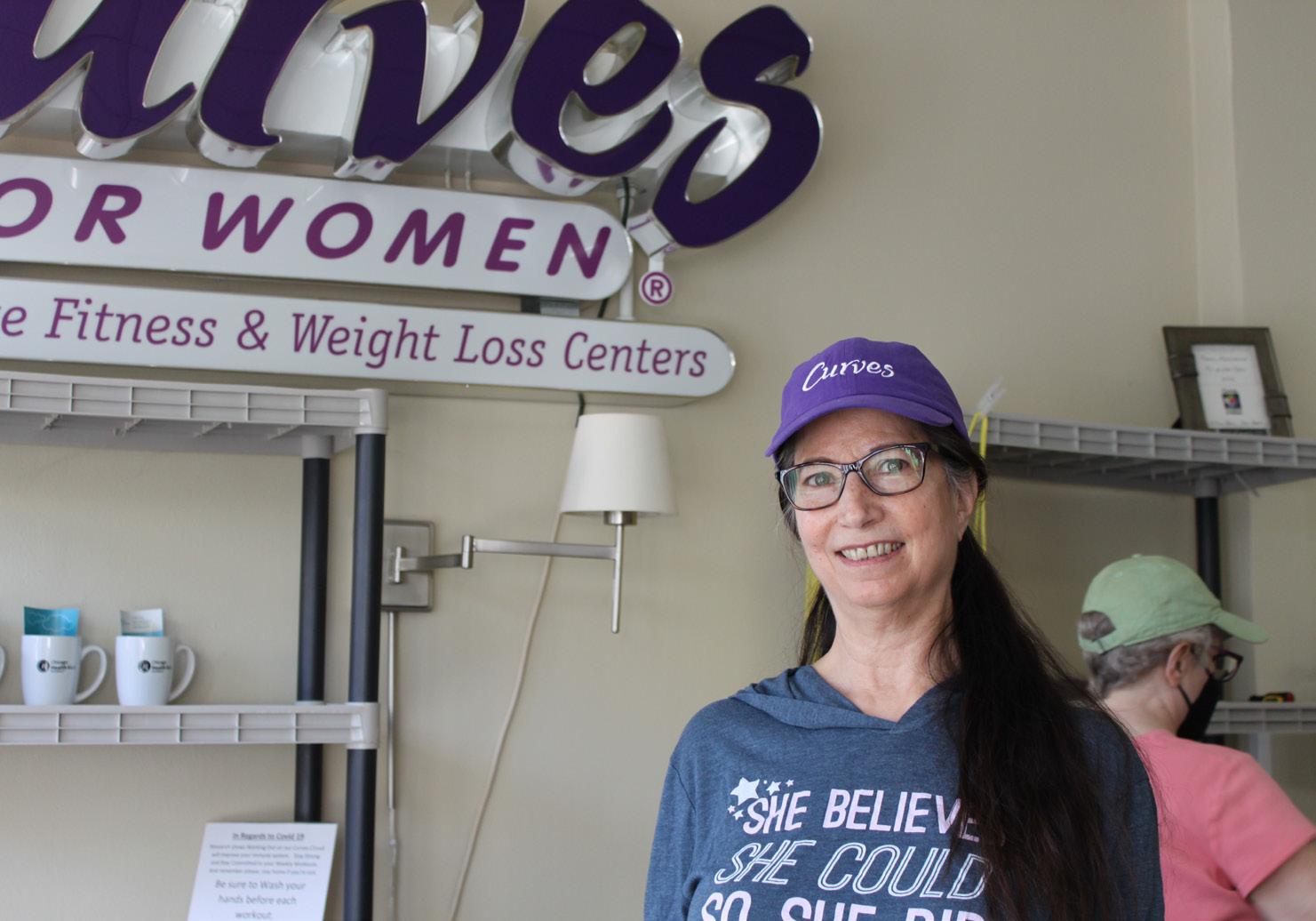
“I was not in bad shape when I joined Curves,” said Barrie. “In two months, I weighed the same... but the shape of my body, and where muscles were building and where I was getting a little more curvaceous, it really began to show up.”
Curves is a women-only gym with locations all over the country. The program features a 30 minute workout designed to be as effective and safe as possible.
“The machines are specially de signed for a woman’s body,” said Curves coach Maria Garcia. “Our bodies are different than men’s, for example, our stretching station. The workout before hand gives microtears in the muscle tissue. When the muscle tissue heals, we want it to heal long and lean, where a man wants mostly to have it bulky, so af ter our workout we have them stretch... to turn them into long and lean position and then they heal.”
Curves’ program is made to be accessible to the widest range of women possible.
“Our youngest is 11 years old and our oldest... she was 88,” Garcia said.
The exercise machines are resis tance-based, which means that the ma
chine adjusts its difficulty based on the strength level of the person using it.
“You really would have to do some thing ridiculous to hurt yourself on the machines,” Barrie said.
Many women-only gyms have taken a financial hit due to the pandemic, but Garcia is determined to keep Curves open despite slower business.
“One of the reasons I kept the gym open, even though it’s not as profitable as many businesses are, is because I per sonally like working out where I don’t have to worry about any man looking at me and my positions that my body needs to be in to be healthy,” Garcia said.
DePaul senior and women’s soccer team member Kristin Boos has been subject to unwanted stares in the past.

“The toxic masculinity and degrad ing looks that are projected onto me when comparing myself to men is drain
ing,” Boos said.
Boos believes in making safe spaces available to those who require them.
“I think that making all people feel completely comfortable and safe is so important,” Boos said. “Unfortunately, in the world today, there is an anxiety that women feel around men because of the high numbers in sexual assault.”
Unwanted stares are not the only reason people would want to work at a women’s only gym.
“There’s a lot of women who have religious restrictions. They can’t take off their burkas with a man in the environ ment,” Garcia said.
Rachel Stansberry is a DePaul senior and employee at the Ray Meyer Fitness and Recreation Center, “The Ray.” The Ray is a unisex gym, but employees try to make the environment more comfort able for female gym goers.
“I know from a lot of certain peo
ple’s experiences sometimes, people get intimidated when there are more men, so I know we try to have as many spaces available to make sure we keep the flow of everything going,” Stansberry said.
In addition to secluded sections of the gym, there are spaces available for only women.
“We have some fitness classes that are just for women, like we have some that are called ‘women on weights,’” Stansberry said.
Barrie enjoys the sense of camarade rie that comes with exercising in a room full of women, especially since Curves has a loyal and consistent customer base.
“It’s like yin and yang,” Barrie said. “There’s a lot of yin energy in this, and I think for a lot of women who don’t have great self-esteem, who maybe they were subjects of abuse in their life, I mean there’s nothing like sisterhood.”
RUCHI NAWATHE | THE DEPAULIA Karen Barrie participates in a 30-minute workout program at Curves gym on Devon Ave. The 74-year-old has been exercising at Curves, a women-only gym, for about 20 years.“Unfortunately, in the world today, there is an anxiety that women feel around men because of the high numbers in sexual assault”
Kristin Boos
DePaul women’s soccer senior
Demons remain undefeated, take down Marquette 7-1
By Preston Zbroszczyk Asst. Sports Editor
The Blue Demons cruised by Mar quette in last weekend’s series, improving to 7-0 on the young season.
DePaul has scored 54 goals as a team through their first seven games, and only surrendered 17 to their opponents thus far this season.
“I think all the guys here, we expect
to go 20-0,” sophomore winger Matt Newton said confidently. “That is what is want we expect. Everybody is competing super hard in all the practices and we ex pect to be one of the best teams in our league.”
Two minutes into the game on Friday, senior winger Brock Asher scored the first of many Blue Demon goals.
When the first period came to an end, the Blue Demons took a 3-0 lead courtesy
of Newton and sophomore Danny Man narino.
While most things were in favor of DePaul in their 7-1 win, they committed six penalties that resulted in 12 minutes of Marquette power play time. No goals came out of those penalties, as the Blue Demons’ power play kill was effective defensively. On offense the power play proved to be in their favor.
lead throughout the game did not give him as much of an advantage as some might expect.
“When you get a big lead on everyone else, it is point night,” Motew said. “So the defense starts to lack, but I thought we kept it in, the last two minutes we had two block shots so the guys all game kept it in.”
DePaul Center
Back
South State St.
Head coach Dan Wood spoke on the errors and mistakes and how the team turned them into positives, saying that self-inflicted miscues like penal ties have been an is sue the team needs to continue to work on.
“The big thing we’ve had is issues with penalties, but credit to our guys and our penalty kill guys,” Wood said. “They’re taking that as a way to get momentum. After we got penalties we had good shifts and scored after that, or scored on our power plays.”
DePaul hockey sophomore
Saturday saw the same result, as the Blue De mons took a 4-2 win to complete the sweep of Marquette.
The Blue Demons antici pated a stronger push from the Golden Eagles in the second game, but never shied away from their game plan by letting de fense translate to good offense.
DePaul (70) will travel to Springfield, MO. to play
Call to Preorder
Mannarino was the leader in goal scorers in Friday’s game. He was one shy of a hat trick and improved his overall goals to four on the season.
DePaul was outshot for the majority of the game and although one goal was let through by junior Asher Motew, he was able to make an incredible 47 saves on Friday.
The Blue Demons, who got out in front early, made it easier for Motew to play with a lead, allowing him to have a clean night and ease the pressure of any possible goals being let in.
Still, Motew explained that the large
Drury University for another weekend series beginning Friday, and look to keep their winning ways.
Drury’s hockey program is only in its second season of being an official team, which might mean less of a challenge for DePaul. It also means there is not much to look to learn from the team in terms of what their identity may be.
“Drury is going to be a tough match up,” Wood said. “They’re a brand new program, but fully funded by the school so they are going to be treated like a Di vision 1 program.”
The next home game for DePaul will be until Nov. 4, when they host Aurora University in a weekend series.
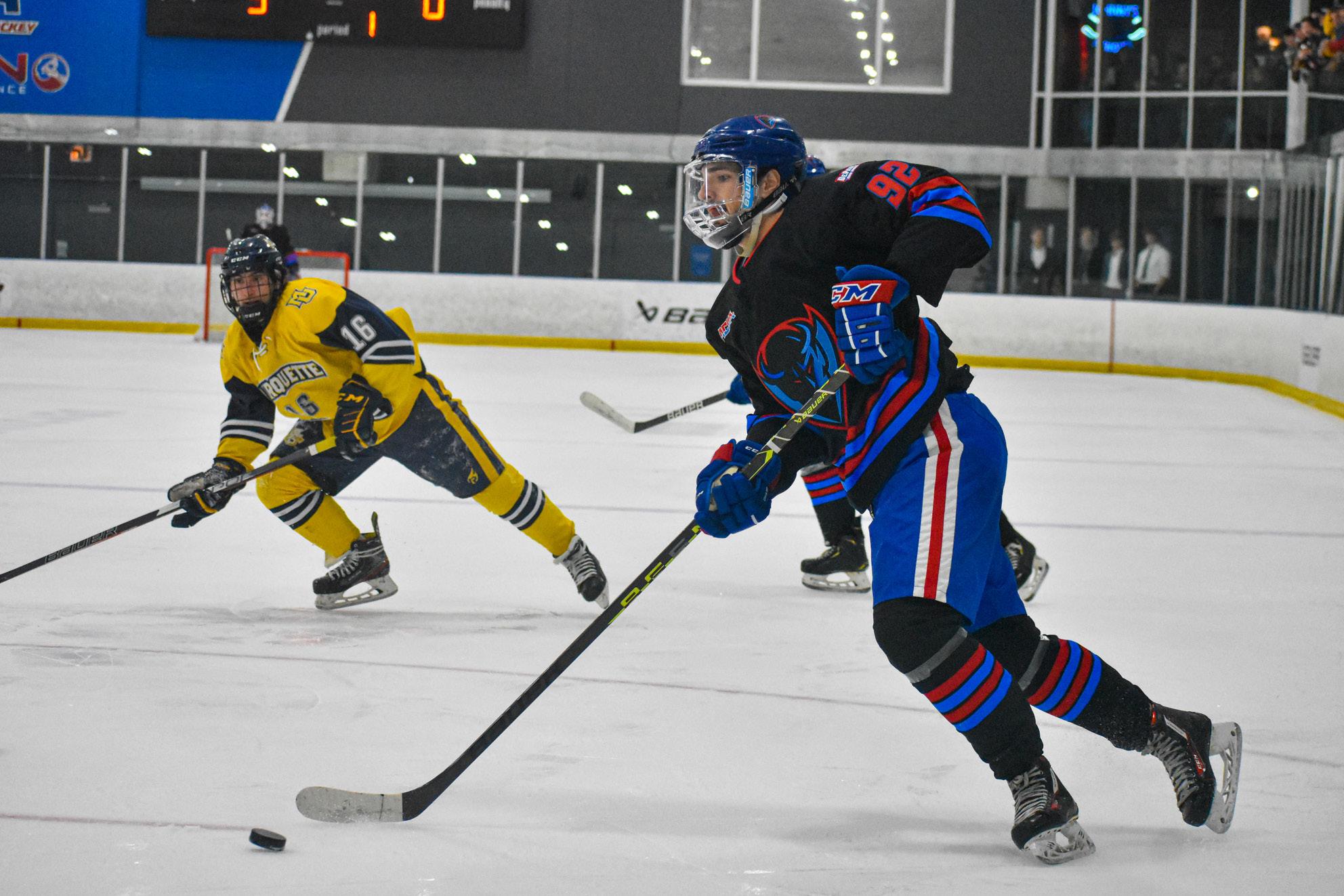
“Everybody is competing super hard in all the practices and we expect to be one of the best teams in our league”
Matt Newton
Michael Anderson breaks team scoring drought in 1-1 draw with Hoyas
By Patrick Sloan-Turner Managing EditorAgainst a perennial Big East power like the Georgetown Hoyas, playing an orga nized game is crucial to keeping your team in it.
That was the goal for DePaul on Satur day, who played host to their conference foe on a sunny afternoon at Wish Field. The Hoyas, who played in last year’s Division I NCAA Soccer final four, are always loaded with talent, making it even more vital for opponents to play a clean game.
On Saturday, DePaul indeed kept things tidy, holding Georgetown to a 1-1 draw.
“They’re a great team, and there’s a rea son why they were in the final four last year and win the league just about every year,” said DePaul Head Coach Mark Plotkin. “We told the team we’re just going to have to be organized defensively and create our mo ments.”
While Georgetown bested DePaul in possession and got the ball into the Demons’ defensive third, significant chances against DePaul’s backline were a rarity. The Hoyas recorded 16 shots on Saturday, but only six were on goal. Of those six, only a couple could be deemed genuine chances at goal.
Perhaps the most substantial feat of Sat urday’s match was DePaul’s ability to finally get the ball in the back of the net. The De mons had not scored in 17 days against three separate opponents before finally grabbing a quick goal against Georgetown.
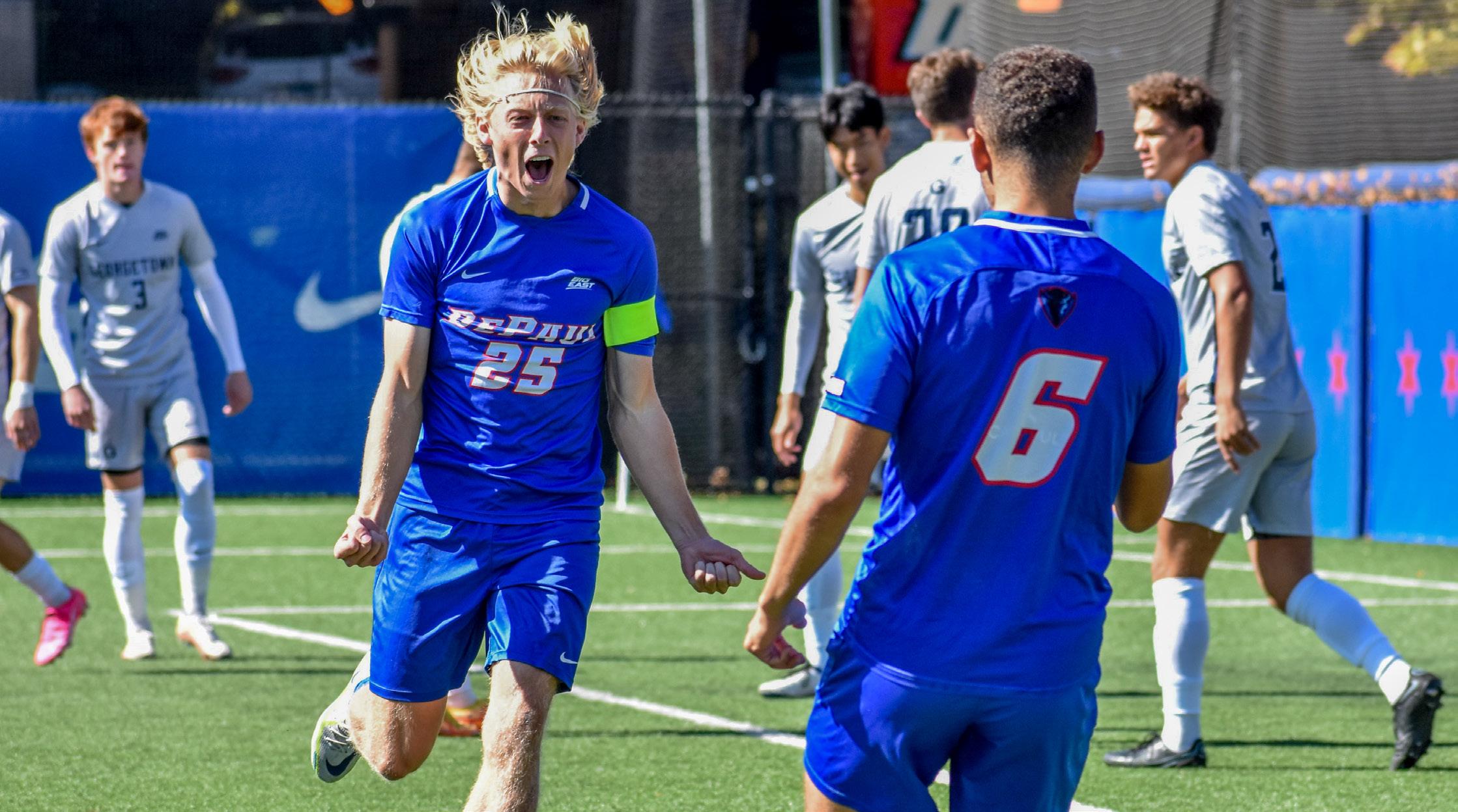
After securing an early corner kick, De Paul senior midfielder Michael Anderson made a run from the back post towards a low ball delivered from junior midfielder Omar Ramadan. The 6’1” Anderson beat defenders to the cross and fired a strong header inside the near post, giving his team a 1-0 lead in the game’s third minute.
“It’s all about the service,” Anderson said. “Omar [Ramadan] gives a great ball every time, so it’s just about that little nod into the back of the net.”
After a noteworthy goal drought, An derson was satisfied to get his team back in the scoring column.
“We hadn’t scored in the past three games,” Anderson said. “It definitely felt good to get that early goal to get our legs moving again and get back on the scoring
train.”
While Anderson’s second goal of the season was a nice early highlight, the stars of Saturday’s matchup were DePaul’s back four.
Time and again, DePaul’s backs were able to get a foot or body in the way of the Hoya’s efforts on goal. Georgetown institut ed some quick build-up in the first half, at tempting to send long balls behind DePaul’s back line. Whether it was with the speed of senior right-back David Gripman or the physicality of senior center-back Grant Her bek, DePaul defenders repeatedly got in the way of Georgetown’s chances.
They had shots, but they were taking them from outside the box,” Herbek said. “I feel like as [the season] goes on... the defense is looking more and more well-rounded.”
Herbek played like a true anchor on Sat urday, leading DePaul’s defense and keep ing things cohesive against a more talented Hoya squad. The center-back blocked a few shots and defended physically, even taking a knock in the head from a Georgetown for ward in the second half.
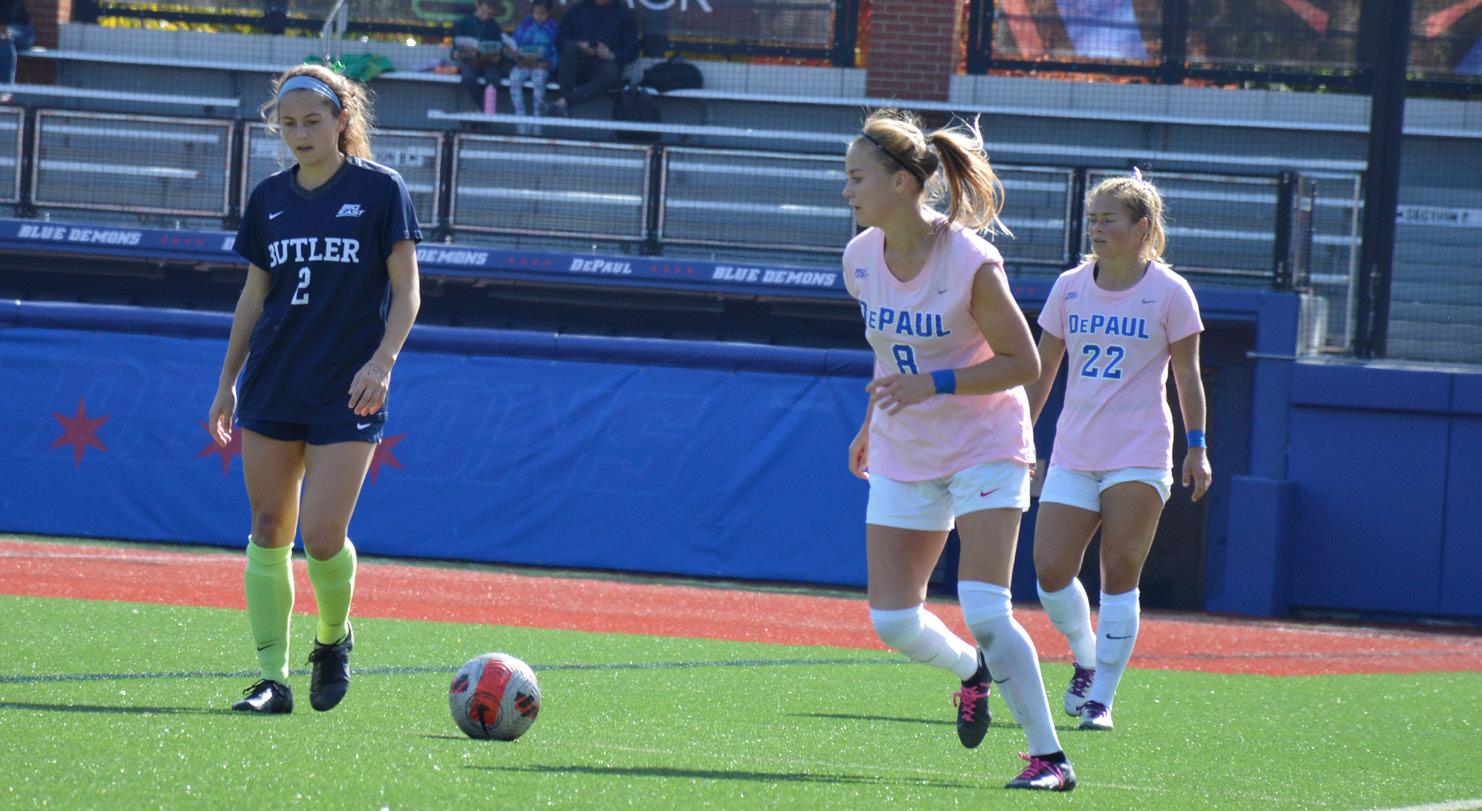
“It was physical for sure, but all these games are,” Herbek said. “A little bloody
nose never hurt nobody.”
Herbek only left momentarily after the collision and ended up playing 88 of the 90 minutes in Saturday’s game.
While DePaul played a stellar game de fensively, the squad as a whole made several mistakes, particularly in the second half.
Against Georgetown’s relentless high pressure, the Demons made repeated mis takes with possession in the middle third of the field.
In the game’s 47th minute, errors like these finally gave way to a Hoya goal. Georgetown junior forward Marlon Tabora took advantage of DePaul’s sloppy play and secured possession down the left side for a breakaway, beating sophomore goalkeeper Ghandi Cruz with a chip shot over Cruz’s head to tie things at 1-1.
The goal proved to be the only time Georgetown could beat Cruz and DePaul’s back four, as the Blue Demons went back to stifling the Hoya attack. For the remainder of play, DePaul made continued impressive efforts on defense, including an athletic div ing save by Cruz in the 79th minute to keep the score knotted up.
“Gandhi [Cruz] made a couple of great saves to keep us in the game, but other than that, their chances came pretty few and far between,” Herbek said.
Herbek’s head coach echoed praises of DePaul’s defensive efforts in Saturday’s draw.
“I’m proud of our guys for stepping up and executing our way,” Plotkin said. “As a whole, we defended as a unit. It wasn’t just one guy doing everything. I’m proud of how compact, organized, and disciplined we were everywhere.”
DePaul (3-3-5, 0-1-3) will look to clean up mistakes and keep the goal-scoring go ing as they travel to Queens, New York, for a matchup with St. Johns (3-6-3, 1-2-2) on Wednesday. Following the matchup with the Red Storm, they will return home to Wish for a Matchup with conference leader Xavier (8-0-4, 2-0-3) on Saturday, Oct 15.
“We’ve figured out how to use our ro tation, and now it’s just continuing to build that chemistry in the final third,” Plotkin said. “The hardest thing to do is score goals, and we just have to keep going after it.”
Penalty kick costly for Blue Demons in 2-1 defeat to Butler
By Max Rayman Contributing WriterLooking to earn their first con ference win of the season, DePaul’s women’s soccer team continued a theme they had been showcasing all season long: suffocating defense. Against a But ler Bulldogs team that, entering Sunday, had outshot opponents 201 to 102, DePaul weathered the storm.
From the first whistle, Butler dominated time of possession, pep pering shot after shot. Graduate senior goalkeeper Mollie Eriksson and her defense stood tall, blocking eight shots on nine attempts. Butler’s lone goal of the first half came at the 43:46 min ute mark, thanks to junior midfielder Anna Schroeder. After a corner kick by sophomore midfielder Sara Trandji, junior midfielder Arianna Jalics headed it, setting up Schroeder’s goal.
Despite being outshot 8-1 in the first half, DePaul had multiple chances but found themselves unable to capi talize. Unfazed, the Blue Demons stuck with their defensive game plan and were finally able to find an opening. At the 58:43 mark, sophomore forward Katie Godden capitalized off of a deflection, tying the game at 1.
“Someone just crossed it in,” God den said. “There was a scramble in the box, and I just put my laces through it, and it went in.”
Butler has been one of the best teams in the Big East this season at drawing fouls, finding a way to get under their opponent’s skin. Entering the match, Butler’s opponents had been called for 141 fouls compared to only 106 on the Bulldogs. Butler was able to put this ability to good use late in the second half, drawing a penalty kick at the 66:35 minute mark. Redshirt junior
forward Abigail Isger buried it, giving Butler a 2-1 lead.
“You have got to keep your compo sure and not feed into it,” head coach Michele O’Brien said. “I don’t know if we did a great job of that today. We kind of gave in to what they wanted us to do. It eventually catches up with you.”
From there, DePaul was unable to find an equalizer, falling short 2-1, losing their fourth straight game by one goal.
In the first half, graduate senior El lie Mink was helped off the field by her
team due to a leg injury. Thankfully, she was able to return in the second half.
“I’m not exactly sure what hap pened,” O’Brien said. “I think she got kicked in her ankle and then rolled it. A sprain. I don’t know the severity of it. Coming off surgery on her ankle, that was a scare, but she was able to regroup through halftime.”
This game was somewhat of a reunion for sophomore forward Susie Sodderstrom, with her older sister, redshirt senior midfielder Katie Sod derstrom, lined up across the pitch. The two were only teammates in high school for a year, and this marked the second and last time they faced off in college.
“Before the game, I gave her a hug,” Sodderstrom said. “I haven’t seen her in a while. A lot of sibling rivalry. We are both forwards so we don’t really play against each other. But on the plays where we are battling, each person is trying to get a poke on it. It is very fun and very, very competitive. It’s bragging rights.”
DePaul (2-10, 0-5) will be back in action on Thursday, Oct. 13 for a road matchup against their conference foe Connecticut (6-5-1, 2-3). First touch is set for 6 p.m. CDT.
Sports
Back in full swing
DePaul basketball unites with fellow Chicago teams at Tip-off Luncheon
By Preston Zbroszczyk Asst. Sports EditorCoaches Tony Stubblefield and Doug Bruno and DePaul basketball players rep resented DePaul at Thursday’s Chicago land Media Tip-off Luncheon.

Hosted by ABC7’s Dionne Miller, this was the first year the Chicagoland Lun cheon took place at the Chicago Sports Museum at Water Tower Place.
Northwestern, Chicago State, UIC and Loyola attended as well.
After teams arrived and spoke to the media, coaches sat in high rise chairs as Miller asked them questions about the teams’ upcoming plans for the season.

This is not the first year Chicago bas ketball was united, but it is something Stubblefield hopes happens every year.
“This is a great event,” Stubblefield said. “Obviously, Chicago is a great city. There are some great universities, and we see a lot of these guys in the course of the summer out on the road recruiting, but it’s good to all come together today for this luncheon.”
The expectations for both basketball programs are as high as they ever have been. Coach Doug Bruno plans for a re peat appearance in the NCAA Tourna ment. After last season’s 15-16 record and a 10th place finish in the Big East, the Blue Demons look to finish towards the top of the standings.
One of DePaul’s few seniors, center Nick Ongenda, talked about how the team has bought into Stubblefield’s brand of basketball in year two.
“I feel like year one, you know, he came in and did an amazing job,” Ongenda said. “But he came in, it was his first time in the position, so now in year two he’s go ing to be much more comfortable, much more ready to throw in what he needed to. From summer ball, we’ve seen so much improvement through the players and ob viously through the coaches too.”
As far as Bruno and his women’s team,
the hopes are to go further than the First Four in the NCAA Tournament. After last season’s early exit to Dayton, the Blue De mons improved their roster adding more depth and experience.
The Blue Demons plan to prioritize health, as they suffered a number of sea son-ending injuries that diminished the team’s roster.
Bruno brought in Anaya Peoples, a Notre Dame transfer who brings her years of NCAA Tournament experience and backcourt knowledge as a point guard. DePaul also plans to take advantage of Aneesah Morrow’s breakout season, giv ing her the chance to lead the team.
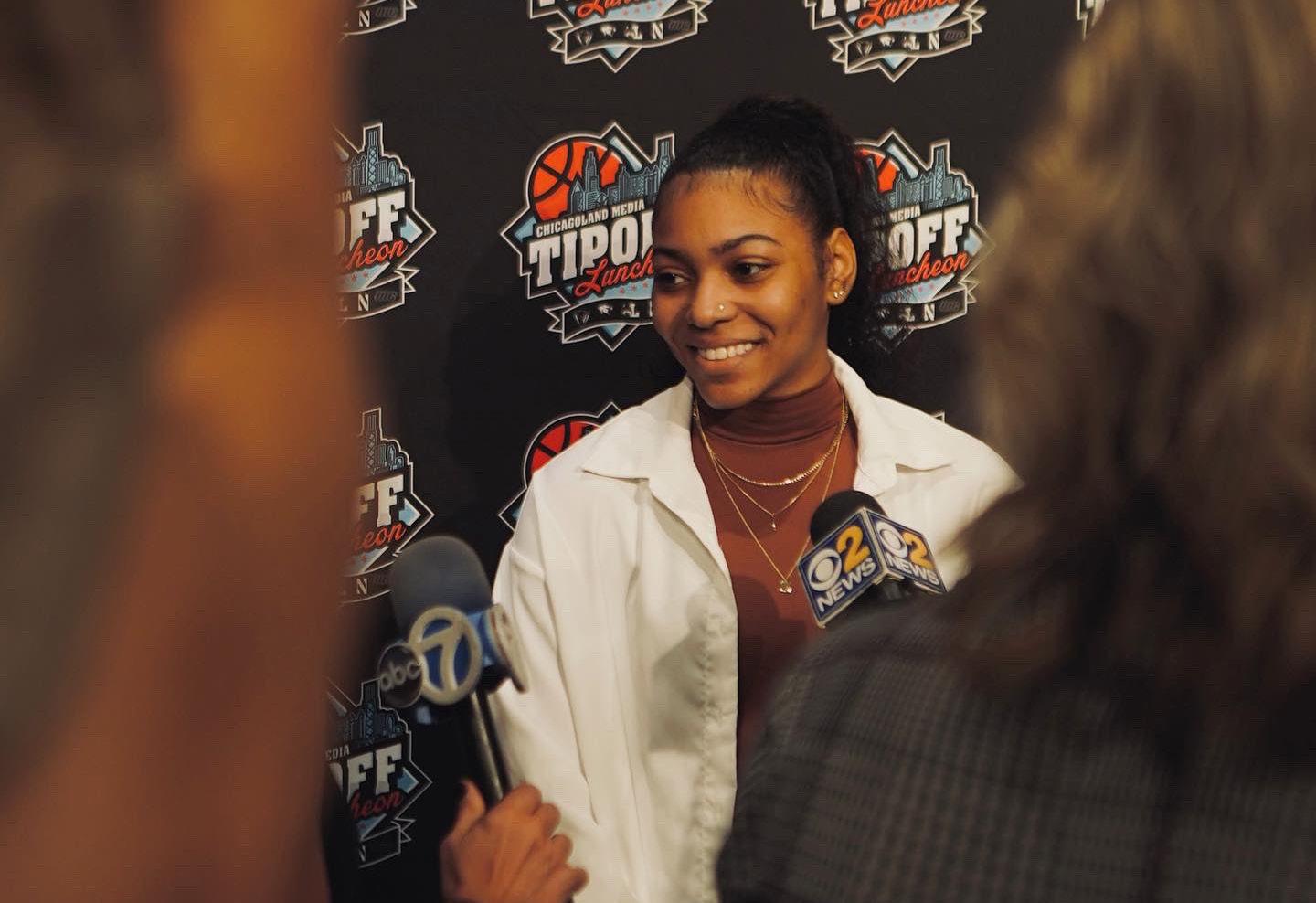
Recruiting for Stubblefield in year two has been even better. He has brought in experienced depth in the backcourt with transfer guards Umoja Gibson and Caleb Murphy. Stubblefield also landed guard Zion Cruz, his second four-star recruit since arriving at DePaul.
Both basketball programs will face Northwestern and Loyola this season, a Chicago tradition that hopes to continue.
Graduate student Javan Johnson, who only played 10 games last season and was limited, said the team has aspirations of competing far into this season.
“I want to make it to the NCAA Tour nament, that’s first and foremost,” John son said. “We really know the system this year. So [coach Stubblefield] doesn’t really need to teach us much. He can be more hands-on now, and won’t have to reiterate things.”
DePaul basketball is the most popular sport on campus, and the team makes an effort to connect with their fans and sea son ticket holders.
Events like Blue Madness will be mak ing a return to involve the DePaul com munity and get to know the teams. On Oct. 14, the preseason fan event will fea ture an outdoor court in the parking lot of Saint Vincent de Paul church. The com pletely free event for the public will have contests, food and t-shirt giveaways.
DePaul senior guard Kierra Collier gets interviewed by ABC7 news and CBS2 news during Thursday’s Chicagoland Media Luncheon. TAYLOR STAPLETON | DEPAUL ATHLETICS DEPAUL WOMEN’S BASKETBALL | TWITTER DePaul senior center Nick Ongenda gets interviewed by ABC7 news about the expectations for the Blue Demons basketball season during Thursday’s Chicagoland Media Luncheon. DEPAUL WOMEN’S BASKETBALL | TWITTER DePaul women’s head coach Doug Bruno talks to the media during Thurday’s Chicagoland Media Luncheon.